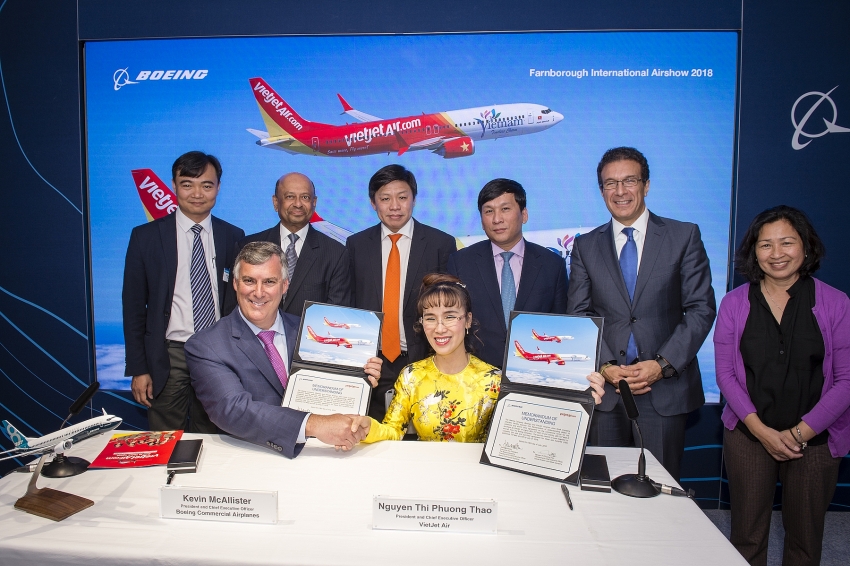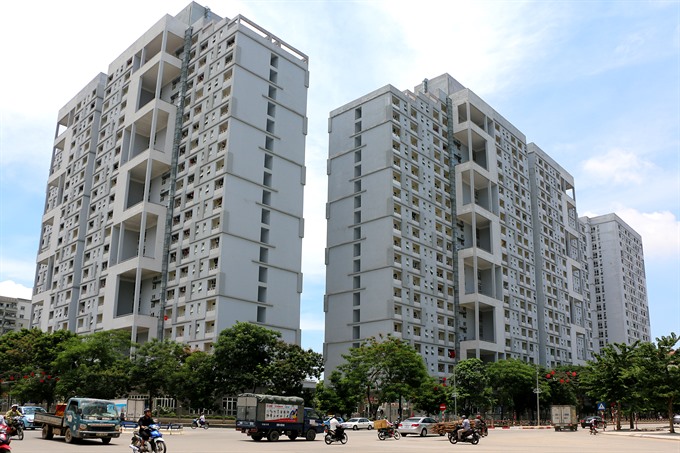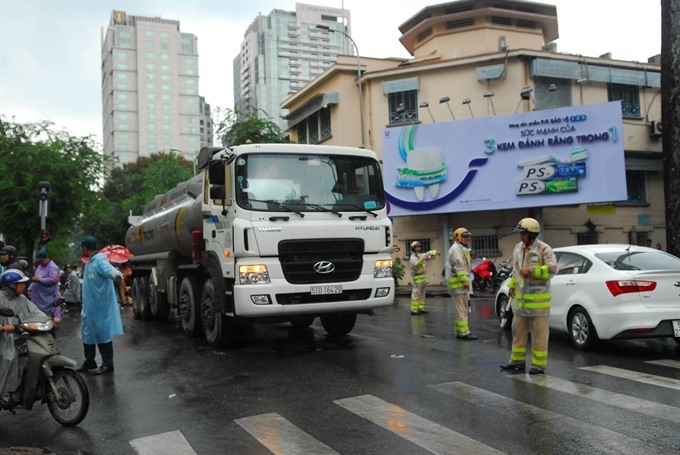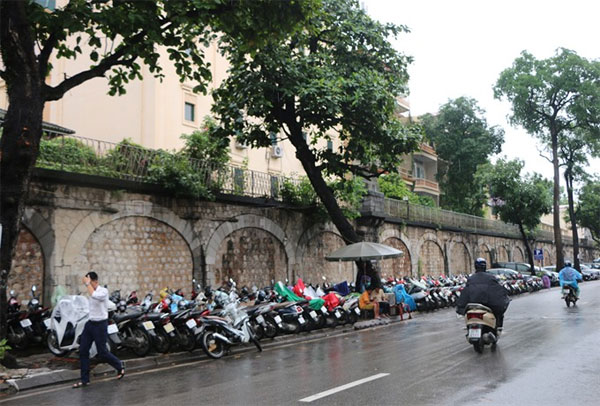Government News 19/7 Prime Minister receives Malaysian official 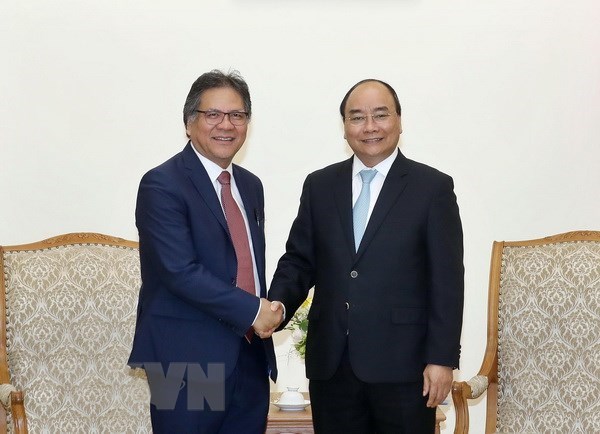 Prime Minister Nguyen Xuan Phuc (R) receives Dato Sri Idris Jala, Chief Executive Officer of the Performance Management and Delivery Unit of Malaysia on July 18 Prime Minister Nguyen Xuan Phuc received Dato Sri Idris Jala, Chief Executive Officer of the Performance Management and Delivery Unit (PEMANDU) of Malaysia, in Hanoi on July 18. At the reception, the Government leader welcomed the Malaysian official’s visit and valued the outcomes of his talks with Minister-Chairman of the Government Office Mai Tien Dung. Stressing the two countries’ close relations in ASEAN, PM Phuc said Malaysia is one of the major investors in Vietnam and boasts much experience in improving the investment and business climate. Dato Sri Idris Jala spoke highly of the PM’s speech at the freshly held Vietnam ICT Summit 2018, suggesting the Vietnamese side organise several international symposiums to acquire international experience, thus creating positive changes in reform and innovation. He expressed his hope to continue his contributions in order to witness Vietnam’s breakthrough developments in the future. PM Phuc affirmed that he will consult relevant ministries and agencies on the organization of symposiums on reform and innovation as mentioned by the Malaysian official. He appreciated experience of international organisations and countries, including Malaysia, in institutional reform. According to him, the most important thing is to act quickly to gain high efficiency in the fourth Industrial Revolution.- HCM City, JICA to meet quarterly to speed up projects 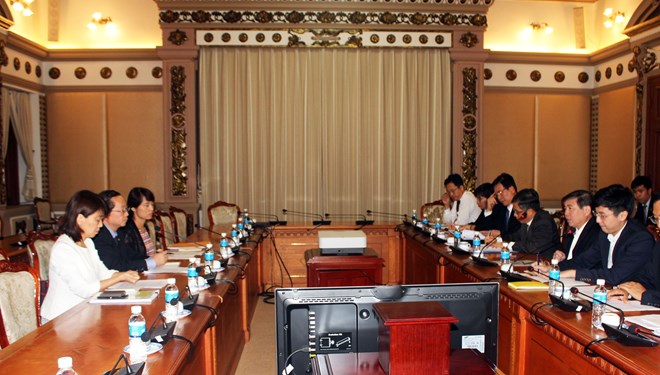 The meeting between leaders of HCM City and JICA Vietnam on July 18 Leaders of Ho Chi Minh City and relevant agencies have agreed to meet representatives of the Japan International Cooperation Agency’s (JICA) Vietnam Office every quarter to promote projects funded through Japanese official development assistance (ODA). This was reached by Chairman of the HCM City People’s Committee Nguyen Thanh Phong at a meeting with Chief Representative of the JICA Vietnam Office Tetsuo Konaka on July 18. Phong expressed his appreciation for JICA’s assistance in projects aimed at improving local infrastructure and people’s living standards, and asked it to continue supporting the city through development projects funded through Japanese ODA. Voicing concern about the progress of some ODA-funded projects – such as the metro line no. 1 (Ben Thanh-Suoi Tien) and the second phase of a water environment improvement project – he stressed that municipal authorities must pay attention to these projects and that he will inform JICA immediately when the National Assembly agrees to adjust the total investment capital for the projects, so that both sides can continue working together to ensure their progress. The official noted that HCM City considers the metro line no. 1 critical to the development of the local public transport system, so in case of any problems with the disbursement of corresponding capital from the central budget, the city will advance the funding for project implementation. It will also coordinate closely with JICA to prepare necessary procedures for other projects, he added. For his part, Tetsuo Konaka thanked HCM City for working closely with JICA and asked the two sides to enhance coordination to solve obstacles to their projects. He spoke highly of the financial advances provided from local budget for the metro line no. 1 project, pending the provision of corresponding capital from the central budget. He also called for further cooperation to finalise technical procedures to be submitted to the Vietnamese Government in order to prepare for the signing of agreements on the continuation of some projects funded through Japanese ODA in HCM City. PM looks to maintain high-level visits between Vietnam, Laos  Prime Minister Nguyen Xuan Phuc (R) and Vice Chairman of the Lao National Assembly Sengnuon Saynhalat (Source: VNA) Prime Minister Nguyen Xuan Phuc underscored the importance of maintaining regular high-level visits to strengthen bilateral ties during a reception in Hanoi on July 18 for Vice Chairman of the Lao National Assembly Sengnuon Saynhalat. The PM expressed his delight at the close and effective ties between the two legislatures, especially in performing law-making and supervisory roles, as well as external relations at regional and global parliamentary forums. He hoped that the two legislatures will support each other’s changes in mechanisms, policies, and laws to continue fostering political, diplomatic, national defence, and security ties. Both sides were urged to effectively carry out agreements between the two Parties and States, improve the efficiency of trade and investment cooperation, create favourable conditions for Vietnam’s projects in Laos; and ensure the ongoing progress and quality of projects. The two countries should step up economic connectivity, especially in transport and energy; improve education and training cooperation quality; and raise public awareness of the Vietnam-Laos special solidarity, especially among young generations, he said. Describing the new Lao NA House as an especially important project, the PM said Vietnam has issued special mechanisms and sped up its construction. He believed that with joint efforts, the work can be completed as scheduled and become a symbol of bilateral ties. Saynhalat, for his part, said his visit aims to reinforce ties between the two Parties, States, and legislatures, adding that the delegation has acquired Vietnam’s experience in coordinating with parliaments worldwide. The Vietnamese NA, and People’s Councils of various Vietnamese cities and provinces have offered practical support to Laos in diverse areas in the past years, he said. He thanked the Vietnamese Party, State, Government, and NA for building the Lao NA House as a gift. The guest pledged that although the world situation changes, the Lao Party, State, and people will always stand side by side with their Vietnamese counterparts, and wished that later generations would also continue to uphold these relations. Second ASEAN-India workshop on blue economy held  Vietnamese Ambassador to India Ton Sinh Thanh at the event The second ASEAN-India Workshop on Blue Economy took place in New Delhi on July 18, attracting over 60 delegates, including government officials, scholars, and researchers from ASEAN and India. As co-chairperson of the event, Vietnamese Ambassador to India Ton Sinh Thanh underscored the importance of blue economy in regional and global development, affirming that Vietnam and ASEAN member states consider maritime cooperation as one of the prioritised cooperation fields with India. Building on the success of the first workshop of its kind held in Vietnam’s Nha Trang city in November 2017, he urged delegates to raise specific proposals to foster blue economy cooperation within the ASEAN-India strategic partnership framework, as well as strengthen regional maritime connectivity. The diplomat expressed his hope that negotiations on the ASEAN-India maritime transport agreement would soon be concluded to ensure maritime security and safety, thus creating an environment conducive to sustainable development. Secretary (East) of India’s Ministry of External Affairs Preeti Saran affirmed that India appreciates its long-standing maritime link with ASEAN member states, adding that India will earmark 190 billion USD to boost connectivity between its seaports and 27 new economic development areas in the next decade. She invited ASEAN countries to consider joining the project, initially focusing on coastal special economic zones, investment consultation, maritime transportation, and tourism. Vu Thanh Ca from the Hanoi University of Natural Resources and Environment said Vietnam has taken actions to step up its blue economy such as strengthening coastal management, mitigating illegal fishing, improving lives of fishermen via job creation, poverty reduction, and ensuring social equality. Dr. Prakash Chauhan, Director of the Indian Institute of Remote Sensing, said India is effectively using remote sensing technology to support blue economy via weather and disaster forecasting, marine environment protection, and searching for waters suitable for fishing and tourism. Dr. Prabir from the Research and Information System for Developing Countries (RISDC) proposed strengthening connectivity, especially facilitating maritime transportation via the ASEAN-India seaport network; investing in sea infrastructure; developing coastal special economic zones; and improving connectivity plans. Participants shared the view that maritime security is crucial to developing blue economy, and proposed potential cooperation fields such as maritime connectivity, safety, and diplomacy. They hoped for more discussions about blue economy towards realising specific projects between ASEAN and India. The event was co-hosted by the Vietnamese Foreign Ministry, the Indian Ministry of External Relations, with the support of the Economic Research Institute for ASEAN and East Asia, the RISDC, and the National Maritime Foundation of India. Deputy PM Pham Binh Minh welcomes new Mozambican ambassador 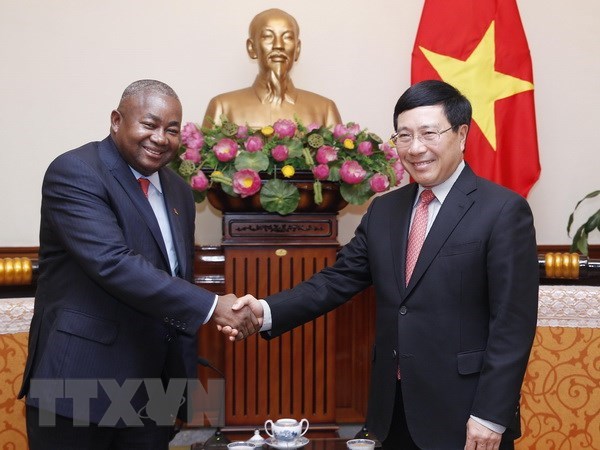 Deputy Prime Minister and Foreign Minister Pham Binh Minh (R) receives new Mozambican Ambassador to Vietnam Leonardo Rosario Manuel Pene on July 18 Deputy Prime Minister and Foreign Minister Pham Binh Minh received new Mozambican Ambassador to Vietnam Leonardo Rosario Manuel Pene in Hanoi on July 18. Deputy PM Minh reaffirmed that Vietnam attaches importance to developing relations with Mozambique, one of its key partners in southern Africa. He stressed that the Vietnamese Ministry of Foreign Affairs and other agencies will create the best possible conditions for the diplomat to fulfil his duties. At the meeting, host and guest discussed specific measures to enhance the two countries’ cooperation in such key areas as agriculture, telecommunications, education, and healthcare, as well as to expand bilateral ties in potential fields like transport, mining, and oil and gas. They also agreed to facilitate people-to-people exchange and business-to-business partnership. For his part, the new ambassador expressed his honour to work in Vietnam, adding that leaders of Mozambique treasure relations with the Southeast Asian nation and hope bilateral ties can be enhanced through various channels, including between their Parties, parliaments, and peoples. Mozambique hopes that political trust will be a foundation for connecting the two economies across the two continents, he noted. The diplomat pledged to make concerted efforts to strengthen the countries’ friendship, boost bilateral trade, attract more Vietnamese investment into Mozambique, and create favourable conditions for exchanges between the business circles and peoples of the two countries. Vice President reviews policy for war heroes in Quang Nam 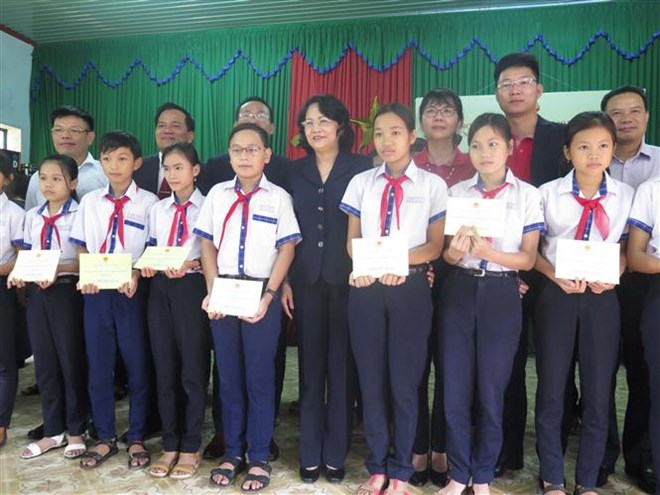 Vice President Dang Thi Ngoc Thinh in Quang Nam Vice President Dang Thi Ngoc Thinh held a working session with authorities of the central province of Quang Nam on July 18 about the enforcement of a policy for those who rendered their services for the nation, ahead of the 71st anniversary of the Day of War Invalids and Martyrs (July 27). She hailed the achievements that Dien Ban town, and Que Son and Duy Xuyen districts have made in the past and asked them to rally public involvement in improving the material and spiritual lives of war heroes and other poor residents in the locality. The Vice President requested that the new rural development campaign should be made sustainable, while further attention should be paid to Party and political system building, disaster prevention and control, as well as the “Studying and Following the Thoughts and Moral Virtue of President Ho Chi Minh” campaign. Meeting some of the disadvantaged children and war heroes in the area, she expressed hope that they would continue to uphold the revolutionary tradition and contribute to local socio-economic development. In Que Son district, she presented 10 houses worth 500 million VND (22,200 USD) to war heroes; gifts to 100 policy beneficiary families and poor households; 10 computers totally valued at 330 million VND to each of three local schools; and scholarships to 50 poor students with outstanding academic performances at Dong Phu secondary school. In Dien Ban town, she granted five houses worth 250 million VND, gifts to 300 poor families, and 50 scholarships to needy students. In Duy Xuyen district, Thinh handed over 420 million VND and 50 gifts to policy beneficiaries and poor households. On the occasion, she offered incense at the martyrs’ cemetery in Dien Ban town and at a memorial house dedicated to war hero Nguyen Van Troi. Deputy PM sends sympathies to China over flood consequences 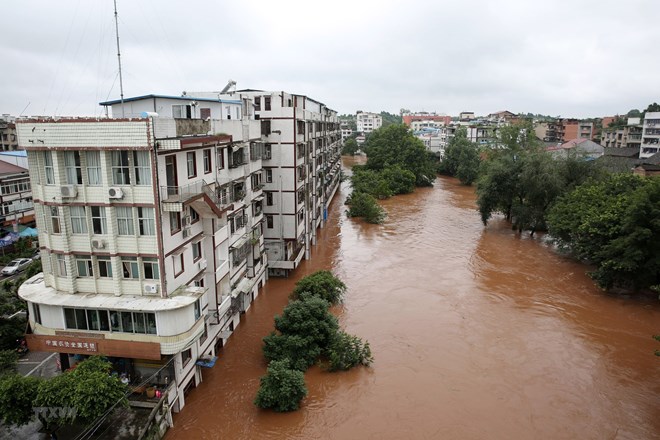 Flooding in Neijiang, Sichuan province, China (Photo: Xinhua/VNA) Deputy Prime Minister and Foreign Minister Pham Binh Minh on July 18 sent his sympathies to Chinese State Counsellor and Foreign Minister Wang Yi over serious human and property losses caused by recent floods in the country. Minh extended his deep sympathies and regards to Wang and people in regions hit by floods. He also expressed his belief that under the leadership of the Chinese Government, people in affected areas will soon overcome the consequences of the natural disaster, restore production and stabilise their lives. Torrential rain coupled with two typhoons have caused extensive flooding and landslides in Sichuan and Gansu provinces, affecting an estimated 2.9 million people. CPV delegation attends Sao Paulo Forum in Cuba, visits Dominica 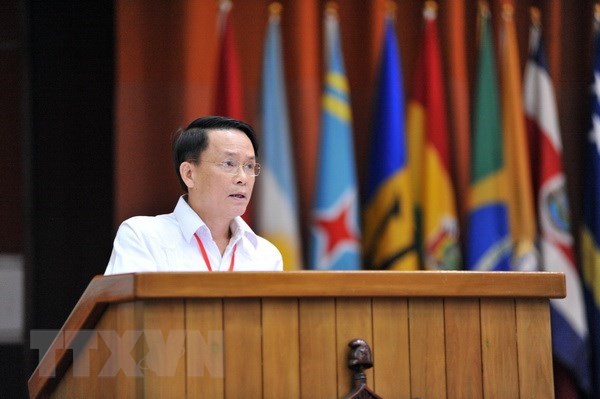 Nguyen Duc Loi, member of the Party Central Committee and General Director of the Vietnam News Agency, speaks at the 24th Sao Paulo Forum in Havana, Cuba A delegation from the Communist Party of Vietnam (CPV) led by Nguyen Duc Loi, member of the Party Central Committee and General Director of the Vietnam News Agency, attended the 24th Sao Paulo Forum in Havana, Cuba on July 14-17. The delegation took part in all activities of the forum and delivered a speech on late President Fidel Castro’s special relations with Vietnam at a special plenary session on July 17. On behalf of the delegation, Loi underlined that Fidel is a great leader of international communist and worker movements, and a symbol of revolutionary heroism, and aspirations for freedom and happiness. He highlighted that humanitarian internationalism initiated and led by Fidel had materially and spiritually supported many revolutions and movements for national liberation worldwide, including Vietnamese people’s resistance war against the US. The official recalled Cuba’s support to Vietnam in the past even when the Caribbean country was facing numerous difficulties as a result of the embargo imposed by the US, quoting Cuban revolutionary leader Fidel Castro’s saying that “For Vietnam, Cuba is willing to shed its blood.” He also recollected Fidel’s historic visit to Vietnam’s central province of Quang Tri in September 1973, the first trip by a foreign leader to a liberated area in Vietnam. During the trip, the Cuban Commander-in-Chief hoisted the Vietnamese liberation flag on top of a bunker formerly belonging to the enemy troops, and then urged the Vietnamese soldiers to “put up this glorious flag in the centre of Saigon.” His wish came true two years later. The forum attracted 625 delegates from 56 countries and 168 organisations across the world. They focused on discussing regional and international situations and emphasised the importance of gathering forces and devising measures to fight imperialists. Many Latin American and Caribbean leaders committed to reinforcing solidarity between leftist forces in the region and the world. They have adopted 45 resolution and statements on socio-political issues in the region. Created in 1990 as a result of the Permanent Conference of Political Parties of Latin America and the Caribbean, the Sao Paulo Forum is a space for dialogue, which attracts about 100 political parties, organisations and progressive movements in the region. During their stay in Cuba, the Vietnamese delegation also paid courtesy visits to Miguel Diaz-Canel, President of the Council of State and Council of Ministers of Cuba and Mercedes Lopez Acera, Politburo member and Secretary of the Communist Party of Cuba (CPC) Central Committee. They met with Jose Ramon Balaguer, Secretary of the CPC Central Committee and head of its Department of External Relations, and Victor Gaute, Secretary of the CPC Central Committee, who is in charge of the party’s information work. Earlier, the CPV delegation had a working visit to the Republic of Dominica on July 11-13. They paid a courtesy visit to President of the Senate Reinaldo Pared Pérez, who is also general secretary of the Dominican Liberation Party (DLP), and held talks with General Secretary of the United Left Movement of the Dominican Republic (MIU) Miguel Mejía. They met with Dominican Foreign Minister Miguel Vargas and attended a meeting honouring President Ho Chi Minh in East Santo Domingo city. VNN |
Article 1
↧
↧
Article 0
Vietjet and Boeing ink deal for 100 new aircraftAt Farnborough International Airshow 2018, the new-age carrier Vietjet and Boeing Commercial Airplanes signed an order contract for 100 B737 MAX aircraft worth $12.7 billion.
Vietjet CEO Nguyen Thi Phuong Thao and Boeing Commercial Airplanes CEO Kevin McAllister represented each side for the signing of this landmark contract at one of the world’s premiere aviation events. Vietjet’s new order will focus on developing the airline alliances across the Asia Pacific region and worldwide, and further enhance the airline’s fleet synchronisation, modernisation and fuel efficiency up to 2025. The deal is also expected to increase bilateral trade turnover between Vietnam and the US, the home of Boeing. “We are honoured to deepen our strong partnership with Vietjet as they become our newest 737 MAX 10 customer. Today’s agreement for a repeat order from Vietjet validates the best-in-class capabilities of the 737 MAX family of airplanes,” said McAllister. “With this agreement, we take another major step in growing our partnership with Vietjet, one that continues to contribute to the trade relationship between Vietnam and the United States. This agreement also grows Boeing’s presence and partnerships across Asia Pacific, developing win-win partnerships in a region with tremendous development potential.” As part of this contract, Boeing Commercial Airplanes has committed to deploying a series of strategic partnership programs to develop modern aviation service ecology in Vietnam, inclusive of Maintenance, Repair & Overhaul (MRO), training for pilots, technicians, engineers, and more, as well as special programs for enhancing the management and automation capabilities for airlines in Vietnam and the Vietnam aviation industry as a whole. Vietjet is Vietnamese first airline running as a new-age airline with low-cost and diversified services to meet customers’ demands. It provides not only transport services but also uses the latest e-commerce technologies to offer various products and services for consumers. Vietjet is a member of the International Air Transport Association (IATA) with the IATA Operational Safety Audit (IOSA) certificate. The airline was listed as one of the Top 500 Brands in Asia 2016 by global marketing research company Nielsen and the “Best Asian Low Cost Carrier” at the TTG Travel Awards 2015, which compiles votes from travelers, travel agencies and tour operators in throughout Asia and Asia’s Best Employer Brand by the Employer Branding Institute and World HRD Congress for many years. The airline was also rated as one of the top three fastest growing airline brands on Facebook in the world by Socialbakers. Currently, Vietjet features a fleet of 60 aircrafts, including A320s and A321s, and operates more than 385 flights each day. It has transported more than 60 million passengers on a network featuring 93 routes in Vietnam and across the region including Thailand, Singapore, South Korea, Taiwan, Hong Kong, Mainland China, Malaysia, Indonesia, Myanmar and Cambodia. In the long-term plan, the airline will expand its network across the Asia Pacific region. |
↧
Article 2
BUSINESS NEWS IN BRIEF 20/7 PM calls for more measures to reduce logistics costs  Prime Minister Nguyen Xuan Phuc has signed a directive on reducing logistics costs and connect the transport infrastructure system. The directive noted that the Government leader approved an action plan to increase competitiveness and develop logistics services in Vietnam until 2025 on February 14, 2017. After more than a year of implementation, offices and units have exerted efforts to achieve set targets. However, the transport infrastructure system has developed unevenly, while links between modes of transportation have remained ineffective. Logistics centres to connect Vietnam with other countries have yet to be built, leading to high logistics costs, harming the competitiveness of the Vietnamese economy. To cut logistics costs and promote the connectivity of the transport infrastructure system, the Prime Minister asked ministries, sectors and localities to focus on six main task groups under the action plan. The task groups are: completing policies and laws on logistics services, increasing the quality of logistics infrastructure, improving the capacity of enterprises and quality of services, developing the logistics market, increasing the quality of human resources and raising public awareness of the importance of logistics services. The Government leader assigned the Transport Ministry to tweak legal documents, reform administrative procedures, cut business conditions, simplify inspection procedures and intensify connectivity between modes of transportation. The ministry was also urged to speed up the restructuring of the domestic transportation market by reducing the market share of road transportation and increasing the market shares of sea, railway and internal waterway transportation. The PM requested the Ministry of Industry and Trade to continue working with related ministries and sectors to complete policies attracting investment in logistics infrastructure, and develop logistics infrastructure in combination with e-commerce. The Ministry of Planning and Investment was ordered to draw investment in key logistics centres. Indian, Vietnamese leather companies seek stronger ties A visiting delegation of 30 executives from Indian leather companies have met with their Vietnamese counterparts in HCM City. The meeting on Thursday between two of the world’s top three footwear producers was organised by the Indian consulate in HCM City and the Viet Nam Leather Footwear and Handbag Association (LEFASO) in HCM City. The visitors, led by India’s Council for Leather Export, became acquainted with their Vietnamese counterparts and showcased their products as they sought potential partners. Diep Thanh Kiet, deputy chairman of LEFASO, said Viet Nam’s exports of footwear and handbags were worth US$17.96 billion last year, and this year’s target is $19.5 billion. The country is the second largest exporter of footwear, he said. Viet Nam imported around $92 million worth of leather from India last year, or 5 per cent of its total leather imports. It plans to import $115 million worth this year. Dr K Srikar Reddy, the Indian consul general in HCM City, said: “Indian companies’ interest in investing in and co-operating with Viet Nam is constantly rising.” Leather is one of India’s major industries. It is the fifth largest exporter of leather, accounting for almost 13 per cent of the world’s output. According to India’s Ministry of Commerce and Industry, the country imported around $121.63 million worth of footwear and other leather goods from Viet Nam from April 2017 to March 2018. Viet Nam imports around 60 per cent of the leather it requires for footwear production, which offers potential for strengthening the partnership between the two countries, Reddy said. Villa, house supply in HCM City cannot meet demand Supply in HCM City’s new villa and townhouse segment has been too low in recent months to meet demand and prices have been rising as a result. In May Phu Long Property Company held the second phase of sales of its Dragon Village project in District 9. The 21ha project has over 400 houses and 300 villas, all of which were sold within two hours, it said. The US$2 billion Van Phuc City in Thu Duc District has also been in high demand. Nguyen Huong, general director of Dai Phuc Lan, the developer, told Dau Tu (Investment Review) newspaper that nearly 300 houses have been sold so far. Dang Phuong Hang, managing director of CBRE Vietnam, told Viet Nam News that supply is limited due to a shortage of land. In the first quarter of this year only four projects entered the market with 635 houses and villas, one each in districts 2, 9, Binh Chanh, and Thu Duc. Projects elsewhere have only condos and not villas and townhouses, she said. She attributed the high demand to the Vietnamese preference for houses rather than apartments. A report from market researcher JLL Vietnam said in the second quarter of this year new villa and townhouse supply topped 1,550 units, with the latter accounting for 73 per cent. Two-thirds of the townhouses were priced at $350,000-550,000. JLL said 1,483 units have been sold, and another 1,900 are expected to be added in the second half of this year, mostly in districts 9, 2 and Go Vap. It said there is a shortage of villas and townhouses both in the primary and secondary markets due to a scarcity of land in prime locations. Tran Duc Vinh, general director of Tran Anh Group, said last year his company built 400 villas and houses and sold them in quick time. The market has looked up since 2015 and incomes have improved, adding up to increased demand for villas and townhouse, he said. But since not all developers can build them, demand is constantly unsated, he said. Researchers said villa and townhouse prices have increased sharply due to the short supply. In districts 2 and Go Vap, prices are up by 80-150 per cent this year. In districts 7, Binh Thanh and Nha Be District, they are up by 5-10 per cent. Lilama to withdraw all capital from Sông Vàng Hydropower The Viet Nam Construction and Machinery Installation Corp (Lilama) has decided to withdraw all capital from Song Vang Hydropower JSC (SVH). Under the plan, Lilama will withdraw 7.9 million shares by order matching and settlement on the Unlisted Public Company Market (UPCoM) trading floor. The divestment plan is expected to be conducted in the last six months of 2018. Da Nang-based SVH was established in 2004 by three shareholders of Lilama, PetroVietnam Power Corporation (PV Power) and Civil Engineering Construction Joint Stock Company No 586. In the first quarter of 2018, SVH’s revenue reached VND19.2 billion (US$842,000) and after-tax profit was more than VND7.57 billion, down 8.5 per cent and 13.3 compared with the same period last year, respectively. SVH attributed the fall in revenue and profit in Q1 this year to the decrease in the water volume flowing into the company’s lake, due to unfavourable weather in the central region. Siemens signs deal with VN solar plant Siemens has won a contract to supply electrical equipment for the country’s largest solar plant, which is being developed by Trung Nam Group in the south central province of Ninh Thuan. The deliverables include inverters, power and distribution transformers, gas-insulated medium-voltage switchgear, circuit-breakers and a monitoring and control system. The plant is the first solar project for Siemens in Southeast Asia. It will deliver up to 425 Gigawatt hours (GWh) per year once become operational. This is enough to supply approximately 200,000 households with electricity and saves around 250,000 tonnes of CO2, Siemens said in a statement. “Viet Nam’s need for energy is rapidly growing. To cover this demand, we must increase the share of renewables, among other things,” Nguyen Tam Tien, general director of Trung Nam Group said. “With a capacity of 204MW, Trung Nam solar power plant is the largest single plant of its kind in Viet Nam, thus making Trung Nam a true pioneer in solar energy in the country,” Siemens Vietnam president and CEO Pham Thai Lai. The plant is expected to begin operations by mid-2019. Seeking FiT hike for bagasse power The sugar industry is calling for increased feed-in tariffs for bagasse-fired power in hopes of luring additional investment to such renewable energy projects. Lam Son Sugar JSC – one of Vietnam’s largest sugar companies – hesitates to expand its current bagasse-fired power generation activities, as the firm has been making a loss of VND600 (2.5 US cents) for every kilowatt-hour (kWh) of electricity it sells to Electricity of Vietnam (EVN). A part of its integrated sugar production line, the company’s (Lasuco) bagasse-fired power generation system, designed with a capacity of 33.5 megawatts (MW), can generate more than 20MW at the peak of sugarcane crushing. Half of the output serves the sugar mills’ production, while the rest is sold to the national grid through EVN. The feed-in tariff (FiT) for bagasse-fired power stands at only 5.8 cents per kWh after an adjustment prompted by petitions submitted to the government. Meanwhile, the total cost for each kWh generated by the firm amounts to VND1,900 (8.3 US cents), Lasuco’s general director Le Van Phuong told VIR. “We are willing to increase our current bagasse-fired power output by doubling the power generation period from 150 days to 300 days per year, once the price for bagasse-fired power equals those set for other renewable energy sources like wind power and solar power,” said Le Van Tam, chairman of Lasuco. The benefits of bagasse-fired power generation to companies like Lasuco cannot be denied, as it provides electricity for sugar production and enables the firm to sell the redundant power output to the national grid. Additionally, the power generation helps handle the environmental impacts bagasse could have, as tonnes of bagasse were used as fertilizer in the 1990s, but were unpopular due to the unpleasant smell. Notably, Lasuco, with its environmentally friendly power generation, gained a carbon credit deal in 2012 at a price of 7.8 euros ($9) per tonne of CO2 under the Clean Development Mechanism (CDM). The deal, which lasts for 20 years, enables Lasuco to earn an additional income of some VND10 billion ($430.000) every year. Opportunities for boosting bagasse-fired power generation are abundant, as the combined sugarcane planting area of sugar mills nationwide amounts to 330,000ha, yielding at least 30 million tonnes of sugar cane a year. “Let’s imagine each tonne of sugar cane could generate 100 kWh of electricity; thousands of MW would be generated,” Lasuco’s Tam said. However, not many sugar mills could profit from such plans. Only nine of the 40 sugar mills across the country have poured money into bagasse-fired power capabilities, with a total installed capacity of 400MW, and only 100MW are sold to the national grid, said Vu Ngoc Duc from the Institute of Energy under the Ministry of Industry and Trade (MoIT). Insiders, sugar firms, and experts all blame the low FiT for blocking the rise of bagasse-fired power. Pham Quoc Doanh, chairman of the Vietnam Sugarcane and Sugar Association (VSSA), told VIR that the FiT of 5.8 cents for bagasse-fired power was fixed in an “unusual way”, as the price was proposed and determined after MoIT delegations made fact-finding tours to evaluate bagasse-fired power generation at sugar mills. MoIT officials called the bagasse-fired power generated by sugar mills a kind of co-generation, which allows sugar mills to benefit from producing electricity for their own production as well as selling the redundant output to the national grid. That is why bagasse-fired power must suffer the FiT of 5.8 cents, Doanh noted. “That’s unfair for bagasse-fired power as the FiT is much lower than the level of 7.4 cents set for power fired by other biomass materials such as straw or sawdust”. This is a waste of opportunities for bagasse-fired power to help in meeting Vietnam’s increasing electricity demand, Doanh lamented, asserting that it is a great pity that Vietnam has no power plants fired by straw or sawdust as of yet, regardless of the FiT of 7.4 cents. The chairman claimed that efforts should have been made to build bagasse-fired power plants in order to make full use of the available input materials. Bagasse-fired power has been treated unfairly in comparison with other kinds of biomass-fired power, Doanh went on to say. Hence, the VSSA submitted a petition to the Government Office and the MoIT last year to increase the FiT for bagasse-fired power, but no relevant feedback or directions have been given so far, Doanh added. “At a FiT of 5.8 cents, no one dares to make an investment in building bagasse-fired power plants which are self-contained and have no financial and technical linkages with sugar mills,” said Lasuco’s general director Phuong. Lasuco still embraces bagasse-fired power, because the annual revenue [some VND40 billion ($1.76 million) per year] it brings can be used to make up for some costs of sugar production, Phuong added. Phuong assumed that such an investment turns feasible and profitable if the FiT rises to at least 7.4 cents – equivalent to the existing price of other biomass-fired energy sources. However, even this level would be rather low compared to the FiT of 10.8 cents set in Thailand. Adam Ward, country representative of the Global Green Growth Institute (GGGI) in Vietnam, said that an expansion of bagasse-fired power generation and biomass energy in general is needed to meet Vietnam’s electricity demand as well as to help the Vietnamese sugar industry further increase its competitiveness with overseas rivals, including those from Thailand. Ward said Vietnam needs to increase the current FiT for bagasse-fired power to a minimum of 7.4 cents, to be consistent with other biomass energy sources, which would help smooth the progress of the market. In a bid to support the promotion of bagasse-fired power generation in Vietnam, the German Agency for International Cooperation (GIZ) has implemented the Climate Finance Readiness Programme over the past three years, a part of which GIZ and GGGI jointly carried out pre-feasibility studies of bagasse-fired power generation at five sugar mills. Nam Long corporates with Japanese Nishi Nippon Railroad in $306.5 million project Nam Long Group on July 14 signed the strategic agreement with Japanese investors joining in phase 1 development of Waterpoint Township in the southern province of Long An, a 45-minute drive from Ho Chi Minh City downtown. According to the agreement, Nam Long, Japanese investors - Nishi Nippon Railroad, TBS Group and Tan Hiep Investment Co Ltd will contribute to the total investment capital of VND6.9 trillion ($306.5 million) to implement phase 1 of Waterpoint Township with the estimated stake holdings of 50 per cent, 35 per cent, 10 per cent and 5 per cent respectively. This project will secure the sustainable development of Nam Long in the next 5-10 years. According to Steven Chu Chee Kwang, general director of Nam Long, this was one of the most significant milestones of the corporation, proving internal strength, the ability to develop the real estate ecosystem, the ability to unlock the land fund and attract investment capital of Nam Long. Kwang said that the preparation for Waterpoint has been carried out for almost 15 years, from land clearance and compensation process, to research, design and planning according to international standards. “The process takes into consideration the sustainability, the solutions for preserving the nature and protecting the local ecological environment, including the whole water surface and 50-metre wide natural vegetation corridor along the bank of the Vam Co Dong River. We strongly believe that Waterpoint will become one of the most desirable urban areas in the southern Vietnam,” he said. Toru Shigemizu, executive officer of Housing Business Division and deputy director of Nishi Nippon Railroad, said that so far, two sides have continuously partnered in five projects. “We strongly believe in Nam Long by the way they make its commitments to us in particular, and our customers in general. This sixth project of 165-hectare Waterpoint continues to be our cooperation in depth and width. Not only sharing the capital contribution, we will be working together to exchange experiences in real estate development, how to manage resident communities to create added value for the real estate market in Vietnam,” Shigemizu said. Waterpoint is located at the front of Provincial Road 830, extended from Duc Hoa town to Saigon - Trung Luong Highway and Highway No.1 and Ben Luc town. This project owns the important traffic knots of roadway, waterway and railway connecting directly Ho Chi Minh City and the Mekong Delta. Cushman & Wakefield, an international real estate consulting firm, has reportedly revalued the property value of the 165-hectare, which is equivalent to 45 per cent of the Waterpoint project (355ha). In phase 1, the Waterpoint development includes a central park of over 20ha, 17ha for university and international school, 3ha for healthcare services, and 2.5ha of accommodation area. MBLand Holdings comes under fire for sub-par premium apartments MBLand Holdings has promised to apply automatic parking technology in the basement floors of the Golden Field My Dinh project to increase parking slots, but has not followed up on its commitments, while the walls of several apartments were cracked a couple of months after being finished. Residents could move in to the thirty-storey Golden Field My Dinh building with 389 premium apartments on the corner of Nguyen Co Thach-Ham Nghi streets, South Tu Liem district, Hanoi from the first quarter of 2018. However, the local authorities have pointed out a number of violations of the fire code. Additionally, residents of the building complained about the quality of building, service fees, and compliance with the project design. According to a complaint letter of Golden Field My Dinh residents, the developer of this building has violated regulations of Decision No.1969/QD-UBND dated April 22, 2016. In essence, the communal area—including 6,775 square metres of parking area in the three basement floors, 315sq.m of community living room at the fourth floor, and 14,655sq.m of traffic and technical support for the whole building—should be under joint ownership. However, in the purchase contract between the developer and residents, all of these areas have been determined to belong to MBLand. Also according to Decision 1969, MBLand has to develop resolutions of automatic parking to increase parking space. However, the developer has yet to do so, while the building has already been put into operation, and the number of residents has been increasing. This makes residents worry about a potential overload at the basement parking lot. There are only 200 parking slots now, while the number of apartments is 389. Pham Viet Cong, a resident of Golden Field My Dinh, told infonet.vn: “If the building does not apply automatic parking, there will not be enough parking slots for all, and the building cannot guarantee a slot for each apartment. We do not know why the developer has not complied with the decision of the Hanoi’s People’s Committee yet.” In last April, the fire department checked the building and detected numerous issues related to fire safety. The building did not pass the pre-acceptance test. Thereby, the agency has fined the developer and recommended all organisations, individuals, and households not to move into this unsafe building. Additionally, residents of Golden Field My Dinh also raised various problems in building quality. The walls of several apartments numbered XX12, XX18, and XX19 have been cracked, and the plaster is starting to break. Moreover, air from the ventilation system is directly discharged onto balconies and the corridor on every floor, instead of the designated discharge method. Corridors on all floors and basement floors lack fresh air, giving residents a feeling of suffocation. The quality of this building’s services is too bad. Corridors and elevators are always busy, the smell of garbage permeates residential areas as waste is not moved out regularly, and basement B1 still has construction waste. All these problems have been noted and sent to the developer and the local authorities via documents, but residents have not receive a response yet. The representative of residents said that if MBLand Holdings does not deign to issue feedback or resolve the issues after receiving the third complaint letter, they will resort to stronger action to claim their legitimate rights after they have spent billions of Vietnamese dongs for these “premium apartments.” Earlier, on May 9, another project of MBLand Holdings JSC, MB Grand Tower on Le Van Luong street caught fire. The fire started at the technical room and eight fire engines were sent to the scene. Fortunately, the tower had yet to be put into operation and the fire did not have any casualties. Foreign investors offered maximum 49 per cent stake in Cenland Foreign investors are offered a maximum of 49 per cent stake in Century Land JSC (CenLand), the first real estate brokerage firm listed on the Ho Chi Minh City Stock Exchange (HSX). This was announced by Nguyen Tho Tuyen, general director of Cenland, at the roadshow on July 3 to introduce investment opportunities in Cenland. Tuyen released that the firm will move the time to list 50 million shares to the third quarter of this year, instead of the middle of this month as initially planned. Accordingly, the reference price will be VND50,000-60,000 ($2.17-2.61). Cenland was founded in 2002 as an affiliated company of Century Group Joint Stock Company (Cen Group). The company now owns the Real Estate Project Supermarket System (STDA). In 2017 the company was reconstructed and acquired Worldstar Land JSC (nghemoigioi.vn), CEN SaiGon Real Estate Joint, and Rising Star Media JSC. In 2017, Cenland staged its initial public offering (IPO) and offered shares to increase capital in early 2018. Specifically, the company conducted three stock sales, increasing its charter capital from VND250 billion ($10.9 million) to VND500 billion ($21.8 million). At present, Cenland has two strategic investors namely VinaCapital and Dragon Capital with a total stake of 25 per cent. Previously, in April, two large foreign investment funds managed by VinaCapital and Dragon Capital have spent $21 million buying a 25 per cent stake in Cenland. Notably, VinaCapital, through Vietnam Opportunity Fund (VOF), bought 12 per cent for $10 million, while Dragon Capital acquired 13 per cent for $11 million. Cenland is currently prominent in the northern real estate brokerage market. The company is the pioneer in marketing Vietnamese real estate to foreign customers via its representative office. In 2017, the firm reported VND1.115 trillion ($48.39 million) in revenue and VND253.3 billion ($10.99 million) in net profit, doubling the figures of 2016. This year, Cenland set the target to earn VND1.67 trillion ($72.49 million) in consolidated revenue, up 50 per cent on-year, and VND320 billion ($13.89 million) in net profit, up 26 per cent on-year. VND1.326 trillion ($57.55 million) in revenue and VND238 billion ($10.33 million) in profit are expected to come from business operations in Hanoi. Haiphong backtracks on hasty promise to $800 million paper project Due to concerns about environmental pollution, the Haiphong Party Committee decided to withdraw its announcement related to the Haiphong People’s Committee’s support to Nine Dragons Paper (Holdings) Limited to develop a $800 million paper and pulp mill complex South Dinh Vu Industrial Zone. According to Le Thanh, Secretary of the Haiphong Party Committee, issuing the approval to Nine Dragons Paper (Holdings) Limited to develop the project right after the firm expressed its intention was a rushed decision by the Haiphong People’s Committee, drawing the public’s ire, according to diendandoanhnghiep.vn. Thus, the Haiphong Party Committee decided to withdraw the previous announcement and will organise a press meeting to issue an official opinion on the incident. Previously at a working session with leaders of the Haiphong People’s Committee on July 5, representatives of Nine Dragons Paper (Holdings) Limited outlined its plan to develop a complex, including a paper manufacturing factory and a pulp mill with a total investment capital of $800 million. The firm promised to equip the most modern manufacturing line, machinery, and wastewater treatment system for the complex. At the meeting, Chairman of the Haiphong People’s Committee Nguyen Van Tung agreed with Nine Dragons Paper (Holdings)’ investment plan and stated that after having the environmental impact assessment report approved by the Ministry of Natural Resources and Environment, the city will assign departments and relevant authorities to support the investor to complete procedures for the license. At the time, the leader of Sao Do Group, the investor of South Dinh Vu IZ, told local media that the group arrived to the IZ to study the investment place and stated that South Dinh Vu IZ would be an ideal place to develop the project. Responding to the concerns over environmental pollution, the representative of Sao Do Group stated that the US and Finland also lure paper and pulp mill projects. The problem is the technology installed at the mills. In case the investors affirm equipping the most modern technology meeting the 4.0 standard of the European Union for the projects, they will be approved to develop the projects. Vietnamese farm produce see big chances in Korean market Warm bilateral ties coupled with significant spending by the Republic of Korea on farm produce imports are creating great opportunities for Vietnamese exporters. According to Do Kim Lang, Vice Director of the Trade Promotion Agency under the Ministry of Industry and Trade, thanks to the Vietnam-RoK free trade agreement taking effect in December 2015, the RoK has become the third biggest trade partner of Vietnam after China and the US. In the first two months of 2018, Vietnam earned US$2.79 million from the RoK, up 44% compared to the same time last year. The Vietnam Embassy in the RoK said Vietnam holds strength in seafood and fruit-vegetable exports to the Asian country, an advantage given the country spends US$33 billion importing farm produce and seafood per year. The Trade Promotion Agency has organised trips for Vietnamese business delegations in the food industry to visit the RoK to carry out transactions and take part in local exhibitions and trade fairs. Two major retail firms of the RoK – K-holdings and Coupang – have reportedly sent representatives to Vietnam looking for product supply sources. The firms were interested in importing spices, instant noodles, packed products made of rice, frozen seafood, dried fruits, coffee, chocolate and cashew, among other processed food products. Kim Dae Youn, director of the food distribution section at Coupang, said apart from Vietnamese fresh tropical fruit, Korean consumers favour the country’s processed farm produce of the country. Coupang, a leading online shopping company of the RoK, will give a space in its website to introduce Vietnamese food. It aims to sell about 1,800 Vietnamese products online in 2019. Amid these opportunities, Vietnamese firms have focused on the strict quality standards demanded by the market, particularly with processed food. Dinh Thi Anh Tuyet, Chairwoman of the Board at the VietED Group, said the Korean market is demanding with high standards, challenging Vietnamese companies. Small- and medium-sized companies see this as a big challenge, as they lack capital, technologies and human resources. Le Huy Bay, head of a company processing farm produce, said his start-up is a couple of years old and still faces lots of difficulties. He said the company is confident of its dried fruit quality but packet design remains unattractive, adding that it has not been able to learn about consumer demand and other market information in the RoK. He suggested communications agencies offer information on the market and Korean businesses for local companies. Vietnam a ‘transit stop’ for China-bound exports of Thai fruit Vietnam’s impressive fruit export revenue in the first half of this year adds little value to the country’s economic growth as most of the shipment were re-exports of produce from Thailand. Vietnam raked in some US$2 billion from exporting vegetables and fruits in H1/2018, a solid 20.3% increase from the same period last year, according to data from the Ministry of Industry and Trade. However, the majority of the export value was generated by temporary import for re-export of produce, mostly from Thailand. Re-exports are exports of foreign goods in the same state as previously imported, revenue generated from which is still counted as the country’s exports. As in Vietnam’s case, some Thai fruits were temporarily imported into Vietnam and then all exported to China. Particularly, Vietnam has imported US$266 million worth of Thai fruit in the first five month of this year, and the country’s fruit export to China in the same period was also US$266 million, according to the General Department of Customs. Four types of fruit have been imported to Vietnam and immediately exported to China, with the conditions of the shipment unchanged - fresh longan, durian, mango and dried longan. The re-exports were all done via the Huu Nghi international border gate in the northern province of Lang Son. Shipments of this kind, which go from Thailand to China with a ‘transit stop’ in Vietnam, are not subject to any duties in the intermediary country, according to Tran Bang Toan, a customs official at Huu Nghi international border gate. The re-exports are only charged with some fees and transport services costs. “This really adds insignificant value to Vietnam, which functions as an intermediary for the China-bound fruit exports from Thailand,” Toan said. Momentum for economic growth for the rest of the year In the first half of the year, Vietnam’s economy recorded impressive growth in comparison with previous years. The result is partly due to the government’s drastic measures to attain the year’s targets. Despite global economic uncertainty and possible inflation before the end of the year, Vietnam’s economy has seen encouraging signs. Vietnam’s economy is expected to continue growth momentum thanks to the government’s resolute determination and wise management, production recovery, and the advantages of new free trade agreements (FTAs). In order to attain Vietnam’s economic growth target of 6.7% this year, all sectors have to make the most of opportunities inside and outside Vietnam. The processing and manufacturing industry continues to provide the driving force. Minister of Planning and Investment Nguyen Chi Dung is hopeful about the Nghi Son Oil Refinery. “If we can put the project into operation, it will create a motive power. We need to promptly resolve problems and speed up progress on major projects.” Business indexes and the number of newly established enterprises show that Vietnam’s economy has prospered. The implementation of free trade agreements will create a new environment and motivation for investment. Minister of Industry and Trade Tran Tuan Anh said, “Markets of FTAs and preferential mechanisms with China, the Republic of Korea, Russia, and ASEAN have been better exploited. The target of 10% export growth in 2018 is feasible. Export revenue in the second half of the year should reach US$20 billion per month. It’s possible. If the National Assembly’s year-end meeting ratifies the Comprehensive and Progressive Trans-Pacific Partnership, we’ll have good conditions to attract investment and expand markets.” Foreign experts have made positive comments about Vietnam’s economic growth. Ousmane Dione, World Bank Country Director for Vietnam, said Vietnam's medium-term prospects continue to improve and GDP is expected to grow 6.8% this year. Eric Sidgwickl, ADB Director in Vietnam, said Vietnam’s rapid growth is due to many factors, including the expansion of manufacturing and export, higher domestic demand, strong foreign direct investment, and improved agriculture. Japan’s Nikkei said employment in Vietnam is at a record high. Vietnam’s Purchasing Managers’ Index (PMI) increased from 53.9 points in May to 55.7 points in June, while ASEAN’s PMI fell from 51.4 to 51 points. Vietnamese farm produce see big chances in Korean market Warm bilateral ties coupled with significant spending by the Republic of Korea on farm produce imports are creating great opportunities for Vietnamese exporters. According to Do Kim Lang, Vice Director of the Trade Promotion Agency under the Ministry of Industry and Trade, thanks to the Vietnam-RoK free trade agreement taking effect in December 2015, the RoK has become the third biggest trade partner of Vietnam after China and the US. In the first two months of 2018, Vietnam earned US$2.79 million from the RoK, up 44% compared to the same time last year. The Vietnam Embassy in the RoK said Vietnam holds strength in seafood and fruit-vegetable exports to the Asian country, an advantage given the country spends US$33 billion importing farm produce and seafood per year. The Trade Promotion Agency has organised trips for Vietnamese business delegations in the food industry to visit the RoK to carry out transactions and take part in local exhibitions and trade fairs. Two major retail firms of the RoK – K-holdings and Coupang – have reportedly sent representatives to Vietnam looking for product supply sources. The firms were interested in importing spices, instant noodles, packed products made of rice, frozen seafood, dried fruits, coffee, chocolate and cashew, among other processed food products. Kim Dae Youn, director of the food distribution section at Coupang, said apart from Vietnamese fresh tropical fruit, Korean consumers favour the country’s processed farm produce of the country. Coupang, a leading online shopping company of the RoK, will give a space in its website to introduce Vietnamese food. It aims to sell about 1,800 Vietnamese products online in 2019. Amid these opportunities, Vietnamese firms have focused on the strict quality standards demanded by the market, particularly with processed food. Dinh Thi Anh Tuyet, Chairwoman of the Board at the VietED Group, said the Korean market is demanding with high standards, challenging Vietnamese companies. Small- and medium-sized companies see this as a big challenge, as they lack capital, technologies and human resources. Le Huy Bay, head of a company processing farm produce, said his start-up is a couple of years old and still faces lots of difficulties. He said the company is confident of its dried fruit quality but packet design remains unattractive, adding that it has not been able to learn about consumer demand and other market information in the RoK. He suggested communications agencies offer information on the market and Korean businesses for local companies. G-bonds raise additional 4.6 trillion VND The State Treasury of Vietnam collected 4.6 trillion VND (197.8 million USD) in the latest Government-bond (G-bond) auction on the Hanoi Stock Exchange (HNX) on July 18. The auction looked to sell 6.5 trillion VND (279.5 million USD) worth of G-bonds in five-year, seven-year, 10-year, 20-year, and 30-year maturity. As much as 1 trillion VND (43 million USD) was mobilised from five-year bonds, with an annual interest rate of 3.45 percent, the same as that during the previous auction on July 11. Six bidders bought 50 billion VND (2.15 million USD) worth of seven-year bonds with an average yield of 3.85 percent, 0.42 percent higher than that of the auction on July 18. Bonds with 10-year maturity were sold for 1.2 trillion VND (51.6 million USD), with an annual yield rate of 4.46 percent, an increase of 0.03 percent from that of the July 11 auction. Meanwhile, 15-year bonds attracted 800 billion VND (34.4 million USD) with an annual interest rate of 4.76 percent, 0.03 percent higher than the figure recorded in the auction a week ago. As for 30-year bonds, 50 billion VND (2.15 million USD) was raised at an interest rate of 5.42 percent per annum, which is equal to that in April 24 auction. Meanwhile, a total 1.5 trillion VND (64.5 million USD) was mobilised from sub-session sales for five-year, 10-year, and 15-year bonds. There were no successful bids for 20-year bonds. From the outset of the year, the State Treasury of Vietnam collected more than 85.5 trillion VND (3.68 billion USD) from auctions through the HNX. Expos introduce electrical equipment, energy-saving products Nearly 200 domestic and foreign businesses have been showcasing their products at the 11th International Exhibition of Electrical Technology and Equipment (Vietnam ETE 2018) and the 8th International Exhibition of Energy Saving and Green Power Products and Technologies (Enertec Expo 2018) which both opened in Ho Chi Minh City on July 18. In his opening remarks, Deputy Minister of Industry and Trade Do Thang Hai said under the industrial restructuring plan for 2018-2020 with a vision towards 2025, Vietnam will promote the development of mechanical products and prioritise key sectors such as industrial and electrical equipment. The country also aims to attract investment in new, clean, renewable energy to ensure national energy security, achieve green growth-related goals, reduce the effects of climate change, and boost the development of other industrial sectors, he said. The plan has created a foundation for the development of electrical technology and green energy, he said, pointing to the potential of the power and electrical technology sector. Nguyen Phuong Dong, Deputy Director of the Ho Chi Minh City Department of Industry and Trade, highlighted the increasing demand for energy needed to serve production, business, and daily activities of local residents, citing the city’s power output in the first six months of this year at 12.32 billion KWh, up 6.25 percent year-on-year. With 300 booths, Vietnam ETE 2018 and Enertec Expo 2018 have been putting on display a variety of energy saving and green energy products, helping consumers select suitable eco-friendly solutions, he said. Both events will run until July 21. Expos introduce electrical equipment, energy-saving products Nearly 200 domestic and foreign businesses have been showcasing their products at the 11th International Exhibition of Electrical Technology and Equipment (Vietnam ETE 2018) and the 8th International Exhibition of Energy Saving and Green Power Products and Technologies (Enertec Expo 2018) which both opened in Ho Chi Minh City on July 18. In his opening remarks, Deputy Minister of Industry and Trade Do Thang Hai said under the industrial restructuring plan for 2018-2020 with a vision towards 2025, Vietnam will promote the development of mechanical products and prioritise key sectors such as industrial and electrical equipment. The country also aims to attract investment in new, clean, renewable energy to ensure national energy security, achieve green growth-related goals, reduce the effects of climate change, and boost the development of other industrial sectors, he said. The plan has created a foundation for the development of electrical technology and green energy, he said, pointing to the potential of the power and electrical technology sector. Nguyen Phuong Dong, Deputy Director of the Ho Chi Minh City Department of Industry and Trade, highlighted the increasing demand for energy needed to serve production, business, and daily activities of local residents, citing the city’s power output in the first six months of this year at 12.32 billion KWh, up 6.25 percent year-on-year. With 300 booths, Vietnam ETE 2018 and Enertec Expo 2018 have been putting on display a variety of energy saving and green energy products, helping consumers select suitable eco-friendly solutions, he said. Both events will run until July 21. French bank interested in Vietnam’s thermal power projects Societe Generale Corporate & Investment Banking (SG) of Singapore is particularly interested in sponsoring thermoelectric projects invested by the Vietnam Oil and Gas Group (PetroVietnam), an official from the bank said on July 19. Pascal Lambert, SG Country Head for Singapore and Head in South East Asia and India, shared the desire during a working session with Chairman of PetroVietnam Tran Si Thanh in Hanoi, during they discussed possibilities of cooperation between the two sides in the coming time. Lambert thanked support and cooperation from PetroVietnam and its members, which have chosen the SG as a partner to fund major projects of the Vietnamese group in recent years. The bank hopes to fund thermoelectric projects Nhon Trach 3 and 4, and Son My 1, he said, adding that the SG especially wishes to give consultancy on the issuance of international bonds for PetroVietnam and participate in the financing of commercial loans for projects. With its experience in financing gas thermal power projects in Japan, Indonesia, Malta, and Bangladesh, the SG hopes to share experiences with PetroVietnam in this field, he stressed. For his part, Thanh highly valued the cooperation between PetroVietnam and the SG in recent times, saying that the SG has provided capital to many key projects of the group, including the thermo-power project Song Hau 1, contributing significantly to PetroVietnam’s development. PetroVietnam would like the SG to continuously provide finance consultancy for the group and its subsidiaries in the projects to come, he said. Initiated in Vietnam in 1989 with two representative offices in Hanoi and Ho Chi Minh City, the SG has actively participated in funding major infrastructure and industry projects of Vietnam. It has cooperated with PetrolVietnam since 2007, providing loans for PetroVietnam Transportation Corporation (PV Trans) to build three 3 ships. In 2013, the SG joined other banks in the financing of Nghi Son Oil Refinery project. VNN |
↧
Article 1
Jardine Cycle & Carriage registers to acquire additional shares of Vinamilk Jardine Cycle & Carriage Limited Group is expecting to spend around VND2.4 trillion ($105.7 million) to become the largest shareholder of Vietnam Dairy Product JSC (Vinamilk - code: VNM), while F&N Dairy Investments continues to register an additional ten million shares of Vinamilk. 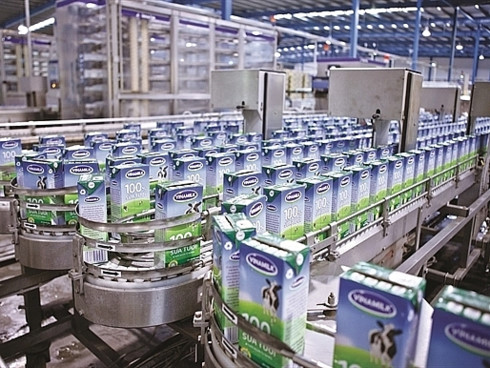 Foreign fund Platinum Victory recently announced it has successfully acquired over 129,000 VNM shares, raising its ownership of Vinamilk to 10.62 per cent. The fund has also registered to buy 14.5 million more shares of VNM, raising its ownership to 11.62 per cent. The transaction will take place between July 18 and August 16 via three methods of negotiation, order matching on the stock exchange, or transactions at the Securities Depository Centre. Platinum Victory expects to spend roundly VND2.4 trillion ($105.7 million) on this deal with the price of VNM shares at VND170,000 ($7.5). Platinum Victory is a fund of Jardine Cycle & Carriage (JC&C), a multi-industry regional business group. It began in 1899, selling everything from soap and screwdrivers to bicycles and later cars, expanding into Singapore in 1926. JC&C has some major subsidiaries, including Astra International (based in Indonesia) covering the automatic industry, finance, heavy industry, agriculture, logistics and real estate; and multinational corporation Direct Motor Interests which invests in the automobile sector in five countries including Vietnam, Malaysia, Singapore, Myanmar and Indonesia; as well as a number of others. In Vietnam, JC&C holds a 25 per cent stake of Truong Hai Auto Corporation (THACO) and 23 per cent of Refrigeration Electrical Engineering Corporation (REE). This movement of JC&C has been made while F&N Dairy Investments owned by Thai billionaire Charoen Sirivadhanabhakdi is repeatedly registering to buy VNM stocks. While F&N has owned Vinamilk shares since 2005, Platinum Victory only set eyes on the firm last November, spending around VND9 trillion ($396.5 million) on 48.3 million VNM shares (equivalent to 3.3 per cent). To date, Platinum Victory is the third largest shareholder of Vinamilk, owning 10.62 per cent. Talain Xavier Cany has been a representative of JC&C in Vinamilk's board of management since March. The second largest shareholder of Vinamilk is F&N Dairy Investments, owning more than 20 per cent. The largest shareholder is SCIC with 36 per cent. VIR |
↧
Article 0
Finance ministry drafts specific regulations for poor credit instutitions HÀ NỘI - Weak credit institutions in the process of restructuring and dealing with bad debts will be put under special control in accordance with the Law on Credit Institutions, according to a decree being drafted by the Ministry of Finance.
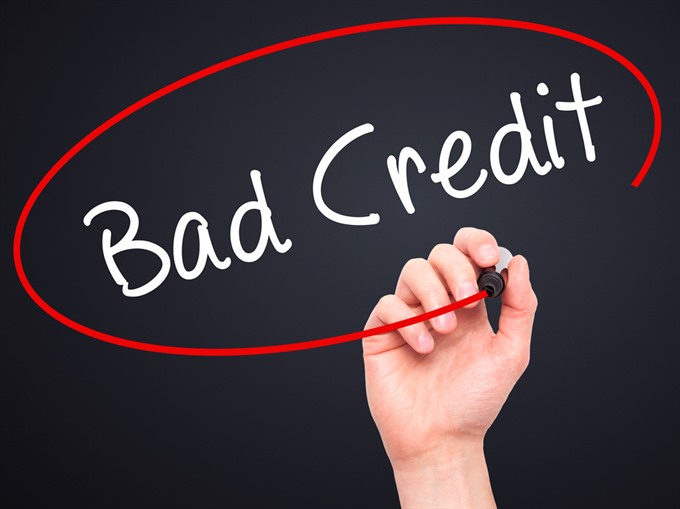 Poor credit institutions will use capital and assets under the restructuring plan approved by competent authorities in accordance with provisions of the law. — Photo loantap.in The draft decree, released to the public to gather ideas from relevant sectors, proposes some specific contents of the financial regime for weak credit institutions in the process of restructuring and dealing with bad debts. Poor credit institutions will use capital and assets under the restructuring plan approved by competent authorities in accordance with provisions of the law. In terms of turnover, revenues and turnover recognition of weak credit institutions will comply with the financial regime applicable to credit institutions, foreign bank branches and regulations on corporate income tax. For expenses, weak credit institutions shall make deductions for setting up risk provisions under Article 146 of the Law on Credit Institutions. Rewards for managers and labourers shall be equal to half of the average monthly salary where the institution fulfills the restructuring norms and tasks. The institutions must develop and publicise the regulations on rewards. The institutions will have to report to the State Bank of Việt Nam fully and promptly on the implementation results as well as financial difficulties and obstructions in order to develop plans to restructure and handle bad debts. They will also publicise financial statements according to the regulations of the central bank. VNS |
↧
↧
Article 2
BUSINESS NEWS IN BRIEF 23/7 Can Tho City seeks investment for 54 projects worth $5.4 billion  Can Tho City will call for VND124 trillion (US$5.4 billion) investment to finance 54 projects at a conference to be held on August 9-10. The new list, reviewed at a meeting on Tuesday, exceeds the initial target of a combined VND110 trillion set in May. Of the 54 projects, 44 are in the form of direct investment with an estimated value of over VND112.9 trillion. Among them, 22 have found investors who are already prepared to deploy VND82 trillion. The Mekong Delta City is seeking investment to become a service and hi-tech agriculture centre as well as an information technology hub. Can Tho is expected to introduce its strengths and investment policies during the conference under the theme of Sharing Potential for Mutual Development on August 10. Prime Minister Nguyen Xuan Phuc, along with 550 domestic and foreign delegates, is expected to attend the event. Discussions will be held on services, hi-tech agriculture and information technology. Some investment projects are expected to be awarded licences at the event and ground-breaking ceremonies for key projects in the area will be held. Last year, Can Tho attracted 77 foreign direct investment projects worth $656 million. Vinataba reports decreasing profit after giving up confectionery firms After earning plenty of money from divesting from Hai Ha Confectionery JSC and Huu Nghi Food JSC, Vietnam National Tobacco Corporation (Vinataba) reported a decrease in profit due to giving up these two confectionery firms. In March 2017, Vinataba registered to sell all of its 10,347,630 shares, equal to 51.74 per cent of the charter capital, in Huu Nghi Food. At the same time, the firm also registered to offload 8.4 million shares, or 51 per cent stake, of Hai Ha Confectionery. As a result, four individuals spent over VND824 billion ($35.9 million) to acquire the stake in these two confectionery firms. Notably, on March 17, Vu Hai spent VND155 billion ($6.75 million) on buying 3.9 million Hai Ha Confectionery shares and Nguyen Thi Duyen spent VND405 billion ($17.65 million) acquiring 8.37 million shares. On March 21, Nguyen Van Dung and Luu Thanh Tam bought a total of six million shares to own 20 and 10 per cent stakes in Huu Nghi Food, respectively. At the time, Huu Nghi Food’s shares were valued at VND44,000, thus, these two individual paid VND176 billion ($7.66 million) and VND88 billion ($3.83 million) for the sale. According to the forecast of the firm, in 2018 Vinataba's pre-tax profit may decrease by 27 per cent due to losing the profit from the two confectionery firms. The two share sales contributed a large part to Vinataba’s pre-tax profit of VND1.42 trillion ($61.87 million) in the first half of last year. However, the happiness only lasted for a short time because after completing the sales, Vinataba’s revenue fell. Notably, according to the company’s financial statement, in 2017 Vinataba reported VND25.68 trillion ($1.12 billion) in revenue, signifying a decrease of 3.91 per cent on-year. According to Vinataba, this excluded the business results of Hai Ha and Huu Nghi Confectionery. According to the forecast of the firm, in 2018 it may see a 27 per cent decrease in pre-tax profit due to losing the profit from the two confectionery firms. Vinataba was established in 1985. It is not only the largest cigarette producer in Vietnam, but one of the largest enterprises in the country. It is a state-owned holding group which, since June 2007, has been the only concern permitted to produce, import, and distribute cigarettes and cigars in Vietnam. In 2000, Vinataba cooperated with Japan Tobacco International (JTI) to produce the Mild Seven (Mevius) cigarette in Thanh Hoa Tobacco Factory (currently Thanh Hoa Tobacco Corporation). In 2001, the firm cooperated with British American Tobacco plc. to establish a $65 million joint venture company named British American Tobacco-Vinataba, to produce high quality tobacco fibre to stop fibre imports. The joint venture’s capacity is approximately 19,200 tonnes of fibre per year. The fibre factory officially came into operation at the end of 2004. Listed pharmaceutical firms told to withdraw drugs containing Valsartan Four of the eight companies that have been asked to revoke drugs made using the China-produced component Valsartan by the Drug Administration of Viet Nam are listed on the stock exchange. The companies are Domesco Medical Impor-Export JSC (Domesco), Cuu Long Pharmaceutical JSC, Central Pharmaceutical JSC 2 (Dopharma) and Pymepharco JSC. Valsartan is a raw material produced by the China-based Zhejian Huahai Pharmaceutical Company. It has been reported to contain a compound known as NDMA that can cause cancer. The latest order follows decisions made by the European Union Medicines Agency (EMA), Canada and several other countries to revoke all drugs containing Valsartan from the market. Domesco (DMC), Cuu Long Pharmaceutical (DCL) and Pymepharco (PME) are listed on the HCM Stock Exchange, while Dopharma (DP2) is trading on the Unlisted Public Company Market (UPCoM). DMC and DP2 ended Tuesday flat at VND82,900 (US$3.68) and VND9,100, respectively, while DCL and PME fell 0.7 per cent each to close at VND13,900 and VND70,000. HSBC launches app to track transactions HSBC has launched a tracker on its app that allows customers to track the real-time status of trade transactions wherever they are in the world and at any time of day. The mobile tool, the first of its kind in Viet Nam, provides customers with access to an overview of their import and export documentary credits and collections and payments across markets with just one click. “As an innovative mobile tool that allows businesses to better manage their global trade flows, the HSBCnet trade transaction tracker is a game changer for our corporate clients and partners,” Winfield Wong, country head of wholesale banking, HSBC Viet Nam, said. “Today, entrepreneurs and managers use mobile phones to run international businesses, and we know how important it is for them to keep track of their transactions along the supply chain in a very convenient, quick and secure way … to maintain their competitiveness.” The service is available to all trade customers registered for Instant@dvice. Customers using iPhones or Android devices can download the latest version of the HSBCnet Mobile app. Last May HSBC became one of the first banks to utilise FaceID technology to allow corporate customers to access mobile banking. Seminar pushes digital transformation The Viet Nam Information and Communication Technologies Outlook (VIO 2018) seminar to be held in HCM City on July 25 and 26 is expected to provide IT companies and businesses with an opportunity to connect and expand the market for Vietnamese ICT products. With the theme “Innovation in the digital era,” it will discuss digital transformation solutions designed for State agencies and micro-, small and medium-sized enterprises to operate effectively. Experts and businesses that have been successful in digital transformation will share their experience. Lam Nguyen Hai Long, chairman of the HCM City Computer Association (HCA), the event’s organiser, said VIO 2018 would also include a business-matching event for the first time to create opportunities for businesses to exchange information and explore possibilities for partnerships. “We will create a place for start-ups to introduce their products, and through this we want to promote products developed by micro and small enterprises as well as innovative businesses.” Vu Anh Tuan, HCA’s general secretary, said the event this year would be bigger and have many more activities than in previous years. Besides the main seminar, VIO 2018 would also feature a second conference titled “Smart City 360 Degrees”, a start-up talk-show on start-up trends and opportunities, support eco-system, investment funds and others, he said. Dr Doan Xuan Huy Minh of the Institute for Computational Science and Technology of HCM City said Smart City 360 Degrees, to be held by the HCA and his institute on July 26, would feature topics such as monitoring of water and air quality and warning systems, intelligent urban traffic control technologies and solutions, blockchain technology applications in smart city, and deep learning application for object detection and identification via real-time camera. VIO 2018 will also include the 2018 Top ICT Viet Nam awards ceremony on July 25 to honour outstanding IT and telecom companies, products, and services. The seminar, to be held at the White Palace Convention Centre in Phu Nhuan District, is expected to attract over 1,500 participants, including information and communications officials from HCM City and other cities and provinces, local and foreign ICT experts and business executives. China consumes 98% of Vietnamese longan output Vietnamese longans have been shipped to many countries in the world, most of them to China which consumed 98% of the total output. According to the General Department of Vietnam Customs, fruit and vegetable exports hit US$1.99 billion in the first half of this year, up 19.3% against the same period last year. Particularly, longan exports rose by 8.9% to US$124.76 million mostly to China, the US and Taiwan. The Import-Export Department under the Ministry of Industry and Trade forecast a bumper longan crop this year. Son La and Hung Yen are two largest longan growing provinces in the north. This year, Son La grew 12,257ha of longan trees, 7,826ha of which began to be harvested, and Hung Yen province has 4,340ha under longan, 4,200ha of which have been harvested. In order to help longan growers get a higher profit, a promotion campaign will be held from late July to the end of August by the Agro Processing and Market Development Authority (AgroTrade) and Hung Yen and Son La provinces to increase their sales and exports. Son La will launch the Safe Longan and Farm Produce week, a longan festival, an export promotion conference and a longan week in Hanoi. Especially, the province will hold a longan trade promotion conference in Pingxiang, Guangxi, China. Meanwhile Hung Yen will organize five major events to accelerate the consumption of its products including a Hung Yen longan festival and a longan week in Hanoi. Vietnamese dong caught between rising dollar, falling yuan Vietnam’s central bank has to engage in a delicate balancing act as the US-China trade war exerts inflationary pressures on the dong. As the trade war of duties and counter duties escalates, China has weakened its currency to boost exports making its goods even cheaper in Vietnam. Local economists have noted that while the yuan has lost 4.18% against the US dollar over the last two weeks, the Vietnamese dong has only lost a little above 1%, making Chinese imports much cheaper. Vietnam has to balance between keeping the trade deficit control and being able to compete with cheaper Chinese goods in the market. In the past three months, the yuan has fallen 3% against the dollar while Vietnam only devalued dong around 1.1%. And Vietnam should take precautions because the yuan could fall even further, financial expert Nguyen Tri Hieu said. “China has set the yuan’s foreign exchange rate at 6.95 per dollar,” he said. “But around two years ago, that number was even lower at 6.69 per dollar. So there is a potential for the yuan to slip further.” Hieu said he believes that if the government decides to devalue the dollar, a three percent drop by the end of this year is reasonable. Economist Ngo Tri Long, former director of the Market Price Research Institute under the Ministry of Finance, cautioned that that the central bank should adjust the dong’s exchange rate based on the market and not the yuan. “In my opinion, adjusting the dong’s value at the moment is a risky move, especially, with a 3% drop. “It is going to be hard to achieve the nation’s target of keeping inflation below 4% by the end of this year. Not to mention other future-factors we should take into consideration other factors like higher oil prices and damage caused by natural disasters.” But if Vietnam decides to move forward with devaluing the dong decision, the adjustments should be based on market demand and not on the yuan’s value. Long felt that a two percent drop would better match current market. On the other hand, president of Vietnam Institute for Economic and Policy Research Nguyen Duc Thanh stated that Vietnam should reduce dong’s currency exchange rate against the dollar and the yuan. However, such a move it would greatly affect many businesses, Thanh said. “This is a risky step since it will have ripple effects on many sectors like stocks and real-estate.” Asked how businesses can protect themselves from future foreign exchange fluctuations, Hieu recommended that businesses follow set contracts with fixed exchange rate. Commercial, office space rents continue to soar in Vietnam Businesses in Vietnam are facing difficulty in finding suitable commercial or office space as the rental rates have skyrocketed, especially in big cities. Not a few enterprises had to discontinue renting space in urban zones in Hanoi and Ho Chi Minh City due to the inflated rents, driven by rising real estate prices. According to a big real estate agency in Ho Chi Minh City’s District 1, rents for space on the metropolitan streets of the southern hub saw a rise of up to 30% from 2017. D.A., owner of a store for lease on Le Thanh Ton Street in the same district, told Tuoi Tre (Youth) newspaper that he leased his premises for VND85 million (US$3,655) per month. Tuoi Tre reporter observed that the landlord hung a for-lease sign, which reads VND65 million (US$2,795), for the same store just one month before. Meanwhile, just three kilometers away from Le Thanh Ton Street, a space of 150 square meters on Cach Mang Thang Tam Street in District 3, the second busiest thoroughfare in Ho Chi Minh City, is available for lease at VND80 million (US$3,440) per month without value-added tax. Not only commercial space, rents for warehouses and workshops in the city’s outlying districts are now as high as VND170 million (US$7,310) per month for a 2,500 square meter premises, up VND30 million (US$1,290) from the beginning of 2018. With rents constantly soaring, many people are still racing to find places for lease at reasonable prices for their small and medium businesses. However, rents for office in Ho Chi Minh City are expected to rise until 2020, as supply of new space won’t increase, while existing offices for lease in the city have been fully booked, according to the U.S.-owned realty consultant firm CBRE Vietnam. Availability rates of both grade-A and grade-B offices in Ho Chi Minh City are less than 5%, said Dang Phuong Hang, managing director of CBRE Vietnam. Likewise, data by real estate service provider Savills Vietnam showed that rental offices in the southern metropolis are being occupied at the rate of 96%. Savills Vietnam also anticipated that the rents for offices will continue to soar in the upcoming time. Industry insiders are concerned that the spike in space rents is a hint of a possible property bubble. Vietnam’s traditional retail confidence falls slightly in first quarter The retail confidence index (RCI) of traditional local retailers, such as grocery stores, slipped to 68 points in the first quarter of the year, down by one point year-on-year, according to Nielsen Vietnam. A report released by the market research company shows that the confidence of traditional grocery stores in the retail sector has remained low in the last two years, particularly in urban areas. Nguyen Anh Dung, executive director of the Retail Measurement Services at Nielsen Vietnam, explained that the average RCI is 100. An index exceeding 100 indicates optimism among retailers and vice versa. Therefore, the RCI of local retailers in the first quarter implies that they do not foresee a bright future for the domestic retail market. Retailers running traditional channels also voiced concerns over the spending habits of consumers and the number of consumers visiting their stores as well as the competitiveness of other retailers. In addition, they need help to win the support of consumers, noted Nielsen Vietnam. With more than 1.4 million stores throughout the country, the traditional trading channel in general has secured the top position in terms of the contribution to the revenue of the fast-moving consumer goods (FMCG) sector. This channel made up approximately 83% of the total revenue in urban areas, equivalent to nearly US$10 billion in the FMCG sector. The report on RCI is based on the results of direct interviews at more than 800 traditional grocery stores nationwide, which put a minimum of 30 product lines on sale, with the aim of gaining insight into the local retailers’ confidence, their primary concerns and their support for leading brands. Two foreign brands dominate personal hygiene market in Vietnam A Japanese and an American brand, Diana and Kotex, are enjoying the lion’s share of the fast-growing personal hygiene products market in Vietnam. Among the 10 most popular personal care brands in the country, Diana and Kotex hold a whopping 80% of the domestic market share. Unicharm, the Japanese company which owns the Diana brand, has been in Vietnam for 27 years. Diana brand products earned revenues of VND5 trillion (US$218 million) in 2016, up 10.6% over 2015, for a net profit of VND819 billion (US$35.7 million), making it the market leader by far. In second place is the Kotex brand, owned by the US based Kimberly-Clark Corporation, which reported revenues of VND4.9 trillion (US$214 million) in 2016, a year-on-year increase of 9%, for a net profit of VND485 billion (US$21 million). With a large proportion of young people in its population of 93 million, both brands expect the Vietnamese market for personal sanitation products to grow significantly in the coming years. Sharp decline in crude oil exports Vietnam exported 1.88 million tons of crude oil worth US$1.05 billion during the first half of this year, down 50.9% in volume and 31.4% in value against the corresponding period of last year, according to the General Department of Vietnam Customs. China was the largest importer of Vietnam’s crude oil, making up 26% of Vietnam’s total exports with 489,802 tons or US$272.07 million, down 63.9% in volume and 50.5% in value compared to the same period last year. Thailand came second, consuming 375,016 tons worth US$213.1 million, down 30% in volume and 2% in value. They were trailed by Australia with 340,258 tons valued at US$191.02 million, up 13.7% in volume and 60.7% in value. In general, exports of crude oil to most markets declined in both volume and value compared to the same period last year. Exports to Singapore suffered the most, dropping 73% in volume and 63% in value. However, exports to the US saw a sudden spike in growth, jumping 294.2% in volume to 132,671 tons and 382% in value to US$68.42 million. Vietnam Foodexpo coming to HCM City this November An International Food Industry Exhibition (Vietnam Foodexpo 2018) being held in Ho Chi Minh City this November is expected to attract about 450 exhibitors. The Trade Promotion Agency (TPA) will coordinate with relevant agencies to organize a series of events such as an international conference on the Vietnamese food industry, a seminar on investment promotion in the food processing industry and a Saigon international cooking contest. The TPA will also work with ministries and departments including the Ministry of Agriculture and Rural Development, the Ministry of Planning and Investment, trade offices and trade promotion agencies overseas, foreign embassies in Vietnam and world trade promotion organizations such as CBI, Business France, ITA, KOTRA, JETRO, AKC, ATPF, TAITRA, ITC and craft associations to invite trade partners and visitors to participate in the Expo. Thousands of direct trade connection activities will take place at the Expo’s pavilions, helping participating businesses to directly meet partners at the event. The Vietnam International Food Technologies Exhibition (Foodtech 2018) will coincide with the hosting of Foodexpo 2018. Both events aim to accelerate technology transfer and improve productivity and added value in Vietnam’s food processing industry by increasing the efficiency of trade promotion in the food industry. Vietnam Foodexpo 2017 drew more than 450 domestic and foreign exhibitors, showcasing their products across more than 600 pavilions. The four-day event lured around 15,000 commercial visitors, including approximately 3,000 foreigners from nearly 50 countries and territories and more than 9,500 domestic visitors. Over 3,000 contracts and investment and trade deals were reached at the expo. China’s BRI brings firms from Hong Kong to Vietnam Hong Kong companies are moving to Vietnam for investment and business purposes, capitalising on opportunities arising from China’s Belt and Road Initiative. Margaret Fong, executive director of the Hong Kong Trade and Development Council (HKTDC), said, “Hong Kong could be Vietnam’s partner in exploring new business opportunities arising from the Belt and Road Initiative (BRI). We believe that there are many things we can do together with Vietnam as Hong Kong is now focused on going international.” According to Fong, the HKTDC will host the In Style Hong Kong Expo in Ho Chi Minh City this September. The expo is a two-day B2B trade exposition, showcasing a wide variety of quality branded and designer-led lifestyle products from Hong Kong companies. In March, a delegation of 60 Hong Kong companies in the finance, legal, accounting, and infrastructure sectors also paid a working visit to Vietnam to seek business and investment opportunities. Hong Kong is looking to enhance investment and business collaboration with Vietnam under the BRI. “Hong Kong could be Vietnam’s partner in exploring new business opportunities arising from the Belt and Road Initiative (BRI). We believe that there are many things we can do together with Vietnam as Hong Kong is now focused on going international.” - Margaret Fong Hong Kong has recently hosted the third Belt and Road Summit which welcomed some 5,000 participants from 55 countries and regions. On the framework of the summit, Vincent HS Lo, chairman of the HKTDC, told VIR that there are many investment opportunities in Vietnam under the BRI. When starting to invest in the market, infrastructure such as power, railways, and highways, is the primary requirement. From infrastructure development, investment in other fields such as manufacturing, trading, tourism, and real estate will follow. Lo further noted that Vietnam needs to prepare and make certain changes to accommodate the new wave of foreign investment. It is important to have the trust that this investment will benefit the country. At the same time, Vietnam should provide some form of guarantee for the investment so that investors can see a return. As the sixth-largest economy of ASEAN, Vietnam is set to become a close economic partner of Hong Kong. In the near future, business ties between Hong Kong and Vietnam will strengthen thanks to the ASEAN-Hong Kong Free Trade Agreement, and the Investment Agreement signed late last year. From as early as January 1, 2019, Hong Kong and Vietnam will enjoy a freer flow of goods, services, and investments. “With the signing of the FTA and the BRI, there would be more room for Hong Kong investment in Vietnam and also the other way around,” said Edward Yau, secretary for commerce and economic development of the Hong Kong Special Administrative Region Government. “We also believe that Hong Kong can serve as a gateway for strong businesses between Vietnam and China. This would create more demand for professional services such as banking, insurance, construction, architecture, arbitration, and city development.” Indeed, Hong Kong has long been a conduit for trade and commerce between the Chinese mainland and the rest of the world, and this role is further strengthened under the BRI. As the commercial and investment hub of BRI, Hong Kong enjoys unique advantages to tap these opportunities. Given the territory’s many qualities, such as a common law system, independent judiciary, low and simple tax regime, advanced financial and investment infrastructure, extensive international networks with free flow of information, capital, and goods, Hong Kong can serve as an ideal platform for capital formation and financing for global investors. Nghi Son Refinery and Petrochemicals heading for insolvency Unless PetroVietnam contributes sufficient capital to its joint venture project, lenders will not disburse and Nghi Son Refinery and Petrochemicals LLC (NSRP) will default. In a document sent to the Ministry of Industry and Trade (MoIT), Vietnam National Oil and Gas Group (PetroVietnam) said that the group is facing many obstacles in the process of adjusting total investment and state capital contribution at Nghi Son Refinery and Petrochemicals project. “All the contribution capital parties are pushing PetroVietnam to complete its state capital contribution this July, as following this lenders will disburse the loans as commitments. Without the disbursement of the loans, the project will default,” vnexpress.net quoted a paragraph of the document. The Nghi Son Refinery and Petrochemicals project was approved on April 5, 2008 with a design capacity of 8.4 million tonnes of crude oil per year, and the total registered investment capital of $6.15 billion. In 2013, the project was issued a fourth amended investment certificate, raising total investment to $9 billion and charter capital to $2.4 billion, while total costs were identified at $9.2 billion, including $4.2 billion from owners’ capital contribution and $5 billion from loans. Being a wholly-state-capital group, PetroVietnam must comply with current regulations on management of investment and construction expenses. PetroVietnam asked NSRP to check and create amended total investment, however, several challenges exist related to differences between the old and new laws. The next challenge is how to disburse the remaining contribution capital from the state in the project. PetroVietnam has asked MoIT to guide this implementation. At the online summary meeting for the first half of the year, MoIT Deputy Minister Dang Hoang An said that the disbursement problem is complicated and MoIT will collect comments from ministries and agencies and report to higher levels. Nghi Son Refinery and Petrochemicals is situated in Nghi Son Economic Zone, Tinh Gia District in the central province of Thanh Hoa. Its capacity for the first phase is 200,000 barrels of crude oil per day, equivalent to 10 million tonnes per year - nearly double that of Dung Quat Oil Refinery (BSR) in the central province of Quang Ngai. It is invested by a consortium of Kuwait International Petrochemical Company (KPI, 35.1 per cent), Idemitsui Kosan (IKC, 35.1 per cent), and Mitsui Chemicals (MCI, 4.7 per cent). The rest is contributed by state-run PetroVietnam. The plant will produce LPG, gasoline (RON 92, 95), diesel (high grade, conventional), kerosene/jet fuel, polypropylene, paraxylene, benzene, and sulfur products. The project has enjoyed numerous incentives, including corporate income tax at 10 per cent for up to 70 years. It will be compensated from PetroVietnam’s budget between 2017 and 2027 if the market tax rate is lower than the preferential tax rate of the project. NSRP is exempt from corporate income tax for four years and has to pay an average tax rate of 10 per cent for the next 70 years. PetroVietnam will consume all NSRP’s products within 15 years at the wholesale price equivalent to the import price with 3-7 per cent added for preferential tax. In May, NSRP’s factory produced the first batch of RON A92 petrol with capacity of 5,000cu.m, and expects to officially begin operating commercially in August or September. Sabeco 2018 profits set to be lower than last year The backing of ThaiBev has not helped Saigon Beer, Alcohol and Beverage Corporation (Sabeco) to overcome fierce competition from foreign breweries, forcing Sabeco to decrease its profit target for 2018 to VND4 trillion ($173.5 million) - VND1 trillion ($43.38 million) less than 2017’s profits. Sabeco recently published its business targets for 2018, showing the company targets to earn VND36.092 trillion ($1.56 billion) this year, up 2.4 per cent compared to 2017. Beer sales only saw a light increase to 1.8 billion litres compared to the 1.79 billion litres of 2017. This is the first year that ThaiBev has joined the Sabeco Board of Directors after completing the purchase of 53 per cent of the stakes in December 2017. However, Sabeco has lowered its profit target by 20 per cent year-on-year. In early May, Sabeco released its consolidated financial statement for the first quarter of this year, reporting an increase in revenue but a decrease in profit. Notably, its consolidated net revenue was VND7.81 trillion ($343.1 million), up 4.6 per cent year-on-year, and after-tax profit decreased by 2.7 per cent to VND1.16 trillion ($50.96 million). As of March 31, the firm’s asset value reached VND20.76 trillion ($912.09 million), down 6 per cent against the beginning of the year. Meanwhile, sales expenses decreased by 13 per cent to VND594 billion ($26.18 million) due to decreases in expenditures for administrative and marketing programmes. Along with the decline in profit, Sabeco’s shares plunged after hitting a record VND334,500 ($14.69) in late November 2017. Notably, on July 13, Sabeco’s shares were at VND218,000 ($9.6). With the existing share value, it is evident that ThaiBev is suffering a massive loss from the purchase of Sabeco. Earlier on December 18, Vietnam Beverage (49 per cent controlled by ThaiBev), won an auction to acquire 343.6 million shares, equivalent to 53.5 per cent of Sabeco at VND320,000 ($14.09) per share. This is the largest share sale in Vietnam to date, and was possibly the largest in Asia last year. According to ThaiBev, the entirety of the funds used for the deal came from loans. The company borrowed $3.05 billion from local banks, including Bangkok Bank, Kasikornbank Public, Krung Thai Bank, Bank of Ayudhya, and Siam Commercial Bank, with two-year terms. In addition, its wholly-owned subsidiary Beer Co. borrowed another $1.95 billion from Mizuho Bank and Standard Chartered Bank’s Singapore branch. In total ThaiBev has accumulated losses of VND35.01 trillion ($1.52 billion) from the deal. Vinapaco seeks extended discount incentives for Phuong Nam pulp mill Vietnam Paper Corporation (Vinapaco) is seeking approval to apply a 10 per cent discount at any of a number of auctions of Phuong Nam pulp mill to increase the chance of a sale. According to tienphong.vn, the Management Board of Phuong Nam Pulp Mill recently organised an extraordinary general meeting hosted by general director Nguyen Viet Duc to discuss plans to deal with difficulties encountered during the sales process. At the meeting, Duc stated that further auctions may fail if the government does not approve specific mechanisms for the sale. Thus, Vinapaco will continue to publicise information about the auction according to the approved plan, with the starting price of VND1.885 trillion ($81.78 million). In the case of there being no interested investors, Vinapaco proposed the Ministry of Industry and Trade (MoIT) to ask the government to approve specific incentives for the projects. Notably, if the first auction fails, the firm will be permitted to reduce the asking price by 10 per cent for the following auctions. The discount will be applied as many times as necessary. Vinapaco’s proposal only differs from MoIT’s in the number of times this discount can be applied (MoIT proposed that this discount cannot be applied more than twice). Vinapaco also stated that in case a buyer is not found even with the discounted price, the firm will appraise its financial capacity as well as its ability to repay debts and then report to MoIT to set the price discount for the next auction. In addition, Vinapaco proposed that MoIT assign Vietnam Auditing and Evaluation Co., Ltd. to continue implementing the evaluation consultancy contract at the offered price of no less than VND500 million ($21,692). The mill’s construction was kicked off in March 2006 with initial investment capital of VND1.487 trillion ($66.3 million) from Transport and Communication Development Investment Company (Tradico). The mill was expected to produce the highest quality pulp in Vietnam, reaching European standards. In 2007 the mill entered its test run and in November Tradico decided to increase the total investment capital to VND2.286 trillion ($102.5 million). However, the test run was suspended due to machinery breakdowns. In 2009, Tradico was licensed to transfer the pulp mill to Vinapaco. The expected cost of the project increased to VND3.4 trillion ($148.9 million). However, after Vinapaco took over the mill, it was upgraded and began operating again, however the malfunctions remained. According to Vinapaco’s report, as of December 31, 2015, the total disbursed capital of the project was VND2.636 trillion ($114.36 million), and as of the end of 2016, the mill had to bear a total debt of VND2.695 trillion ($116.9 million), including interest. MBLand Holdings comes under fire for sub-par premium apartments MBLand Holdings has promised to apply automatic parking technology in the basement floors of the Golden Field My Dinh project to increase parking slots, but has not followed up on its commitments, while the walls of several apartments were cracked a couple of months after being finished. Residents could move in to the thirty-storey Golden Field My Dinh building with 389 premium apartments on the corner of Nguyen Co Thach-Ham Nghi streets, South Tu Liem district, Hanoi from the first quarter of 2018. However, the local authorities have pointed out a number of violations of the fire code. Additionally, residents of the building complained about the quality of building, service fees, and compliance with the project design. According to a complaint letter of Golden Field My Dinh residents, the developer of this building has violated regulations of Decision No.1969/QD-UBND dated April 22, 2016. In essence, the communal area—including 6,775 square metres of parking area in the three basement floors, 315sq.m of community living room at the fourth floor, and 14,655sq.m of traffic and technical support for the whole building—should be under joint ownership. However, in the purchase contract between the developer and residents, all of these areas have been determined to belong to MBLand. Also according to Decision 1969, MBLand has to develop resolutions of automatic parking to increase parking space. However, the developer has yet to do so, while the building has already been put into operation, and the number of residents has been increasing. This makes residents worry about a potential overload at the basement parking lot. There are only 200 parking slots now, while the number of apartments is 389. Pham Viet Cong, a resident of Golden Field My Dinh, told infonet.vn: “If the building does not apply automatic parking, there will not be enough parking slots for all, and the building cannot guarantee a slot for each apartment. We do not know why the developer has not complied with the decision of the Hanoi’s People’s Committee yet.” In last April, the fire department checked the building and detected numerous issues related to fire safety. The building did not pass the pre-acceptance test. Thereby, the agency has fined the developer and recommended all organisations, individuals, and households not to move into this unsafe building. Additionally, residents of Golden Field My Dinh also raised various problems in building quality. The walls of several apartments numbered XX12, XX18, and XX19 have been cracked, and the plaster is starting to break. Moreover, air from the ventilation system is directly discharged onto balconies and the corridor on every floor, instead of the designated discharge method. Corridors on all floors and basement floors lack fresh air, giving residents a feeling of suffocation. The quality of this building’s services is too bad. Corridors and elevators are always busy, the smell of garbage permeates residential areas as waste is not moved out regularly, and basement B1 still has construction waste. All these problems have been noted and sent to the developer and the local authorities via documents, but residents have not receive a response yet. The representative of residents said that if MBLand Holdings does not deign to issue feedback or resolve the issues after receiving the third complaint letter, they will resort to stronger action to claim their legitimate rights after they have spent billions of Vietnamese dongs for these “premium apartments.” Earlier, on May 9, another project of MBLand Holdings JSC, MB Grand Tower on Le Van Luong street caught fire. The fire started at the technical room and eight fire engines were sent to the scene. Fortunately, the tower had yet to be put into operation and the fire did not have any casualties. First ’Sơn La Longan and Safe Farm Produce Week’ kicks off at Big C Hà Nội Customers buy Sơn La longan at Big C Thăng Long Hà Nội. The ‘Sơn La Longan and Safe Farm Produce Week 2018’ officially kicked off at Big C Thăng Long (Hà Nội) on July 21, hosted by the Sơn La People’s Committee. This is the first time the provincial authority in cooperation with Big C and Central Group Vietnam have organised such an event to introduce and promote the consumption of safe agricultural products, especially longan, from Sơn La Province. Twenty kiosks are divided into three groups including Sơn La-brand produce, vegetables and fruits, and processed food products. Among them are many products certified VietGap and GlobalGAP such as longan, mango, avocado, Mộc Châu banana, green gourd, red dragon fruit, cabbage, tomatoes, garlic and green peas. Vũ Đức Thuận, deputy director of the provincial Department of Planning and Investment and Investment Promotion Centre, said that Sơn La Province has maintained 15 safe longan production areas, with 5,000 tonnes of products certified by VietGap, of which 1,500 tonnes are granted exportation codes to the United States, Australia, Japan, South Korea and ASEAN members. In 2017, the province had nine products granted Trademark Registration Certificates. This year, it will continue to build and develop brands for 12 products. “Sơn La Province hopes through Big C outlets, safe farm produce of Sơn La Province in general and its brand products in particular will be widely known in the country and abroad. The increases in production and consumption will help improve incomes and livelihoods for ethnic minority people in the locality,” Thuận said. The organiser set up a special stall to introduce off-season vegetables from Vân Hồ District in the framework of the community livelihood programme ‘Support Farmers in Vân Hồ District, Sơn La Province’ funded by the Australian Centre for International Agricultural Research (ACIAR) and Central Group Vietnam. The event will last until July 27. VNN |
↧
Article 1
Minister of Information-Communication Truong Minh Tuan suspended President Tran Dai Quang on July 23 signed a decision on the suspension of Truong Minh Tuan from his position as the Minister of Information and Communications. 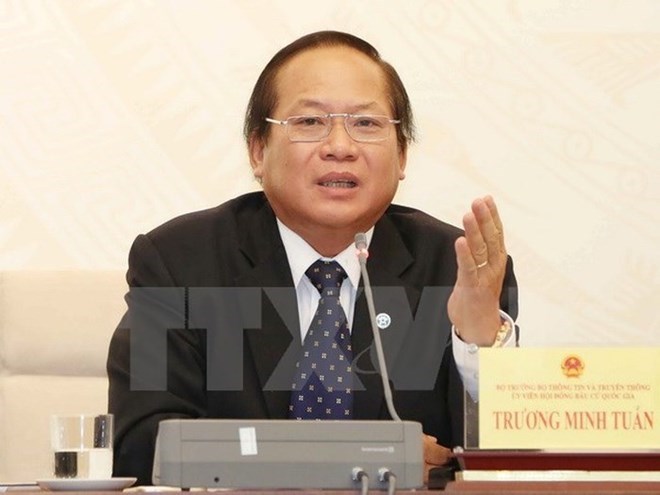 Truong Minh Tuan has been suspended from his position as the Minister of Information and Communications Under Decision 1261/QD-CTN, Tuan was suspended due to his wrongdoings, and the Politburo had imposed a Party disciplinary measure against him under Decision 806-QDNS-TW dated July 16, 2018. The Prime Minister, the Chair of the President’s Office and Truong Minh Tuan as well as relevant agencies are responsible for implementing the President’s decision. On July 18, Prime Minister Nguyen Xuan Phuc gave a warning to Tuan as a disciplinary measure for his law violations at the ministry. Truong Minh Tuan, a member of the Party Central Committee and the Party Committee of the Central Agencies Bloc for 2015-2020, was also relieved from his post as Secretary of the Party Committee of the Ministry of Information and Communications (MIC) for the 2016-2021 term. According to the Politburo, Tuan must bear responsibility for the violations and wrongdoings committed by the ministry’s Party Committee during the 2011-2016 term when he was serving as a member of the MIC’s Party Committee and Deputy Minister of the ministry. He violated the principle of democratic centralism and working regulations, showing a lack of responsibility and lax in leadership when directing the implementation of a project on purchasing 95 percent of shares at the AVG Audiovisual JSC by the MobiFone Telecommunications Corporation. He also signed Decision No.236/QD-BTTTT dated December 21, 2015 on the ministry’s approval of the project, as well as a number of related documents that ran against regulations, including documents beyond his assigned duty. In his capacity as Secretary of the MIC’s Party Committee and MIC Minister since April 2016, Tuan is held responsible for the violations and wrongdoings committed by the committee for the 2016-2021 tenure, the Politburo concluded. VNA |
↧
Article 0
Social News 23/7 PM inspects environment at Formosa Ha Tinh steel company  Prime Minister Nguyen Xuan Phuc (second, right) inspects the Hung Nghiep Formosa Ha Tinh Steel Company on July 20 Prime Minister Nguyen Xuan Phuc inspected the wastewater treatment and manufacturing process at Hung Nghiep Formosa Ha Tinh Steel Company on July 20, nearly one year since his visit to check its environmental protection commitment following the marine environment incident in 2016. He visited the wastewater treatment area, wastewater quality monitor office, steel refining units, and Formosa wharf, as well as checking data transmission from biological lake and automatic wastewater monitor stations to the provincial Department of Natural Resources and Environment. During a working session with leaders of Formosa, and ministries and agencies in the central province of Ha Tinh, the PM said his visit was also to ensure that the furnaces No.1 and No.2 will be put into operation stably, towards producing nearly 7 million tonnes of steel in the near future. He lauded Formosa for fixing 52 out of 53 faults under open and transparent supervision, building houses for workers, and granting scholarships to students. The PM affirmed that Vietnam offers all possible support to domestic and foreign investors to do business in the country, adding that the Vietnamese Government protects the legitimate rights and interests of investors in line with both the law and their responsibilities to the Vietnamese Government and people. The PM hailed Formosa for building large-scale technical infrastructure worth over 11 billion USD in Vietnam – making it the largest foreign-invested project in the country, generating jobs for more than 12,000 workers and making important contributions to local budget. Recalling the serious marine environment impacts from the incident two years ago in the central provinces, he asked Formosa to learn from its lesson and prevent committing the mistake again, adding that it is a strict requirement of the Vietnamese State and it will be punished strictly in line with the law if it commits any related violations again. The PM heralded the efforts of ministries, agencies, localities, and scientists of Ha Tinh province and Formosa for overcoming the marine environment incident in the central region of the country. The company was requested to conform to environmental requirements, invest in advanced technologies to improve product quality, and mitigate environmental impacts. He suggested that the firm should adopt technologies to recycle and use waste materials; improve the efficiency of land use, technical infrastructure, and seaports; and build a 200ha industrial zone for the support industry. The Vietnamese government will continue stabilising the macro-economy and foreign exchange rates, as well as stepping up the fight against smuggling and trade fraud to protect domestic manufacturers. Ministries and agencies were assigned to make it easier for Formosa to deliver on its commitment with the Government, including studying manufacturing standards. Ha Tinh authorities must work closely with the Ministry of Natural Resources and Environment to closely monitor environmental indicators at the company, and consider issuing a joint working mechanism to address any difficulties. Formosa put the furnace No.1 on trial run in 2017, producing 1.6 million tonnes of cast iron valued at 854 million USD. In the first half of this year, the volume of cast iron reached 1.9 million tonnes, which is expected to hit over 5 million tonnes this year, bringing a revenue of roughly 2.6 billion USD. The furnace No. 2 was put into pilot operation on May 18, reaching 95 percent of its capacity. The company has built three levels of incident prevention inside and outside the factory. Water quality at the ecological lake has reached A-standard while solid wastes have been recycled. It is also stepping up training cooperation with the Hanoi University of Science and Technology, the Da Nang University of Science and Technology, and Hue University to train technical staff. The firm has built 304 apartments for married workers, a dormitory for single workers, and a 100-bed hospital for workers and local residents. -VNA Food safety, hygiene shows improvement, but needs more measures 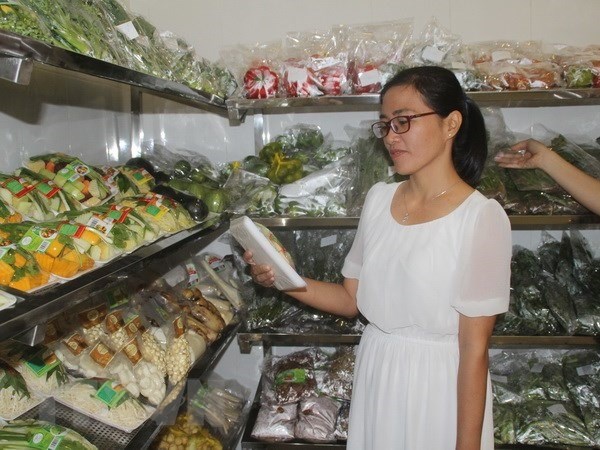 The prevention of food poisoning and food-borne diseases have been improved drastically and showed positive results based on the decrease on food poisoning cases in the first six months of this year The prevention of food poisoning and food-borne diseases have been improved drastically and showed positive results based on the decrease on food poisoning cases in the first six months of this year, a conference heard on July 20. The number of food poisoning cases nationwide is 53, a reduction of 27 cases compared to the same period last year. Eleven people died and around a thousand others were hospitalised this year, more than twice as many as 2017. Speaking at the conference on implementing food safety and hygiene, Vice Minister of Health Le Thanh Long said inspections on food safety and hygiene have been carried out from central to local levels. Reports from inspection teams from 63 cities and provinces showed that in the first 6 months of the year, the inspection teams discovered 68,362 out of 351,130 businesses violating food safety and hygiene regulation. Of that, 13,017 businesses were fined more than 35 billion VND (1.54 million USD). 170 businesses had their licenses suspended, 300 businesses were required to add labelling, and 2,822 businesses had their products destroyed. Reports from the Ministry of Agriculture and Rural Development focused on inspecting food safety and hygiene, which contributed to the curb of using banned chemicals in livestock, minimised the abuse of chemicals and antibiotics, and reduced micro-bacterial contamination on products. The national steering committee on food safety and hygiene said there were shortcomings in the inspection work on food safety and hygiene in many localities. Penalties for violations on the abuse of plant protection chemicals and antibiotics in agricultural production, as well as the use of food additives in food processing, remained low. Food without clear origin was not controlled and is available for purchase in markets. Fraud on producing and trading supplementary food online was still complicated, it said. Minister of Health Nguyen Thi Kim Tien said it was vital for the country’s health authority to enhance the post-inspection work on food safety and hygiene to better control food quality. The ministry would complete the amended decree on giving fines for food safety and hygiene violators based on the current Decree 178/2013/NĐ-CP issued in 2013. Deputy Prime Minister Vu Duc Dam required relevant ministries and agencies to complete the amended decree stipulating sanctions for violations and submitted it to the Government for approval. Of that, the process of culling violated livestock and substandard products, advertising on supplement foods and cosmetics should be in the focus. He said raising awareness of food safety and hygiene should continue to be promoted. Sound practices in food safety and hygiene management in big cities like Hanoi and HCM City should be replicated.-VNS/VNA Photo exhibition demonstrates green future of biomass energy 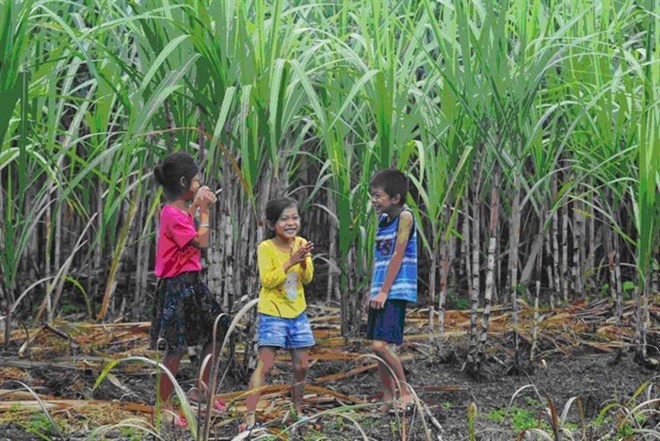 A photo displayed at the exhibition depicts children playing by a sugarcane farm. There are 11 sugar mills across the country generating biomass energy to sell to the grid (Photo courtesy of GIZ) A photo exhibition entitled “Biomass energy-for a green future” took place from July 18-21 at the Saigon Exhibition Convention Centre in HCM City’s District 7. The exhibition, organised by the Deutsche Gesellschaft für Internationale Zusammenarbeit (GIZ) Climate Finance Readiness Programme of Germany, aims to manifest the immense potential of renewable energy development, especially biomass energy in Vietnam. About 20 photos by photographers from across the country are displayed at the exhibition featuring individuals, organisations and localities which are now making a great contribution to the cause of promoting clean and eco-friendly energy sources in Vietnam. Each photo tells story about efforts in improving society’s awareness of the importance of biomass energy in helping reduce the impacts of climate change as well as maintaining sustainable agricultural development. Vietnam is one of the most rapidly growing economies in Southeast Asia. This rapid growth goes hand-in-hand with a rising demand for electricity, which is set to increase exponentially by the year 2020, a report from the GIZ said. Recent scientific research has shown that by the end of 2014, the country could have exploited approximately 20.67 million tonnes of wood energy and 52.91 million tons of agriculture residues, mainly rice husk, straw and bagasse. Biomass energy, which has the potential to utilise millions of tons of agricultural residue including bagasse, rice husk and woods, plays an important role in generating clean electricity and contributing to rural development while at the same time reducing carbon emissions and mitigating climate change impacts. Sri Lanka’s Bodhi tree planted at Tam Chuc Pagoda 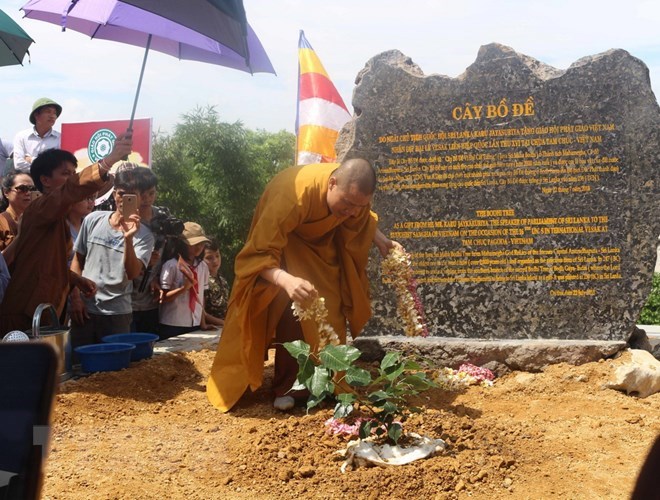 At the ceremony The Vietnam Buddhist Sangha held a ceremony at Tam Chuc Pagoda in Kim Bang district, the northern province of Ha Nam, on July 22 to plant a Bodhi tree presented by Speaker of the Sri Lankan Parliament Karu Jayasuriya. The Bodhi tree is a branch of Sri Lanka’s 2,250 year-old Jaya Sri Maha Bodhi, the oldest tree in the world. The Jaya Sri Maha Bodhi is said to be the right-wing branch (southern branch) from the historical Sri Maha Bodhi at Buddha Gaya in India under which Lord Buddha attained enlightenment. Tam Chuc pagoda sits on a site of nearly 5,000ha, surrounding by lakes, mountains, forests and valleys. Excavated objects reveal that the pagoda is around 1,000 years old. The pagoda, which has been entirely damaged with time, is being rebuilt with the first phase expected to be completed in May 2019 when the pagoda hosts the UN Day of Vesak (Buddha's Birthday, Enlightenment and Passing Away). The Tam Chuc complex was recognised by the Prime Minister as a national tourism site in 2013. Association promotes solidarity among Vietnamese in Laos 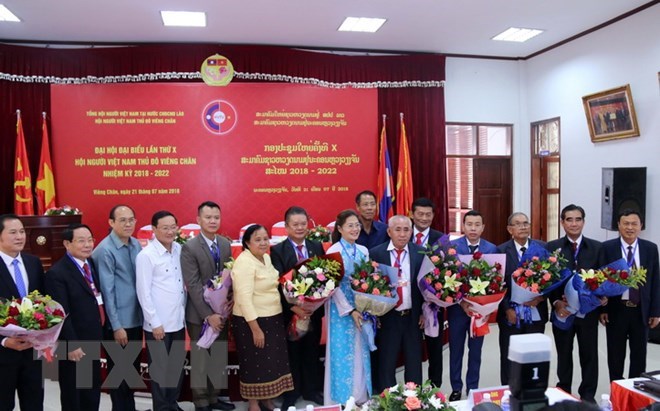 Delegates at the congress The Vietnamese Association in Vientiane, Laos reviewed its performance over the past five years and set out orientations for the 2018-2022 tenure during a congress on July 21. During the past five-year term, the association has organised many community-based activities and promoted traditional Vietnamese culture in Laos, while constructively participating in activities launched by the Vietnamese Embassy in the country. Of note, the association has paid attention to developing the Nguyen Du Lao-Vietnamese bilingual language school in Vientiane, with an increasing number of students, and better teaching and learning quality. The congress elected a new nine-member executive board for the tenth tenure headed by Le Van Mui. Bounna Phathounmavong, Director of Vientiane’s Department of Home Affairs, expressed his hope that the Vietnamese expats in Vientiane set example in observing Lao laws and help each other escape from poverty, contributing to the development of the Lao capital city. Vietnamese Ambassador to Laos Nguyen Ba Hung voiced his wish that the association will reap more achievements in developing the Vietnamese community in Vientiane in particular and in Laos in general. Overseas Vietnamese contribute to Vietnam-Russia ties  Participants at the conference Vietnamese Ambassador to Russia Ngo Duc Manh has praised the association of Vietnamese people in Russia for their active contributions to reinforcing and developing the two countries’ comprehensive strategic partnership. At a conference to review the association’s performance in 2015-2017 in Moscow on July 20, the ambassador recognised its efforts to help overseas Vietnamese stabilise their lives and integrate into the host society. The association also held activities to support the homeland, he said. Deputy Foreign Minister Vu Hong Nam took note of the opinions raised by the association members and pledged to deliver their proposals and aspirations to domestic relevant agencies. Participants suggested increasing dissemination of legal regulations and changes in business conditions in Russia for Vietnamese expatriates to promote their legal status in the country. They recommended that the association step up the teaching and learning of Vietnamese language and culture for expat children. At the same time, the association should provide consultation for enterprises and individuals who want to explore business opportunities in Russia and promoting Vietnamese goods and tourism. It is necessary to seek new and diverse measures such as organising workshops, exchanging delegations, and establishing twin ties among localities to enhance Vietnam-Russia comprehensive cooperation. The association members also suggested expanding exchanges with other foreign communities in Russia and sending representatives to attend relevant activities held by Russian legal social organisations. Egyptian newspaper hails cooperation prospects with Vietnam  A photo of Nha Trang city - a popular destination in Vietnam Vietnam and Egypt hold great potential for cooperation in marine economy and tourism, according to Al Messa, one of the most prestigious Egyptian daily newspapers. The assessment was made in an article published in the newspaper on July 20. Author of the story Refat Khaled said during the visit to Egypt in last May, Vo Van Thuong, Politburo member and Secretary of the Communist Party of Vietnam (CPV) Central Committee, highlighted the growing relations between Vietnam and Egypt in all fields, especially after the historical visit to Vietnam by Egyptian President Abdel Fatah El-Sisi in September 2017. The President’s visit created a good foundation for the bilateral cooperation to grow in various spheres, particularly marine economy and tourism. The article pointed to Egypt’s significant geo-strategic position, serving as the gateway between the three continents of Africa, Europe and Asia. Meanwhile, Vietnam has great potential in sea-based economy development with 48 bays and more than 3,000 islands in the East Sea. Regarding fishery resources, Vietnam is on the list of 20 most economically advantageous seas for marine fisheries in the world, with many species of high economic value. Vietnam is also a popular destination for millions of foreign tourists with white beaches and world-renowned scenic sites in Ha Long, Nha Trang, Da Nang and Phu Quoc along the country’s 3,260 km long coastline. In 2017, Vietnam welcomed 12 million international visitors, including tens of thousands of holidaymakers from Africa and Egypt in particular. At the same time, an increasing number of Vietnamese people are also visiting Egypt – the country of pyramids. According to the article, Vietnam and Egypt have signed nine cooperation agreements, including four relating to marine economy and tourism. This shows that the two sectors are the focuses and priorities for win-win cooperation. Association contributes to enhancing Vietnam-Germany friendship 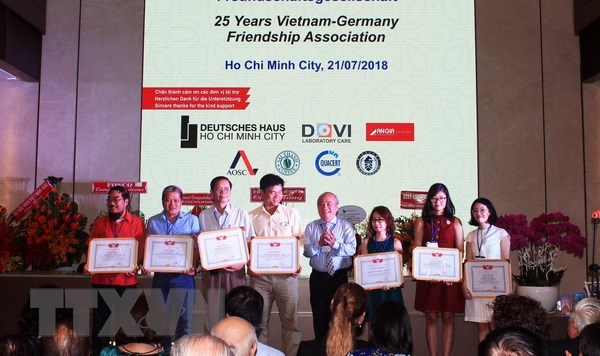 Huynh Minh Thien, President of the Union of Friendship Organisations in HCM City (fourth, right), presents gifts to individuals and organisations in recognition of their contributions to the Vietnam-Germany Friendship Association in HCM City. Daniela Scheetz, Vice Consular General of Germany in Ho Chi Minh City, has lauded contributions made by the Vietnam-Germany Friendship Association in HCM City to enhancing the friendship and cooperation between Germany and Vietnam over the past 25 years. Speaking at a ceremony to mark the 25th anniversary of the association in HCM City on July 21, the diplomat congratulated the association on its successful organisation of cooperation programmes in the fields of culture, tourism and trade promotion between Vietnam and Germany. She said the increasing number of Vietnamese people travelling to Germany and vice versa has demonstrated the thriving collaboration and friendship between the two sides. Daniela Scheetz expressed her wish that the community of Vietnamese who used to study and work in Germany will continue to work as a bridge helping intensify the mutual understanding and friendship, bringing practical benefits to people of the two countries. Huynh Minh Thien, President of the Union of Friendship Organisations in HCM City (HUFO), hailed the diverse activities organised by the association, ranging from politics to economy, culture and social affairs, which he said have contributed to the city’s people-to-people diplomacy. The association has 10 chapters and 500 members who are mainly young businesspeople. VFF extends sympathies to flood victims 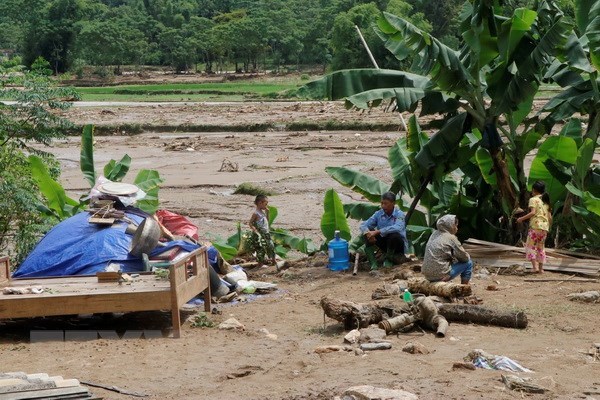 11 people were killed, 12 others went missing and 13 were injured in floods. The Standing Board of the Vietnam Fatherland Front Central Committee (VFFCC) on July 21 sent a message of sympathy to authorities and people affected by floods in Thanh Hoa, Yen Bai, Hoa Binh, Nghe An and Ha Tinh provinces. The message noted that storm Son Tinh, the third tropical storm to enter the East Sea this year, has triggered torrential rains and floods in the north central provinces of Thanh Hoa, Nghe An and Ha Tinh, and the northern mountainous provinces of Yen Bai and Hoa Binh, causing human and property losses. The Central Steering Committee for Natural Disaster Prevention and Control reported that as of July 21 morning, 11people were killed, 12 others went missing and 13 were injured in floods. Besides, the natural disasters also damaged hundreds of houses, and flooded and destroyed hundreds of hectares of rice and other food crops. The VFFCC Standing Board applauded the high sense of responsibility and concerted efforts of all-level Party Committees, authorities, VFF’s chapters, organisations, agencies and armed forces in searching for the missing and supporting flood victims. In the message, the VFFCC Standing Board asked the VFF committees of the provinces to coordinate with local authorities and provincial steering boards for natural disaster prevention and control to evaluate human and property losses caused by the floods and reported to the VFF. The VFFCC Standing Board also announced a decision to send 5 million VND (220 USD) in aid to each family of the bereaved and missing, 3 million VND (30 USD) to each seriously injured person and 40 million VND (1,760 USD) to each family made homeless by the floods. Requiem commemorates heroic martyrs in Quang Tri 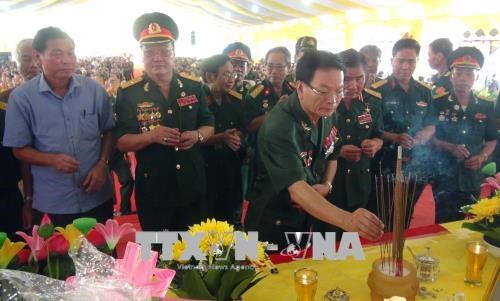 At the ceremony A requiem ceremony was held in the central province of Quang Tri on July 21 to commemorate soldiers who died during an 81-day battle here in the summer of 1972 to safeguard the country. Jointly held by the Quang Tri Ancient Citadel Soldier Association and the Vietnam Buddhist Sangha (VBS), the ceremony was among activities to mark the 71st anniversary of the Vietnam Invalids and Martyrs Day (July 27, 1947-2018). It was attended by representatives from ministries, departments and sectors, armed forces, local officials and heroic Vietnamese mothers, and over 3,000 dignitaries, monks, nuns, and Buddhist followers nationwide. Fierce fighting for control of the citadel, the central province’s symbol of power, started from June 28 and ended on September 26, resulting in heavy casualties on both sides. The fight contributed to Vietnam’s triumph at the Paris Conference and was a prerequisite for the General Offensive and Uprising in the spring of 1975, which completely liberated the south and reunified the country. The old citadel, just under 3,000sq.m, and a small area around it was bombarded by the combined fire power of American B52 strategic bombers, the 7th Fleet and thousands of artillery pieces. An estimated 328,000 tonnes of bombs were dropped on the old citadel and a small town of some 10,000 houses around it. By the time the fighting ended, the town was almost leveled. No houses remained intact. In recent time, a series of activities have been organised by local authorities, organisations and those in and ouside the province to support families of wounded soldiers and martyrs. Hundreds of houses were presented to people who contributed to the revolution. On the occasion, the Sai Gon - Hanoi Bank presented 20 houses worth 50 million VND (2,184 USD) each to members of the Quang Tri Ancient Citadel Soldier Association’s chapters nationwide. The Joint Stock Commercial Bank for Foreign Trade of Vietnam’s branches in Quang Tri and Ho Chi Minh City also gave 12 houses totaling 600 million VND (26,210 USD) to the families of invalids and martyrs in the locality. Tokyo concert marks 45 years of Vietnam-Japan ties 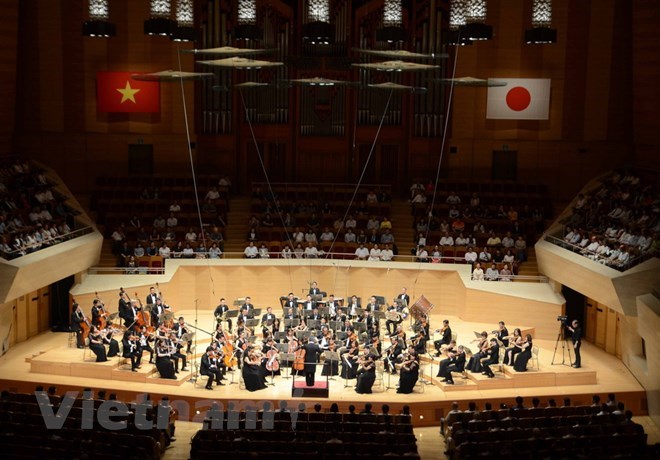 The concert took place at the Suntory Hall in Tokyo on July 20 A concert marking the 45th anniversary of Vietnam-Japan diplomatic relations was held at the Suntory Hall in Tokyo on July 20 with the presence of the Japanese Emperor and Empress. After the two countries’ national anthems, the audience enjoyed famous musical pieces of the world and Vietnam performed by artists of the Vietnam National Symphony Orchestra (VNSO). Notably, the symphony “Nguoi ve dem toi ngay vui” (He who brought happiness to us) composed by Trong Bang, describing Vietnamese people’s love for late President Ho Chi Minh, received a big round of applause from the audience. The orchestra was led by Japanese conductor Tetsuji Honna, who is also principal conductor and music director of the VNSO. Vietnamese Ambassador to Japan Nguyen Quoc Cuong said musical exchange is an impressive thing in the two countries’ relations, noting that Nha Nhac (Vietnamese court music) came to Japan in the mid-8th century. It could be said that people-to-people exchange between the countries began through music, he added. The concert, part of a series of activities celebrating 45 years of bilateral diplomatic relations, attracted about 1,500 Vietnamese and Japanese people. A similar concert took place in Osaka city on July 18. Activities to commemorate heroic martyrs held nationwide The Vietnam Red Cross Society on July 20 started construction of “Red-Cross houses” for disadvantaged veterans in the northern mountainous province of Ha Giang who fought in the Vi Xuyen battle. 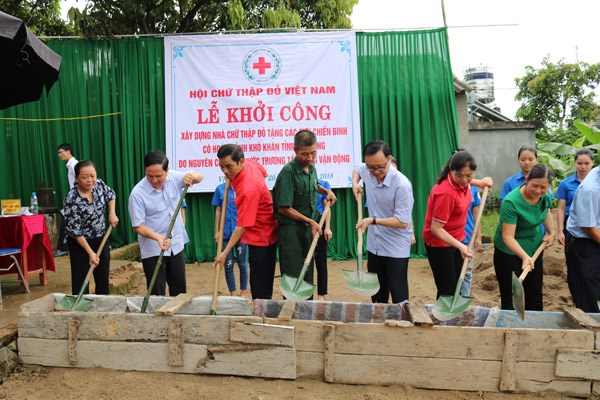 The Vietnam Red Cross Society on July 20 started construction of “Red-Cross houses” for disadvantaged veterans in the northern mountainous province of Ha Giang who fought in the Vi Xuyen battle between 1979 and 1989. The houses were built at a total cost of over 4 billion VND (174,000 USD) raised with support of former President Truong Tan Sang. Furthermore, 80 families of Vi Xuyen battle veterans will receive 60 million VND each to repair their houses. At the event, Thao Hong Son, Vice Secretary of the Party Committee of Ha Giang and Chairman of the provincial People’s Council asked local authorities to take care of living conditions of those who have made contribution to the country and their families. On the evening of the same day, a lantern floating festival was held in the central province of Quang Tri, with the participation of martyrs’ family members, tourists and local residents. More than 15,000 lanterns were lightened up on the province’s Thach Han river. On the occasion, organisers of the festival also presented 32 houses of gratitude worth 50 million VND (2,170 USD) each to families of policy beneficiaries and gift sets to two Heroic Mothers in the province. Meanwhile, the central city of Da Nang has offered presents worth nearly 11 billion VND (478,500 USD) to local people who rendered services to the nation. In the south central province of Ninh Thuan, 10 houses were presented to disadvantaged war veterans in Phan Rang - Thap Cham city. Families of the veterans also received five million VND. Ninh Thuan is home to 302 poor war soldiers, accounting for 4.78 percent of total number of veterans in the province. Eighty of them are living in dilapidated houses, according to Chairman of the provincial Association of War Veterans Nguyen Van Thuan. Exchange celebrates 45 years of Vietnam-Belgium relations 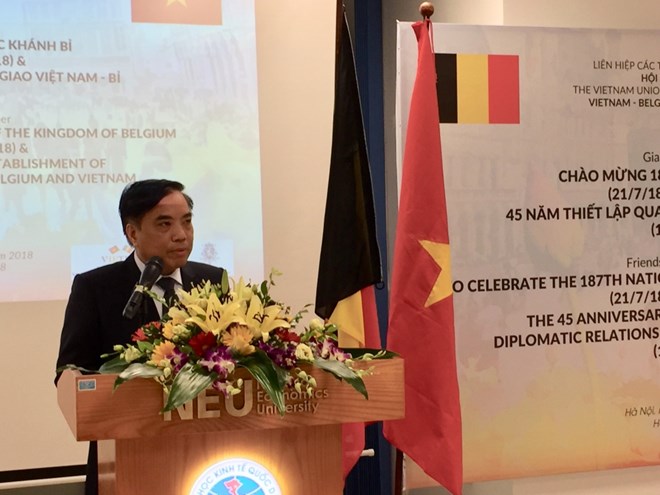 Chairman of the Vietnam-Belgium Friendship Association Pham Manh Hung speaks at the exchange in Hanoi on July 20 (Photo: baoquocte.vn) The Vietnam-Belgium Friendship Association and the Belgian Embassy in Vietnam have held an exchange in Hanoi to mark the 187th National Day (July 21, 1831) of the European nation and 45 years of the two countries’ diplomatic ties (March 22, 1973). The July 20 event saw the presence of Vuong Thua Phong – deputy head of the Communist Party of Vietnam Central Committee’s Commission for Foreign Relations; Pham Sanh Chau – Assistant to the Foreign Minister, Special Representative of the Vietnamese Prime Minister on UNESCO Affairs and Secretary General of the Vietnam National Commission for UNESCO; Pham Khac Son – Vice Chairman of the Vietnam Union of Friendship Organisations; and Deputy Head of Mission at the Belgian Embassy Anke Van Lancker. Chairman of the Vietnam-Belgium Friendship Association Pham Manh Hung, who is also Deputy Minister of Education and Training, said since Prince Leopold I became the first king of Belgium 187 years ago, Belgium has swiftly become an industrialised nation with a developed economy and leading science-technology in the world. It currently ranks 21st in the Human Development Index and has won 10 Nobel prizes in different fields. He wished the Belgian people to obtain more achievements to further contribute to the world’s development, prosperity and peace. Hung added that this year, Vietnam and Belgium celebrate the 45th founding anniversary of diplomatic ties, which is a significant milestone in bilateral friendship and cooperation. Great strides have been seen in bilateral relations over the last four and a half decades, he said, elaborating that Vietnam has become an important Southeast Asian partner of Belgium in all spheres, from politics, economy, trade, culture and education-training to scientific research. The two sides have also coordinated closely at multilateral forums and international organisations like the United Nations, the Asia-Europe Meeting, the ASEAN-EU cooperation, and the International Organisation of La Francophonie. Thousands of Vietnamese students, postgraduates and doctors have been receiving training in the European nation. Notably, more than 2,000 Vietnamese have finished the Solvay Vietnam Master programmes, the official said, describing the positive outcomes of educational partnership as a pride of bilateral relations. At the exchange, Anke Van Lancker said the two countries’ friendship and cooperation have been marked with fruitful cooperation in multiple areas such as economy, development, research and especially education-training with over 2,000 Vietnamese used to study in Belgium and 2,000 others used to enroll in the Solvay Vietnam Master programmes. She expressed her hope that the Vietnam-Belgium Friendship Association will continue to organise meaningful cultural exchanges to help promote people-to-people diplomacy and enhance the countries’ friendship. Winners of songwriting contest praising Dong Loc girls announced 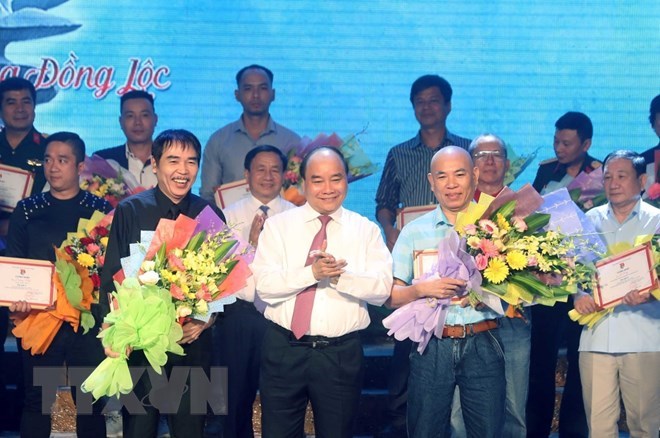 Prime Minister Nguyen Xuan Phuc (C) at the ceremony A ceremony was held in the central province of Ha Tinh on July 20 to present prizes to the most standout entries to a contest of writing songs praising ten young unmarried girls who were volunteers helping with logistics at the Dong Loc T-junction during the war. Organised by the Ho Chi Minh Communist Youth Union (HCYU) Central Committee, the provincial Party Committee and Thanh Nien Newspaper, the event was attended by Prime Minister Nguyen Xuan Phuc; representatives from ministries, departments and sectors; and local youths and people. As many as 87 entries were sent to the contest after it was launched in Hanoi in April 2018, with many of them were written by professional and amateur songwriters who live in Ha Tinh or joined art troupes that performed in the battlefields in the locality during the war time. All the songs praise the bravery, fortitude and heroic sacrifice of the Dong Loc girls, as well as show deep gratitude for them. The first prize was presented “Co tich que minh” by Ngoc Thinh and Ngoc Vuong, while the second and third prizes was awarded to “Hoa cuc rung lai no” by Le May and Hong Phong; and “Chi oi” by Hoang Nha, respectively. The contest was part of activities to mark the 50th anniversary of Dong Loc victory (July 24, 1968-2018). The award ceremony was followed by an art programme entitled “The immortal flowers”, featuring songs on the glorious path of the Vietnamese army and people in the anti-US resistance war, especially the contributions by volunteer youths in the Dong Loc T-junction. Former imperial city of Hue to build tourism mart 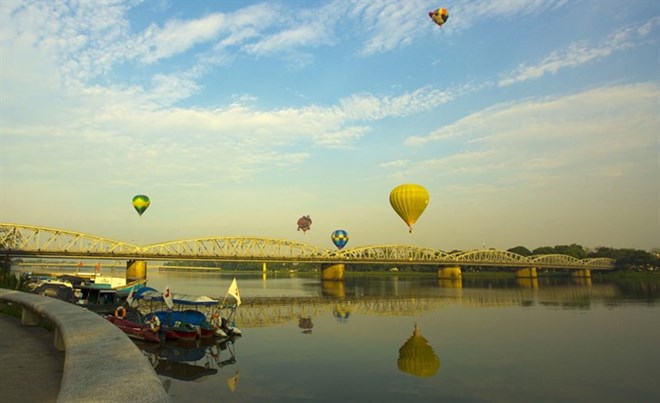 The famed Truong Tien Bridge in Hue at sunset. Hue is to offer visitors a place for muster with modern look The former imperial city of Hue in central Thua Thien-Hue province plans to develop a complex featuring a hotel, leasing offices, shopping malls and tourist recreation facility to offer something new from the heritage monuments in the former imperial capital. Local authorities called the complex a tourism mart. According to the local tourism department, the mart will be a righteous place for visitors to Hue to enjoy. The mart will be built at An Dong, a new urban zone east of the city. It will be built around a lake surrounded with trees, creating a green and natural ambiance. Under the mart’s master plan approved by local authorities in early July, the mart’s core will also include a square and small parks. The core nearby areas will be reserved for a tourist information centre, a trade centre, a floating market and duty-free stores. Hotel facilities and leasing offices will be located in the rear of the mart, with a hotel capable of housing 320 people each day. In the area beside the mart, authorities plan to build a residential area with room for 1,200 residents. Authorities also plan to place public toilets along the roads in the mart and a separate system for collecting rubbish. Dong Thap, An Giang hold memorial services for fallen soldiers Remains of Vietnamese soldiers are carried inside the Tam Nong district martyr cemetery Ceremonies to commemorate and rebury remains of Vietnamese soldiers during wartime took place in the Mekong Delta provinces of Dong Thap and An Giang on July 20. In Dong Thap, following a solemn requiem, 85 remains of Vietnamese volunteer soldiers and experts, who died in Cambodia, were reburied at the Tam Nong district martyr cemetery. Speaking at the ceremony, Chanh Tha, deputy governor of Cambodia’s Prey Veng province, stressed the traditional friendship between Vietnam and Cambodia, adding that Prey Veng province will continue supporting the searching and repatriation of Vietnamese soldiers’ remains there. Since 2001, search team K91 under the Dong Thap military command has carried out 17 searches, unearthing 1,713 sets of remains of Vietnamese volunteer soldiers and experts. In An Giang, a memorial and reburial service was held for 168 volunteer soldiers, who fell down during wartime. Search team K90 of Military Zone 9 and K93 of the An Giang Military High Command found these remains during the 2017 – 2018 dry season. Of the 168 sets of remains, 130 were unearthed in Cambodia, while the remainder in Vietnam. VNN |
↧
Article 1
Government News 23/7 Int’l conference to be held to improve Vietnam’s peacekeeping capacity 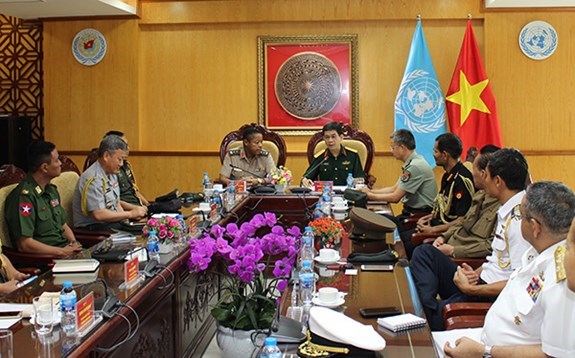 The working session between foreign military attachés and officers of the Vietnam Department of Peacekeeping Operations on July 19 (Photo: qdnd.vn) Vietnam and the United Nations Development Programme (UNDP) will chair an international conference in early September, aiming to improve the country’s capacity of taking part in UN peacekeeping activities. The information was released by a representative of the Vietnam Department of Peacekeeping Operations (DPKO) while talking to foreign military attachés who visited the department on July 19, Quan doi Nhan dan (People’s Army) newspaper reported. The attachés learned about the development of the DPKO as well as the country’s participation in United Nations peacekeeping activities in recent years. On behalf of the delegation, Defence Attaché of South Africa Mpiwa Kgotso Abiel lauded Vietnam’s effective participation in UN peacekeeping activities. He also congratulated the DPKO on being chosen as a training site for UN peacekeeping forces within the framework of the tripartile partnership programme. The attachés also discussed peacekeeping cooperation with Vietnam in the future. The DPKO, previously the Vietnam Peacekeeping Centre, opened in 2014. Since then, the country has sent 20 officers to the UN Multidimensional Integrated Stabilisation Mission in the Central African Republic and the UN Mission in South Sudan. It is preparing to deploy a level-2 field hospital to South Sudan. Vietnam People’s Army delegation visits China 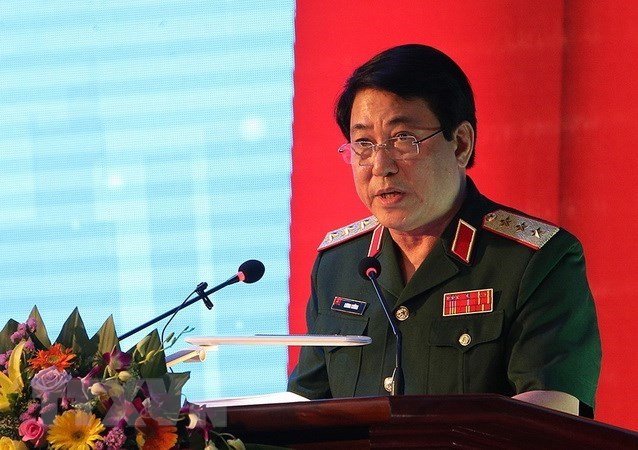 Sen. Lieut. Gen. Luong Cuong A high-ranking delegation of the Vietnam People’s Army (VPA) led by Sen. Lieut. Gen. Luong Cuong, member of the Standing Board of the Central Military Commission and Director of the VPA’s General Department of Politics, is paying a friendly visit to China from July 22-26. The visit is made at the invitation of Sen. Lieut. Gen. Miao Hua, member of China’s Central Military Commission and head of the commission’s Political Work Department. The visit aims to continue to implement agreements reached by senior leaders of Vietnam and China, contributing to consolidating the traditional friendship, enhancing mutual political trust and firmly developing the comprehensive cooperation between the two parties, states, peoples and armies, for peace, stability and development in the region and the world at large. The trip is expected to help boost the affiliation between the VPA’s General Department of Politics and the Chinese Political Work Department, and materialise the joint vision statement on defence relations by 2025 between the two defence ministries in the Party and political work. Ha Tinh province should strive for self-financing: PM 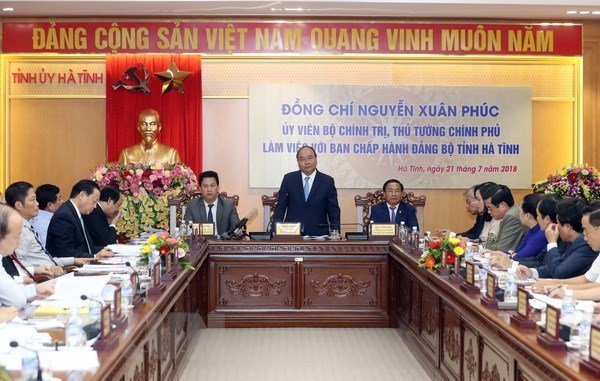 Prime Minister Nguyen Xuan Phuc (standing) speaks at the working session with Ha Tinh provincial Party Committee Prime Minister Nguyen Xuan Phuc commended the central province of Ha Tinh for its good growth and high disbursement of public investment capital in the first half of the year, telling it to strive for self-financing. Addressing a working session with the Ha Tinh provincial Party Committee on July 21, the PM highlighted that the province has made a strong recovery after the marine environmental incident in 2016 which left serious impacts on the local economy. In the first six months of 2018, the province – which is considered to be the most economically potential in the north central region – recorded high growth of about 33 percent. The industry-construction sector rose by nearly 96 percent, making up over 44 percent of the local economic structure. The total budget collection topped 6 trillion VND (262.1 million USD), equivalent to around 70 percent of the estimate. The industrial production index increased 170.9 percent in comparison with the same period last year. With the aforesaid outcomes, Ha Tinh is standing in a new position in the development map of Vietnam, PM Phuc said. Apart from developing industry, the province still pays great attention to agro-forestry-fishery, which, he said, is suitable for a locality with a high rate of rural and mountainous areas. The Government leader made several suggestions for the province to achieve breakthrough development in the coming time such as focusing on three pillars of industry, agriculture and service. The PM recommended speeding up urbanisation and shifting labour structure, noting that industrialisation should go with urbanisation, especially in coastal urban areas. At the same time, he reminded Ha Tinh to accelerate efforts to reduce poverty, implement more effectively social welfare policies and improve access to education. Besides facilitating the production of Hung Nghiep Formosa Ha Tinh Steel Company – which caused the marine environmental incident in four central provinces in 2016, Ha Tinh should keep strict monitoring of the company’s operation to ensure no repetition of environment pollution, including the treatment of ash discharged from steel production in Formosa. After the working session, PM Phuc and World Bank (WB) Country Director for Vietnam Ousmane Dione witnessed the signing of a strategic cooperation framework between Ha Tinh and the World Bank in 2018-2022. Under the framework, the two sides will work toward sustainable and comprehensive growth, and increase information sharing, policy dialogues and technical assistance in priority fields including agriculture and food safety, urban development and water resources, maritime strategy, environmental protection and climate change, and industrial development. They will also work together to revise the province’s socio-economic development plan through 2020 and overall planning scheme for 2021-2030 with a vision toward 2050. The WB has so far provided Ha Tinh with more than 5.7 trillion VND (249 million USD) in grants, aid and loans for upgrading infrastructure, improving the environment and human resources, reform institutions and developing education and training. PM pays respect to fallen youth volunteers at Dong Loc T-junction 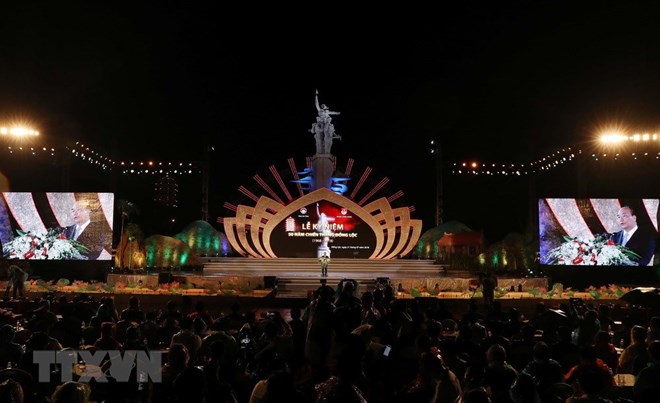 The event marking the 50th anniversary of the Dong Loc victory was held on July 21 The Dong Loc T-junction in the central province of Ha Tinh has gone down in history with the heroic sacrifice of hundreds of war heroes, especially the ten young female volunteers, during the war to liberate the southern region and reunify the country, said Prime Minister Nguyen Xuan Phuc. He made the remarks while speaking at a special event held at the Dong Loc T-Junction relic site on July 21 night to mark the 50th anniversary of the Dong Loc victory (1968-2018). The Dong Loc T-junction was the most important transport intersection on the legendary Truong Son-Ho Chi Minh trail, through which trucks carrying soldiers, food, arms and munitions from the north must go on their way to southern battlefields. From 1965 to 1968, the US army dropped nearly 50,000 bombs and fired tens of thousands of missiles on the Dong Loc T-junction in Dong Loc commune, Can Loc district in order to cut off the transport route to the southern front. All human resources were mobilised by the Vietnamese Government at that time to ensure the road would be clear. Many young volunteers worked at the site, using every minute between bombings to level bomb craters on the road. On July 24, 1968, a bomb fell very close to the mouth of the cave where a group of 10 female volunteers, aged from 17 to 24, were taking shelter, killing all of them. Their sacrifice has become a symbol of Vietnamese heroism. At the event, PM Phuc asked all-level Party Committees, authorities and people of Ha Tinh and other localities nationwide to pay tribute to families of war martyrs, war invalids and veterans, helping them overcome all difficulties to have a better life. On this occasion, the leader presented ten houses of gratitude to local families of revolution contributors who are in difficult circumstances. The organisation board also handed over gifts to war veterans and relatives of the fallen soldiers and young volunteers who fought at the Dong Loc intersection. Earlier the same day, PM Phuc attended the inaugural ceremony of a bypass to the east of the Dong Loc T-junction relic site, which is expected to help ensure traffic safety and reduce dust and noise pollution in the area. Kien Giang, Cambodia’s localities enjoy strong bonds 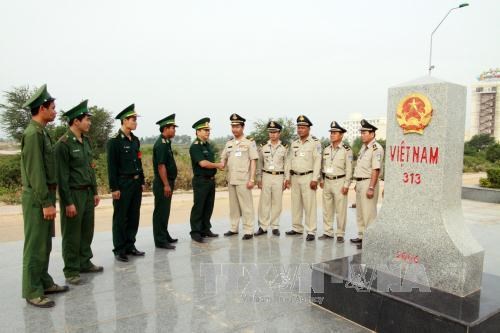 The Mekong Delta province of Kien Giang and Cambodian localities have joined hands to ensure social order in border area. The Mekong Delta province of Kien Giang, and five Cambodian localities of Kep, Kampot, Preah Sihanouk, Koh Kong and Phnom Penh have enjoyed sound cooperation cross the fields of agriculture, aquaculture, trade, healthcare, education, culture-sports, tourism, and defence-security. Chairman of the provincial People Committee Pham Vu Hong said that the collaboration has made significant contributions to the socio-economic development of each sides as well as the special friendship between the two countries in general and between Kien Giang and the Cambodian provinces and city in particular. The parties have joined hands to ensure security and order along the border areas to build a shared border of peace, friendship, cooperation and sustainable development. Remarkable achievements have seen in border trade, with total import-export revenue recorded at over 414 million USD from 2015. Kien Giang province shipped more than 202 million USD worth of products to the Cambodian localities, and splashed out 211 million USD to purchase coal, frozen seafood, and food additives from Cambodia. Leaders from Kien Giang and Cambodia localities hold regular meetings to remove bottlenecks in border issues in the spirit of solidarity, friendship and mutual understanding. Also, they delivered greetings and held exchanges on the occasion of each other’s national holidays while facilitating cross border travel and trade. In the coming time, they will push forwards with activities under the signed deal to help each other maintain political stability, develop the economy and stabilise local livelihoods. The two sides vowed to intensify partnership for economic, social and cultural development, and for maintaining peace, stability, social order and security in border areas and at sea. The sides will bolster coordination to raise public awareness of illegal fishing in foreign waters while working to combat trade fraud and smuggling. PM asks Duc Tho to become first new rural district in Ha Tinh 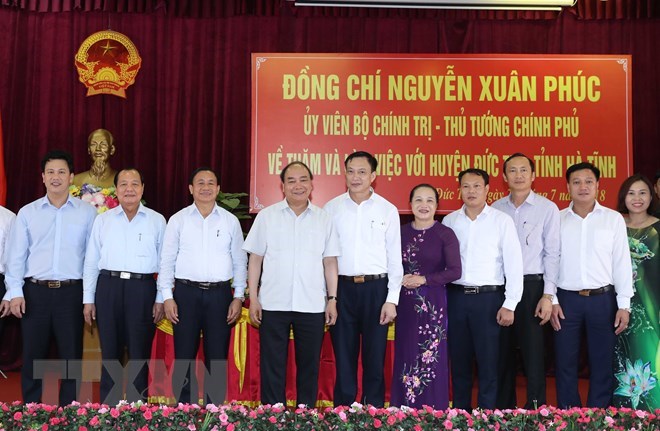 Prime Minister Nguyen Xuan Phuc (fourth, left) and officials of Duc Tho district at the working session Prime Minister Nguyen Xuan Phuc has asked Duc Tho to work hard to become the first district in the central province of Ha Tinh recognised as a new-style rural area by the end of 2018. During a working session with officials of Duc Tho district on the occasion of his working trip to the locality on July 21, the PM urged authorities of Ha Tinh and its Duc Tho district in particular to make more efforts to improve locals’ living conditions, towards sustainably promoting poverty reduction. PM Phuc called on the local authorities to make new strides in implementing the national target programme on building new-style rural areas. He spoke highly efforts made by the district’s authorities in the work, especially in building model gardens and residential areas, which help improve incomes for locals and contribute to preserving traditional culture values in the community. While stressing the goal of new-style rural area development, PM Phuc said this is a big policy of the State which aims to bring a better life to the people. Statistics show that Duc Tho mobilised nearly 2.6 trillion VND (113.5 million USD) for building new-style rural areas over the last eight years. As many as 18 out of 27 communes in the district have met new-style rural area stardards. Notably, agriculture accounts for only 22.2 percent of the district’s economic structure. The trade and service field accounts for the largest proportion, with 45.8 percent. In 2017, the district’s annual per capita income stood at 35.3 million VND, while the rate of poor households was only 4.9 percent. The building of model gardens and residential areas is the highlight in the new-style rural development in Duc Tho, showing the local authorities’ renovation in the work. A total of 147 residential areas and 755 gardens of this kind were formed in the locality, laying a foundation for building new-style rural areas in a sustainable manner in Ha Tinh. The local authorities have also mapped out a plan to streamline administrative units, with the target of having only 13 communes by 2025, down 15 compared to the current figure, helping reduce expenditure of 25 billion VND per year. The PM underlined the need for the locality to do better the work of building and consolidating the political system, and streamlining administrative apparatus, towards people’s greater satisfaction. On the occasion, the Government leader laid a wreath and offered incense at the memorial site dedicating Tran Phu - the first General Secretary of the Communist Party of Vietnam in Quan Hoi mountain of Duc Tho district. Greetings sent to Belgian leaders on their National Day President Tran Dai Quang on July 20 conveyed greetings to Belgium’s King Philippe I on the occasion of the Belgian National Day (July 21). The same day, Prime Minister Nguyen Xuan Phuc sent congratulations to his Belgian counterpart Charles Michel. On the special occasion, Deputy PM and Foreign Minister Pham Binh Minh also cabled a message of celebration to Foreign Minister of Belgium Didier Reynders. Since Vietnam and Belgium set up diplomatic ties in 1973, bilateral partnership has continued to grow. The two countries have held high-level meetings and visits regularly, while also supporting each other at international forums. Economic and trade cooperation has played a key role in bilateral ties. In 2017, two-way trade reached nearly 2.5 billion USD. Belgium is currently running more than 60 projects worth about 600 million USD in Vietnam. Deputy PM calls for improvements in disaster, incident response 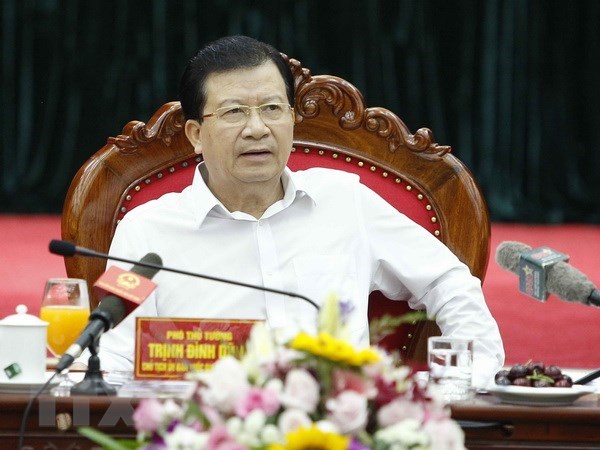 Deputy Prime Minister Trinh Dinh Dung speaks at the conference Deputy Prime Minister Trinh Dinh Dung asked for improvements to be made nationwide in building plans to respond to incidents and disasters, including search and rescue activities, at a conference in Hanoi on July 20. A report delivered at the conference revealed that since the beginning of 2017, authorised forces have saved 5,438 people and 358 vehicles. More than 3.1 million people on over 744,000 vessels operating at sea have been informed of dangerous weather situations to seek shelter, while nearly 107,900 households were evacuated from dangerous areas. Deputy PM Dung, who is head of the State Committee for Incidents and Disaster Response, and Search and Rescue, said that the reviewed period witnessed complicated developments in weather, climate change, disasters, and incidents, causing serious and fatal damages. Most recently, floods and landslides triggered by torrential rains in the northern mountainous provinces during June 23-26 left over 40 dead, missing, or injured, while four were swept away by floods in Lang Chanh district, the central province of Thanh Hoa, on July 19. In addition, many fires and explosions have happened, causing serious impacts, including a fire at the apartment complex Carina Plaza in Ho Chi Minh City which killed 13 people and a blaze at Hai Ha 18 oil tanker in Hai Phong city. “Those incidents and disasters require us to take responsibility for reducing losses and intensifying response measures. Minimising human and asset losses are the core task of the work, contributing to ensuring the continuation of socio-economic development,” Dung stressed. The leader said that in the remaining months of 2018, the weather and climate situation is likely to be complex with unpredictable developments. He asked ministries, sectors, and localities to keep a close watch on rain and flood developments after storm Son Tinh, the third of its kind to hit the East Sea; as well as flood developments in the east, southern, and Mekong Delta regions; and other areas prone to landslides and flashfloods so as to promptly evacuate locals from dangerous areas. The Deputy PM required the State Committee for Incident, Disaster Response, and Search and Rescue and the Central Steering Committee on Disaster Prevention and Control to set up inspection delegations to inspect localities’ preparations for disaster response, including measures to ensure residents’ safety, protect dykes, dams, and reservoirs. It is necessary to step up communications with and heighten the responsibility of leaders at all levels for disaster and incident response, including search and rescue missions, and increase the efficiency of forecasting work and preventive measures to minimise tragic losses. Localities should take initiative in carrying out plans to respond to strong storms and typhoons, widespread downpours, floods, landslides, earthquakes, and tsunamis based on the likelihood of their geographic area, he suggested. He also required localities and authorised forces to pay attention to measures on explosion response and intensify inspections to ensure traffic safety. Boosting international cooperation is also important, he said, stressing the necessity to improve the quality of human resources, apply technology in responding to incidents and disasters and in search and rescue, and participate in bilateral and multilateral drills. Vietnam highlights ASEAN-India maritime connectivity 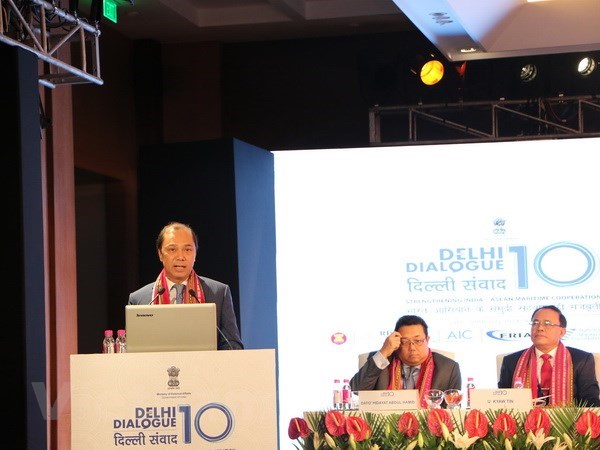 Vietnamese Deputy Minister of Foreign Affairs Nguyen Quoc Dung speaks at the 10th Delhi Dialogue Vietnamese Deputy Minister of Foreign Affairs Nguyen Quoc Dung highlighted the role of maritime connectivity between the Association of Southeast Asian Nations (ASEAN) and India at the 10th Delhi Dialogue on July 19. Addressing the event, Deputy FM Dung emphasised the long-standing maritime links between ASEAN member countries and India, as well as the role of maritime shipping routes through ASEAN and India in international trade. Maritime cooperation has offered opportunities and challenges for both sides, he said. Maritime connectivity is one of the key areas that the two sides need to take advantage of in order to strengthen their economic and trade cooperation, Dung said, proposing they spare no effort to conclude negotiations on the ASEAN-India maritime transportation agreement. ASEAN and India should strengthen and develop maritime infrastructure, said the Deputy FM, including hard infrastructure such as seaport systems, logistics and transport; and soft infrastructure like policies, rules, and regulations to connect the transport of goods and relevant services. He underlined the need to preserve the marine environment alongside economic development. The Deputy FM applauded the results of the second ASEAN-India seminar on blue marine economy, co-chaired by India and Vietnam, in New Delhi on July 18, following the first in Vietnam in November 2017. Dung and others from ASEAN member countries and India emphasised the need to maintain marine security and safety as a prerequisite for both sides to develop their maritime economies. He specified that countries involved need to ensure the principles on freedom of navigation and aviation, respect international law, including the 1982 UN Convention on the Law of the Sea (UNCLOS), while also strengthening cooperation to tackle transnational challenges such as pirates, human trafficking, and weapon and drug smuggling. The Delhi Dialogue is held annually to discuss measures to implement the ASEAN-India strategic partnership. The 2018 dialogue saw more than 200 delegates, including ministers, government officials, policymakers, scholars, business leaders, and organisation representatives from both sides. Governors of India’s northeastern states were also present at the event to promote relations between the region and ASEAN. The Delhi Dialogue focused discussions on a series of issues such as the role of India’s northeastern provinces in cooperation with ASEAN countries; ASEAN-India partnership and the role of marine cooperation in bilateral affiliation; and collaboration in trade, investment, technology, e-commerce, support for small- and medium-sized enterprises, tourism, and construction of smart cities. VNN |
↧
↧
Article 0
Thai Beverage vows to overhaul Sabeco following $5-billion takeover Thai Beverage drafts out various plans to revamp Sabeco, right after it takes up dominant roles at the latter’s management board today. 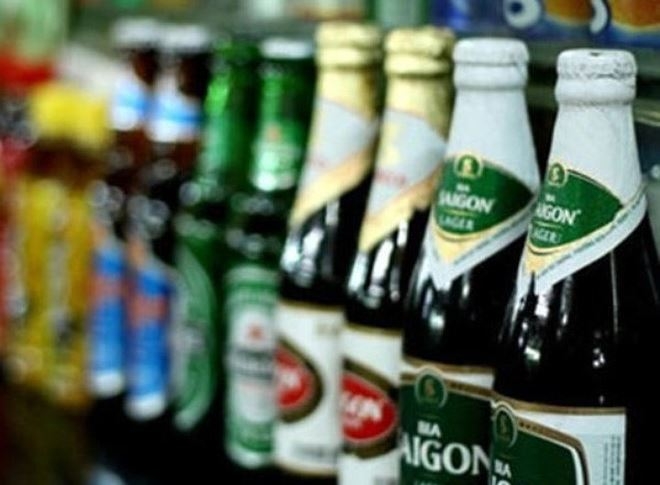 The 2018 general meeting of Sabeco this morning is a significant one, as it marked the debut of Thai Beverage as Sabeco’s controlling shareholder. As expected, four representatives from the Thai beer firm were elected to the seven-person board, and Koh Poh Tiong, who hails from the Singaporean affiliate F&N, was named Sabeco’s chairman. Vietnam’s Ministry of Industry and Trade (MoIT), who owns 36 per cent of shares, had two seats in the board. Lastly, Nguyen Tien Vy, deputy head of the Vietnam’s Beer – Alcohol – Beverage Association, became the only independent member in the board. According to chairman Koh Poh Tiong, Sabeco will focus on slashing expenses to improve its business efficiency. Vietnam’s top brewery will collaborate closely with Thai Beverage to reduce material costs, as well as devising plans to trim logistics fees. The Thai investor will also restructure Sabeco’s complex web of subsidiaries and affiliates, which amount to 36 companies in total. “We will keep the Saigon Beer brand, as it is a national pride of Vietnamese people, and bring the brand to overseas markets via our region-wide distribution system,” said Koh. Thai Beverage previously garnered backlash in Vietnam as some accused the investor of “erasing Vietnam’s heritage beer brand”. At the meeting, Sabeco decided to scrap its foreign ownership limit, paving the way for the MoIT to divest its remaining stake there. There is no concrete timeline yet for the state divestment. In 2018, Sabeco aims to reach VND4 trillion ($174 million) of post-tax profits, down by 19 per cent from 2017 due to anticipated tax hikes. The dividend payout ratio is slated to remain the same at 35 per cent. As part of the revamping efforts by Thai Beverage, Sabeco will also replace its inspectorate committee with an internal auditing team, following in the footsteps of dairy giant Vinamilk. Koh Poh Tiong reckoned that this move will help Sabeco reach international standards of corporate governance. It is noteworthy at 18 per cent of Vinamilk is also owned by Thai Beverage, via its affiliate F&N. Michael Chye Hin Fah, another representative of Thai Beverage in Sabeco’s board, is concurrently a board member at Vinamilk. Last year, Thai Beverage noted that it would use F&N as the main tool for mergers and acquisitions within ASEAN. Following today’s meeting of Sabeco, Thai Beverage is now controlling two of Vietnam’s biggest food and beverage firms, an important milestone in its quest to take advantage of ASEAN’s rising consumption and growing middle class. VIR |
↧
Article 0
Social News 24/7 2,000 to get free screening for hepatitis B and C in HCM City 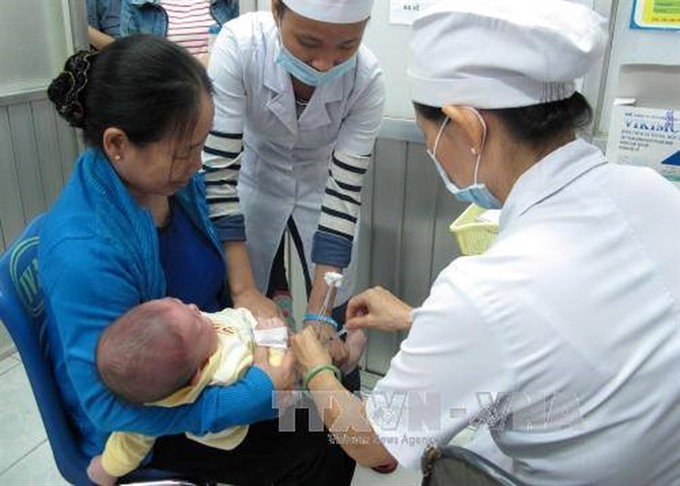 A baby being vaccinated at the HCM City Preventive Health Centre. A free screening for hepatitis B and C for nearly 2,000 people, half of them, disadvantaged, will be organised in HCM City on July 28. Gan Khỏe-Sống Vui (Healthy Liver- Live) Day is part of a programme called “Working Together to Eliminate Hepatitis B and C in Việt Nam” , held by the Việt Nam Viral Hepatitis Alliance, the Community Health Research Development Institute and the HCM City Open University. The event will be held to mark World Hepatitis Day, July 28. The screening will be held at the Independence Palace in District 1. The test results will be handed over in three to four hours. While waiting for the results, people can listen to health experts speaking about ways to prevent “hepatitis epidemics and the calamity of liver cancer” and mother-to-child transmission of hepatitis B during pregnancy. The experts will also tell them about healthy lifestyles and diets for a healthy liver. People who test positive for hepatitis will get vouchers for further testing while the rest will receive vouchers for hepatitis B vaccines. Registration for the free tests can be done at bit.ly/GKSV2018 and bit.ly/SNVG2018. Việt Nam Viral Hepatitis Alliance is an NGO that undertakes high-impact public health initiatives to deal decisively with hepatitis B and C. The HCM-based Community Health Research Development Institute belongs to the Việt Nam Union of Science and Technology Associations and researches community health and trains health officials. Dr Phan Thanh Hải, head of the institute, said: “The [campaign] is the first step in helping keep people’s liver healthy and prevent deadly diseases.” Dr Phạm Ngọc Đoan Trang of the Việt Nam Viral Hepatitis Alliance said that many people in the country do not know their hepatitis status. She cited World Health Organisation’s statistics released last year showing Việt Nam had 8 million people with hepatitis B and one million with hepatitis C. The two diseases are a leading cause of liver cancer in Việt Nam, she added. HCM City to build new bridge, canals in Thủ Thiêm New Urban Area 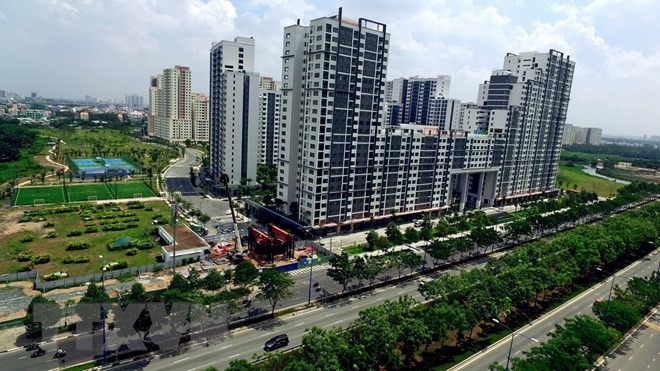 HCM City plans to build canals and a bridge, and upgrade roads to reduce traffic jams and flooding in and around the Thủ Thiêm New Urban Area. The authorities of HCM City plan to build major infrastructure to reduce traffic jams and flooding in and around the Thủ Thiêm New Urban Area in District 2, according to Nguyễn Thành Phong, chairman of the city’s People’s Committee. Nguyễn Phước Hưng, chairman of District 2’s People’s Committee, said that city authorities were allocating funds to build a North-South Canal on an area of 300 ha with total investment of more than VNĐ1.7 trillion (US$74 million), and to upgrade the Cá Trê Canal worth VNĐ163 billion (US$7 million). They also want to build a new Giồng Ông Tố 1 Bridge and upgrade Nguyễn Thị Định Street. To serve residents affected by construction in District 2, the HCM City People’s Committee has agreed to set aside 232 apartments in the R7, Thịnh Vượng, and Fideco Riverview apartment buildings as well as 81 land plots in the resettlement household zone of Rạch Chiếc and Cát Lái. Thủ Thiêm New Urban Area in District 2 is expected to be a modern residential and commercial, financial and service centre of HCM City. The ambitious project has involved relocating thousands of households, and a number of them have expressed discontent with the Government’s compensation or resettlement schemes, causing prolonged disputes and delaying the progress of the project. Covering a total area of 657 hectares, the Thủ Thiêm new urban area is located on a peninsula in HCM City’s District 2, which faces downtown District 1 across the Saigon River. The proposed financial district and mixed-use urban area of HCM City are set to become the largest inner-city development in Southeast Asia. The city spent more than 10 years to complete site clearance of most of the Thủ Thiêm peninsula, with as many as 15,000 households already resettled. Children with genetic facial defects receive surgical operations  As many as 40 children with genetic facial defects received surgical operations during a programme held in Vietnam’s central provinces from July 14-20. The programme was organised by a delegation of experts from the Republic of Korea’s (RoK) Chonbuk National University, and Hue University of Medicine and Pharmacy (Hue UMP) Hospital. It provided free oral and maxillofacial surgeries for 28 children out of the kids. Following the surgeries, the young patients received treatment at a centre for phonetic placement therapy at the Hue University Hospital. The programme also supported travel and food costs for the patients. On this occasion, doctors also offered medical checks-up for patients who received surgeries during last year’s programme. The Hue UMP and the Chunbok National University have enjoyed sound cooperation for more than 14 years, said Doctor Tran Tan Tai, head of the Faculty of Odonto-Stomatology at the Hue University Hospital. To date, the programme has treated more than 400 children with facial defects in Vietnam’s central region, with about 350 of them receiving free cleft lip surgeries. The programme also offers opportunities for doctors of Vietnam and the RoK to share their experiences and improve their skills, he added. In addition, the two universities have forged cooperation in many areas, including training and scientific research, grants for medical students, and admission of Hue UMP’s trainees to the RoK university, along with the establishment of a phonetic placement therapy centre for young patients, the first of its kind in the central and Central Highlands regions. Avocado harvest season celebrated in Dak Nong  The launching ceremony of the programme “Dak Nong: Ripe Avocado Season”. A programme themed “Dak Nong: Ripe Avocado Season”, the first of its kind, is underway in the Central Highlands province of Dak Nong to promote the province’s speciality among consumers, fruit processors and exporters. The programme, which takes place from July 18 – 23, features a variety of events, including a rite to celebrate the avocado harvest season, an avocado trade fair, a business matching event to connect buyers and suppliers, a workshop on the sustainable development of avocado farming and a contest to find the best avocados. The avocado harvest rite was held on the opening day with UNESCO representatives invited to join as guests. The host and visitors sang together while other family members played the gong and danced to welcome the guests. Offerings included the province’s specialities that are in season, namely avocado, rice and corn. The head of the ritual prayed to invite deities and ancestors to the festival and ask for good health and bumpy crops. The festival serves as a platform for avocado farmers, businesses and State agencies to meet, share experience and seek partnerships. It is also an opportunity for Dak Nong to introduce to the public the diversity of high-quality avocado varieties grown in the province in accordance with international standards and food safety requirements. Speaking at the event, Vice Chairman of the provincial People’s Committee Ton Thi Ngoc Hanh said Dak Nong’s plan to make avocado a local staple has received big support from other cities and provinces and some foreign countries. She expected that this year’s “Dak Nong: Ripe Avocado Season” will mark a promising start for the sustainable growth of avocado in the province. Dak Nong is one of the provinces with the biggest avocado farming areas and output in Vietnam. It is currently home to nearly 2,600ha of avocado trees, accounting for some 20 percent of the local fruit cultivating area, with an average output of 10-15 tonnes per ha. Avocado farming is particularly concentrated in Dak Mil, Dak R’lap, Dak Song, and Dak Glong districts and Gia Nghia town. With its terrain, climate and soil conditions different from those of other provinces, Dak Nong is able to plant many avocado varieties bearing fruit from January through to November. Local avocados are also preferred by domestic and foreign consumers thanks to their large size, appealing appearance and rich nutrition, the official noted. Social credit programmes help ethnic minorities escape from poverty 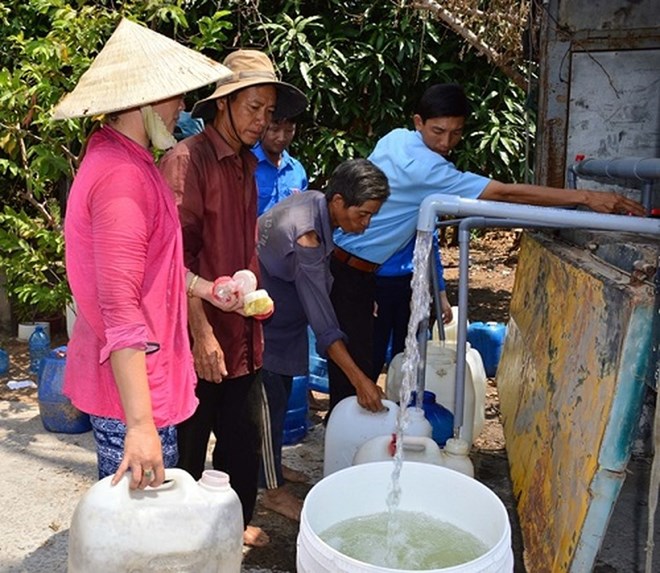 The Vietnam Bank for Social Policies (VBSP) is expected to poor households in Tra Vinh with clean water and environmental hygiene, especially in rural areas Social credit programmes have helped ethnic minorities in the Mekong Delta province of Tra Vinh escape poverty in recent years. According to the Vietnam Bank for Social Policies (VBSP), as of June 30 this year, Thuan Hoa commune in Tra Vinh’s Cau Ngang district carried out 11 preferential credit programmes with loans worth 25 billion VND (1.1 million USD). A total of 825 ethnic minority households were provided loans of 12.5 billion VND (546,475 USD), accounting for 76 percent of borrowers. Tra Vinh is home to the Kinh, Khmer and Hoa ethnic groups. It has a population of 1.1 million with 274,425 households, including 88,289 Khmer households (over 32 percent). Total loans from credit programmes were estimated at nearly 2.2 trillion VND as of June 30, a year-on-year rise of 5.52 percent, fulfilling 94 percent of the annual target. Some 126,865 poor and nearly-poor households and social policy beneficiaries were provided with average loans of 17 million VND each. Chairman of the provincial People’s Committee Dong Van Lam proposed the VBSP arrange more loans in the remaining months of the year for households living under the poverty line and support them with clean water and environmental hygiene, especially in rural areas. In response, a bank representative said the VBSP allocated an additional 40 billion VND (1.7 million USD) for Tra Vinh to provide loans for needy households. Front sends relief to flood-hit Yen Bai 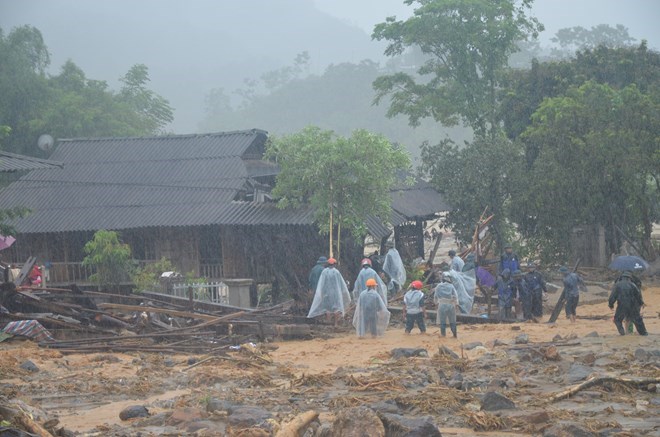 Search and rescue forces are making all efforts to address the impacts of floods in the hardest-hit district of Van Chan, Yen Bai province. The Vietnam Fatherland Front (VFF) has provided 1 billion VND (44,000 USD) in financial relief for the northern mountainous province of Yen Bai, which was severely hit by floods over the past few days. Vice Chairman and Secretary General of the VFF Central Committee Hau A Lenh visited the province on July 22 to hand the donation to the local administration. Lenh extended his sympathies over the losses of the province and praised local authorities’ efforts to cope with the heavy rains and floods. He asked the provincial administration to promptly repair damaged roads in isolated communes, intensify searches for missing people and evacuate households living in areas prone to landslides to safety. Firstly, the province needs to ensure social security for affected people, the official said. Chairman of the provincial People’s Committee Do Duc Duy expressed his thanks for the support from the VFF Central Committee, affirming that the province will allocate the donation to people in need without delay. Duy also updated Lenh on the flood situation in Yen Bai, particularly the hardest-hit district of Van Chan, the local operation to search for and rescue missing people and reconstruction efforts. On the same day, the VFF Central Committee leader visited Luong Son commune in Van Chan district to inspect the situation there. He called at three severely-affected families in Tu, Muoi and Tanh Hanh villages in the commune and presented them with aid. As of July 22, Van Chan district had three out of five communes isolated due to road damage and interruptions in electricity supply and communication access. All efforts are being made to access these communes to provide support for people there. Typhoon Son Tinh, the third in the East Sea this year, brought downpours and floods that ravaged the northern and north-central parts of the country last week. The floods wreaked havoc in Yen Bai, resulting in heavy casualties and property damage. As of 16:00 of July 22, the floods have claimed 11 lives, injured 11 and left six others missing in the province. About 4,170 houses have been damaged, including 119 pulled down or washed away and more than 3,350 others submerged in floodwater. More than 690 local households have been moved to safer places. In addition, more than 2,100 hectares of crops have been destroyed and nearly 1,260 head of livestock and poultry and some 198 hectares of aquatic farming lost. A total of 422 road sections and bridges have been crumbled or been swept away. Total economic losses were estimated at 200 billion VND (8.7 million USD). One July 21, the VFFCC Standing Board announced a decision to send 5 million VND (220 USD) in aid to each family of the bereaved and missing, 3 million VND (30 USD) to each seriously injured person and 40 million VND (1,760 USD) to each family made homeless by the floods. According to Director of the National Centre for Hydro-meteorological Forecasting Hoang Duc Cuong, from July 23, extremely heavy rains are forecast in the northeastern region, mostly in Quang Ninh and Lang Son provinces, which will then spread to the whole northern region from July 24-27. Requiem held for martyrs in Tay Ninh 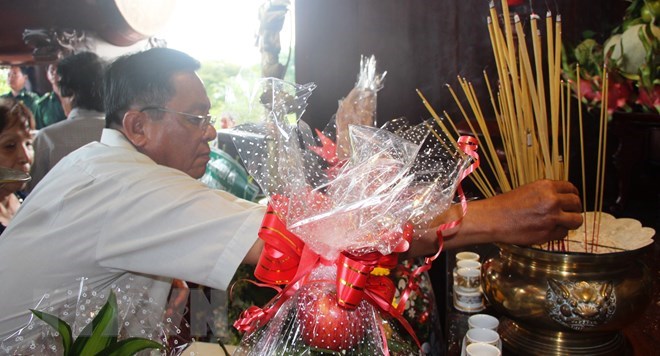 Incence offered at the requiem ceremony A ceremony took place in the southern province of Tay Ninh on July 22 to commemorate fallen soldiers at a martyr memorial site of the Ho Chi Minh City Youth Volunteers in Ben Cau district. Attending the ceremony were families of the martyrs and more than 300 former youth volunteers. In April 1977, the Khmer Rouge army began slaughtering Vietnamese across southwestern border provinces. Youths and public personnel from the outskirts of Ho Chi Minh City and nearby provinces volunteered to carry out logistics work and fight at the front. On that battlefield, 99 volunteers sacrificed their life. The Ho Chi Minh City Youth Volunteer Force decided to designate July 22 as the death anniversary of its members. Speaking at this year’s requiem in Tay Ninh, secretary of the force’s central committee Nguyen Huu Phong expressed his pride of his predecessors’ traditions. The younger generation is willing to build on such traditions, contributing to fulfilling socio-economic missions detailed by the Party and Government, he said. Southern localities report bumper summer-autumn crop The summer-autumn rice crop in southern localities has yielded a good harvest, heard a conference held in the Mekong Delta province of Tay Ninh on July 20. Reports from Departments of Agriculture and Rural Development in the south showed that the region planted 1.69 million hectares of rice, and expected an average yield of 5.63 tonnes per hectare. Total output was estimated at 9.51 million tonnes, up 279,700 tonnes from the same time last year. The Mekong Delta, the country’s rice granary, grew 1.59 million hectares, down 12,600 hectares from last year’s crop while total yield was reckoned at 9.03 million tonnes, 251,700 tonnes higher than the previous summer-autumn crop. Meanwhile, rice output in southeastern provinces was approximated at 480,000 tonnes, up 28,000 tonnes from the same crop last year. The results were spurred by cooperation among the Ministry of Agriculture and Rural development’s Department of Crop Production and Department of Irrigation, and provincial Departments of Agriculture and Rural Development in guiding local farmers to cultivate rice crops at proper times and to prevent damage caused by abnormal weather. High-quality varieties were chosen for plantation, of which fragrant rice accounted for 22.41 percent. Local exporters won a line-up of contracts, freeing farmers from worrying about rice consumption. Each kilogramme of rice was sold at an average 5,500-5,700 VND. As farmers have just harvested a third of the crop, they should pay due attention to protecting their crops from diseases, experts advised. In the autumn-winter crop, the southern provinces plan to cultivate 978,000 hectares of rice and expects a yield of 5.1 million tonnes of the grain. Deputy Minister of Agriculture and Rural Development Le Quoc Doanh said Mekong Delta provinces should consider proper time for rice cultivation as an early flood season has been forecast. Fragrant rice should be prioritised to bring high productivity, he added. On the occasion, the Mekong Delta Rice Research Institute inked cooperation deals with agricultural cooperatives in seven Mekong Delta provinces, under which they will join hands to produce high-quality rice varieties. Quảng Ngãi tightens control of illegal fishing 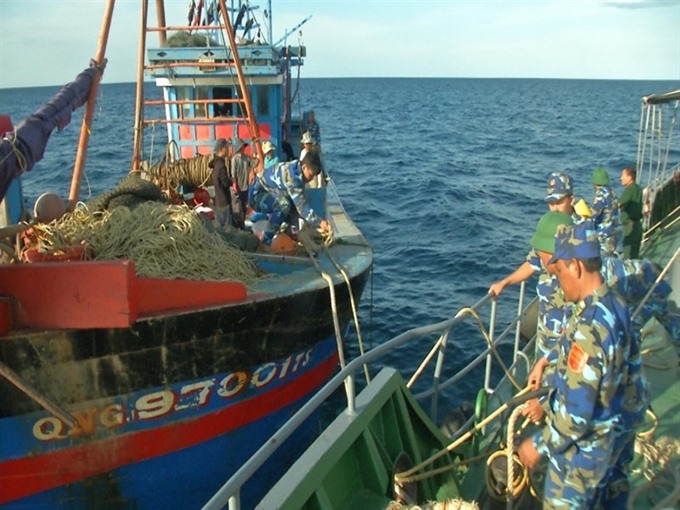 Border soldiers detects a fishing boat from central Quảng Ngãi Province using bottom strawling method to catch fish near Quảng Trị’s sea area. - Photo plo.vn Environmentalists have warned of the overexploitation of the country’s fisheries stocks, but fishermen are continuing to use electrical impulses and mines while ignoring heavy sanctions. Border posts in Quảng Ngãi Province have received recent reports from fishermen about people using explosives to catch seafood. This illegal method is depleting fish stocks and affecting the lives of legitimate fishermen. Huỳnh Thanh Ký, a local fisherman, told Việt Nam News Agency that he heard explosions every morning while he was fishing. “This method allows them to catch more fish than the traditional method. The fish are killed by the explosion, but many honest fishermen witness are scared to do anything for fear of reprisals,” he said. “Authorities should take stricter measures to save our fisheries.” Heavy trawlers also operate in the area, dragging along the sea bed and catching everything in their path. They operate inshore, scooping up fish of all sizes and destroying fishing nets belonging to other fishermen. Ngô Dũng, a fisherman from Mộ Đức District’ Đức Lợi Commune, said that he had spent VNĐ40 million (US$17,390) on new fishing gear since the beginning of the year because the old equipment had been destroyed by trawlers. “I had to borrow money from relatives and the bank to buy new gear. The whole year’s earnings is not enough to pay for it,” Dũng said. Bottom trawling is a particularly destructive method of fishing. High-capacity trawlers pose a grave threat to fish and other sea creatures during the breeding season, he said. Local border posts have been implementing measures to prevent illegal fishing methods. Lieutenant Colonel Lê Thành Trung, head of Mộ Đức District’s Đức Minh border post, said they had co-ordinated with other forces to patrol and detect fishing vessels using illegal fishing methods as well as people supplying explosives to fishermen. He said alongside an educational campaign and stricter punishments, support policies for offshore fishing vessels should be encouraged. On Monday, Quảng Ngãi City People’s Committee, in collaboration with the provincial Fisheries Department, organised a workshop to raise awareness on the Law on Fisheries to fishermen in Nghĩa Phú Commune. - VNS Bến Tre rice farmers switch to other crops 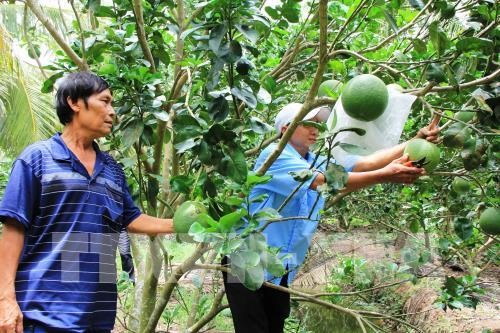 Farmers harvest green-skin and pink-flesh grapefruits in Bến Tre Province. More rice farmers in the Cửu Long (Mekong) Delta province of Bến Tre have been growing other crops on low-yield rice fields and breeding aquatic species and animals that offer higher profit. Lê Văn Hòa in Giồng Trôm District’s Phong Mỹ Commune is hiring people to plant coconuts and citrus fruits on his 1.2ha rice field. He has decided to switch to growing coconuts and citrus fruits because his rice field lost all harvested rive in 2016 due to severe saltwater intrusion, and had a poor harvest last year. Inclement weather and high production costs for planting rice have caused many local rice farmers to turn to other crops. Bến Tre, a coastal province, is normally affected by saltwater intrusion in the dry season. Nguyễn Văn Hiệp, who formerly planted rice on his 6,000 sq.m of land in Giồng Trôm District’s Châu Bình Commune, now plants coconut, grapefruit and grass for feeding oxen. He now earns a profit of VNĐ100 million (US$4,400) a year, higher than from rice. Previously, he planted two rice crops a year and had a poor rice yield, he said. Hiệp’s farmland, which is located in low-lying area, is often inundated in the rainy season and is affected by saltwater intrusion in the dry season. Đinh Thị Thanh Nhanh, head of the Giồng Trôm District Agriculture and Rural Development Bureau, said the district’s rice area had fallen from more than 4,000ha to 2,200 ha over the last five years. The converted rice fields with crops such as coconut, green skin and pink flesh grapefruit and vegetables provide higher profits than rice, according to Nhanh. Local authorities have encouraged farmers to turn low-yield rice fields along rivers, islets and alluvial grounds to breed aquatic species. Bến Tre farmers converted more than 7,500ha of low-yield rice fields to other crops and have bred aquatic species and animals in 2015-17, according to the province’s People’s Committee. The conversion has helped increase yield from VNĐ51 million per hectare in 2013 to VNĐ80 million per hectare last year. Nguyễn Hữu Lập, deputy chairman of the People’s Committee, said Bến Tre is one of the delta’s localities hardest hit by climate change. The province is focusing on developing specialised farming areas to adapt to climate change. In salt- and brackish-water areas, the province will develop intensive- and semi-intensive shrimp farming and models of breeding shrimps in submerged forests and in rice fields. In freshwater areas, the province will develop specialised farming areas for fruits and coconuts, the province’s key crops. The province is the country’s largest coconut producer. Bến Tre plans to convert about 6,000ha of low-yield rice fields in high-lying areas and saltwater-affected areas to other crops, aquaculture or breeding animals from now to 2020. Doctors at district hospitals provide assistance to ward, commune stations  Doctors at Chợ Rẫy Hospital’s emergency department treat a patient. All 23 hospitals in HCM City’s districts this year will have enough doctors who can take turns providing technical assistance to medical staff at health stations in communes and wards, according to the city’s Department of Health. Speaking at a meeting yesterday to review health sector activities of the first six months of the year, Dr Nguyễn Tấn Bỉnh, the department’s director, said the aim was to raise trust among local residents in wards and communes. Doctors at local health stations would receive assistance from doctors at district-level hospitals, he said. This would improve the quality of primary health services at grassroots-level health facilities, which has been required by the Ministry of Health. Each year, Phạm Ngọc Thạch University of Medicine provides 600 doctors for the city’s health sector, which has helped to reduce the doctor shortage. The city aims to have at least two doctors working at each health station by 2020. Currently, only half of the city’s total 319 health stations have two doctors. According to Bỉnh, the department has instructed leaders at city-level hospitals to send doctors to outlying districts of Bình Chánh and Cần Giờ to improve the quality of healthcare services there. For example, Củ Chi District Hospital in outlying Củ Chi District has received assistance since 2016 and, as a result, has been able to attract more patients. The city’s health department has set up kiosks at hospitals where people can comment or complain via special software about health check-ups and treatment quality. The complaints and opinions are sent to hospitals’ leaders and the Department of Health for consideration. Nguyễn Thị Thoa, deputy head of the department’s medical affairs division, said the kiosk system had been set up at 53 public hospitals. “After receiving complaints and opinions through the system, many hospitals have upgraded facilities, added human resources, changed procedures in health examination and treatment, and improved service attitudes,” Thoa said. Toilets at hospitals, for example, had become cleaner, she said. IT application The health department will also continue applying IT as part of its management and administrative reform. It is using software to provide guidance in financial autonomy for public hospital directors, and help leaders manage their budgets. The department is also using IT to count the number of patients and manage human resources. In December, it is expected to issue an application that will allow residents to search for health facilities best suited for their illness. Many hospitals, health stations and health centres have set up their own website containing information about health issues. The websites can also be found through the department’s web portal. Efforts from enterprise needed to promote gender equality 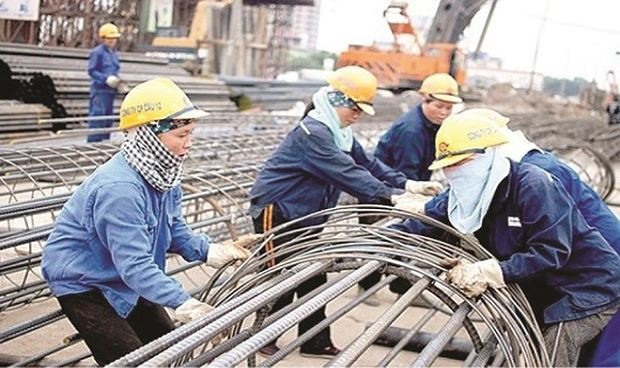 A study by International Labour Organisation (ILO) said that female workers are 2.4 times more susceptible to unemployment risks than their male counterparts.—Photo dantri.com.vn Public policies and especially enterprise polices are crucial to support gender equality in the workplace, experts said at the forum ‘Promoting Gender Equality in the Digital Age and Integration’ held in Hà Nội by the Ministry of Labour-Invalids and Social Affairs (MOLISA) on Wednesday. According to the figures in a study by International Labour Organisation (ILO) presented at the forum, female workers are 2.4 times more susceptible to unemployment risks than their male counterparts. Females also receive salaries 12 per cent lower than males. Risks can be defined as being replaced by machines and automation, said Đào Quang Vinh, Director of the Institute of Labour Science and Social Affairs. Nguyễn Thị Hà, Deputy Minister of MOLISA explained the reason for this is female workers’ low expertise, lack of managing skills, limited access to knowledge and social prejudice against women. Delegates at the forum agreed that to fight gender inequality in the workplace and unemployment risks, enterprises need to invest in workers’ job training, as well as supporting female workers. The study by ILO which focuses on five sectors including automotive and auto parts; electrical and electronics; textiles, clothing and footwear; business outsourcing and retail shows that in the next ten years, 70 per cent of wage workers are at high risk of unemployment, 18 per cent at medium risk and 12 per cent at low risk. Despite the challenges, there are positive figures to consider. Việt Nam was the quickest country to bridge gender inequality in the past 20 years. According to UNDP’s Human Development Reports 2016, Việt Nam’s Gender Inequality Index places 71 out of 188 countries and Gender Development Index comes in the first out of five groups. Besides, 70 per cent of females are in the workforce, 31.6 per cent of which are business owners. Experts in the forum note that Industry 4.0 will have a radical effect, and this could be a chance for females to earn employment, which help to promote gender equality. Industry 4.0 will bring chances for female entrepreneurs, giving them more opportunities to access technology and social justice, stated Doctor Dương Kim Anh, Deputy Manager of Việt Nam’s Women Academy. Special TV show to celebrate War Invalids and Martyrs' Day 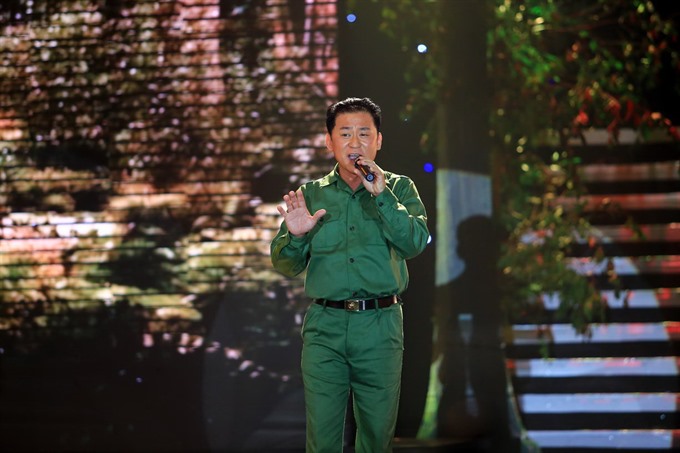 Meritorious artist Tạ Minh Tâm will perform revolutionary songs by veteran composer Phạm Minh Tuấn at Khát Vọng Mùa Xuân (Aspiration Spring), a special music show on Hồ Chí Minh Television to celebrate the 71st anniversary of the War Invalids and Martyrs Day on July 27. — Photo courtesy of the producer Hồ Chí Minh Television (HTV), in co-operation with its partners, will broadcast a special music programme this week to mark the 71st annual War Invalids and Martyrs’ Day on July 27. The 90-minute show, Khát Vọng Mùa Xuân (Aspiration of Spring), will feature revolutionary and patriotic songs by composer Phạm Minh Tuấn, former deputy director of the HCM City Music Conservatory. The show will include dozens of young and veteran singers, dancers and musicians from professional art troupes, including the HCM City Ballet Symphony Orchestra and Opera (HBSO) and Ngày Mới ( New Day) Choir. Meritorious Artist Tạ Minh Tâm and opera singer Anh Bằng will be featured. There will be performances in praise of the country, its history and traditional culture. Featured songs will be those recognised as canons of revolutionary music, including Bài Ca Người Nữ Tự Vệ (Song of Female Guerrilla) written in 1958, Bài Ca Không Quên (Forever Song) in 1981 and Đất Nước (Country) in 1984. Veteran singer Tâm will sing along with artists of HBSO the new version of Đất Nước, a work on patriotism composed by Tuấn with lyrics by poet Tạ Hữu Yên. Pop songs about youth and love, such as Khát Vọng (Aspiration) and Lối Nhỏ Vào Đời (Pathway to Life), will be performed by young singers Tiêu Châu Như Quỳnh and Yên Nhiên, with support from the Sen Việt Dance Group. The event’s highlights include Mùa Xuân Từ Những Giếng Dầu (Spring on Offshore-Oil Rigs), a popular song about the country’s development and workers released in 1984. Tuấn wrote the song after a fact-finding tour in 1981 to Vietsovpetro, a joint Vietnamese-Russian oil and gas enterprise in Bà Rịa-Vũng Tàu Province. He joined the National Liberation Front of South Việt Nam in 1960. He studied at the Việt Nam Music School and HCM City Music Conservatory, and was deputy general chairman of the Việt Nam Musicians’ Association. Tuấn has composed more than 100 songs, and dozens of music works for theatre and films. He has released six albums featuring patriotic music, and has worked as a music lecturer for the HCM City Music Conservatory and art schools. The show, Khát Vọng Mùa Xuân, will air at 9pm on July 27 on HTV 9 channel. VNN |
↧
Article 0
Money gained from trans-national gambling ring to be seized from Vietcombank An investigation into a multi-trillion dong gambling ring organised in Vietnam has entered the second phase, with illegal money due to be seized from Vietcombank and three Vietcombank employees under investigation. 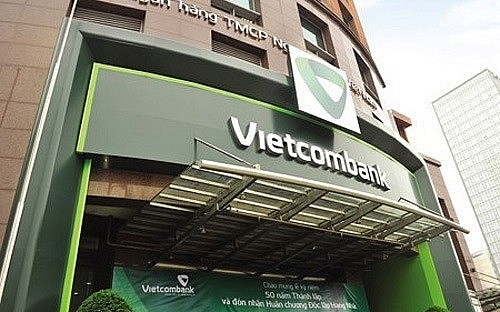 The conclusion of the investigation carried out by an agency deployed by Phu Tho Police has disclosed the names of numerous firms involved in the gambling ring, including Vietcombank, that was reported to have earned VND140 million ($6,184). Based on Article 47 of the 2015 Criminal Code on the confiscation of money and items directly related to a crime, the investigation agency proposed to seize the money that Vietcombank had gained from the online gambling ring after subtracting the amount already remitted into the state budget. The agency will continue to investigate, ascertain and handle three Vietcombank employees in the second phase of the case: Nguyen Phuc Tuan (born 1981), manager of card services business division, who directly signed a contract connecting payment for RikVip/Tip.Club; Dinh Manh Quan (1990), card services business division staff member; and Dinh Tuan Dong (1991), card services business division staff member. Another 33 banks who issued ATM cards and provided money transfer services for the gambling ring will also be investigated and handled in line with regulations of the law in the next phase of the case. The investigation agency concluded that money circulated in the ring through e-payment portals and agents. Of these, VND9.583 trillion ($422.2 million) was charged for such e-payment portals as VNPT Epay (earned VND8.94 trillion, equivalent to $393.8 million), Homedirect (benefited VND53.22 billion, equalling $2.34 million), Nganluong (gained VND481 million, equivalent to $21,200) and GTS (earning the remainder). All the money has been seized, with VNPT Epay able to explain some reasonable costs and reduce the amount of seized money to nearly VND51 billion ($2.25 million). Phu Tho Police has prosecuted a total of 105 defendants involved in the ring for the seven charges of illegal gambling; organising gambling or running gambling dens; dealing in illegal invoices and receipts for payment of state revenue; laundering money and/or property obtained through the commission of crime; giving bribes; appropriation of property using a computer network, telecommunications network; and abuse of power or position in performance of official duties. The agency has suspended the investigation of the 13 defendants, and 12 wanted suspects. The gambling ring on the web portals Rikvip/Tip.club has established a large network of 25 "tier 1 agencies" and nearly 5,900 "tier 2 agencies" with nearly 43 million user accounts since it launched in mid-2015. The illegal ring was found to have generated a total income of over VND9.8 trillion ($426 million) and profit of VND4.7 trillion. Out of this profit, the ring leaders received nearly VND1.5 trillion and over VND1.6 trillion each while a group of wanted suspects earned VND1.574 trillion between them. VIR |
↧
Article 3
BUSINESS NEWS IN BRIEF 26/7 Vietnam’s exports witness motivation for greater growth  Vietnam will see great momentum for stronger export growth in the second half of 2018, with its export-import turnover estimated to reach the 500 billion USD benchmark by 2019. The prediction was given by experts during a workshop held by the Vietnam Chamber of Commerce and Industry (VCCI) in Ho Chi Minh City on July 20. According to Nguyen Viet Hung from the General Department of Vietnam Customs (GDC), Vietnam’s import-export value reached 225 billion UDS in the first half of 2018, up nearly 13 percent year-on-year. The country’s export turnover increased by 16.3 percent year-on-year to nearly 114.2 billion USD in the reviewed period. Meanwhile, it spent 110.8 billion USD on importing goods, up by 9.6 percent. The country enjoyed a trade surplus of 3.4 billion USD in the first two quarters. Statistics from the GDC show that Vietnam’s exports structure in 2018 is almost unchanged compared to 2017, with key exports being phones and electronic components; textiles and garments; and footwear and handbags. Foreign-invested enterprises continue to be the main driver of Vietnam’s export growth for the year. According to the Ministry of Industry and Trade, domestic businesses reported a 19.9 percent rise in exports by shipping 33.07 billion USD worth of goods abroad in the first half of the year. Meanwhile, FDI enterprises earned 80.86 billion USD from exports, up 14.5 percent from the corresponding period last year. Vietnam exports goods to 200 countries and territories over the world, with 27 markets reaching an export turnover of over 1 billion USD, and the top 10 largest global markets accounting for 88 percent of the country’s export turnover. The US remained the biggest importer of Vietnamese commodities, followed by the EU, China, Japan, and the Republic of Korea. Hung said with the positive growth rate reported in the first half of the year – and taking into account that second half import-export growth is always forecast higher than the first half – Vietnam’s import-export turnover is likely to hit 475-477 billion USD, with a trade surplus of around 4.5-5 billion USD. Associate Prof. Dr. Tran Dinh Thien, Director of the Vietnam Institute of Economics, attributed to the positive situation to the growth momentum from 2017. The structure of Vietnam’s exports is shifting from exploitation sectors to processing and manufacturing industries, which can help improve the value of goods and sustain steady growth, he said. The increasingly fierce competition among big economies also creates opportunities for Vietnamese enterprises to access niche markets, thus further promoting exports, Thien added. However, VCCI Vice Chairman Doan Duy Khuong pointed out some of the difficulties facing the sector as the country’s export turnover is mainly contributed to by FDI firms, while the trade surplus remains low and unsustainable. Vietnamese exporters are mainly small- and medium-sized enterprises, which still cross difficulties in accessing policy and export market information regarding competitors and potential customers, Khuong said. To improve the export value and promote the involvement of Vietnamese firms in the import-export field, it is necessary to increase the quality and supply of market forecasting, as well as taking measures to solve challenges from the tariff policy changes of Vietnam’s key trade partners. Enterprises were advised to focus on improving their competitiveness through promoting technological application in production and being active in capturing market trends for sustainable development.-VNA Experts: Vietnam must work hard to meet export targets Vietnam’s exports of agricultural products are expected to face more challenges by the end of the year, so enterprises must follow market developments at home and abroad and improve the quality of their products, according to experts. Vu Tien Loc, Chairman of the Vietnam Chamber of Commerce and Industry (VCCI), said Vietnam’s exports of goods, especially agro, forestry and seafood products are facing a number of obstacles in major markets, including impacts from the US-China trade war and the European Union (EU)’s “yellow card” warning against fisheries exports. With the “yellow card”, all exported seafood products from Vietnam to the EU have had to be checked by the authorities of the importing country. That is a big barrier for Vietnamese products in one of the country’s major markets. Minister of Trade and Industry Tran Tuan Anh said there would be no small difficulties for Vietnam’s exports if the US-China trade war is prolonged. By the year end, Vietnam’s exports of goods are expected to face many challenges. Importing countries would further strengthen protection measures, food safety standards and environmental protection standards. Those would make it difficult for Vietnam’s exported products to enter those markets. Besides that, there is the US catfish inspection programme, Forest Law Enforcement, Governance and Trade (FLEGT) for wooden products and regulations on traceability in many import countries. Therefore, according to the Ministry of Industry and Trade, enterprises need to update market information and improve the quality of export goods, meeting strict regulations and standards in export markets. The ministry said the fisheries industry must work hard by January 1, 2019 to remove the yellow card. According to the Ministry of Agriculture and Rural Development, the national export value of agriculture, forestry and seafood products in the first six months of this year marked a year-on-year increase of 12 percent to reach 19.4 billion USD. Of this, the export value rose by 9.7 percent for agricultural products to reach 10.3 billion USD, by 10.5 percent for seafood products to 3.94 billion USD and by 12.7 percent for main forestry products to 4.33 billion USD compared to the same period last year. Other products that recorded high export growth in the first six months of the year included rice (up by 42 percent to 1.81 billion USD), vegetables and fruits (up by 20 percent to 2 billion USD), cashew nuts (up by 16.4 percent to 1.71 billion USD) and wood and wooden products (up by 12.1 percent to 4.1 billion USD). The US and China are the two largest export markets for Vietnam’s farm produce, especially vegetables and fruit, so the trade war between the two countries would have a big impact on such products in Vietnam. Experts in the agricultural sector said that under pressure from the US’ increase of import tariffs on Chinese exports, China’s agricultural products will have to find alternative markets. With great supply and cheap price, Chinese vegetables and fruits will continue to compete with Vietnamese versions. Meanwhile, to avoid China’s high import tariff at 25 percent for US agricultural products, the US is likely to promote export agricultural products to Vietnam, including fruit as well as meat of cattle and poultry. The General Department of Vietnam Customs said in May, US meat imports accounted for 37 percent of the total import meat volume to Vietnam, becoming the largest exporter of meat to Vietnam. The US exported 11,000 tonnes to Vietnam in May, worth more than 13 million USD, a month-on-month increase of 50 percent in value. Seminar talks sustainable avocado farming in Dak Nong The People’s Committee of the Central Highlands province of Dak Nong held a scientific seminar on sustainable avocado farming in Gia Nghia township on July 20, as part of the “Dak Nong: Ripe Avocado Season” programme. Representatives from SAM Agritech Co., Minh Hung Co., and Western Highlands Agro-Forestry Scientific and Technical Institute joined experts from New Zealand in sharing their experiences and solutions in improving the value of avocados. Delegates introduced several kinds of popular avocado; farming techniques; harvest, preservation, and processing methods; avocado-sourced food and cosmetics production; and consumption of avocado products. Emmet Mcelhatton, Business Development Manager of New Zealand Trade and Enterprises, said local farmers should pay further attention to land and variety management to ensure the best quality avocados for domestic consumption or for export. At the event, representatives from SAM Agritech Co., the New Zealand Agency for International Development, and the New Zealand Plant and Food Research Institute signed an agreement on avocado farming in the province. According to the provincial Department of Agriculture and Rural Development, weather and soil conditions in Dak Nong are highly suitable for avocado farming. The province is home to nearly 2,600ha of avocado trees with an output of 10-15 tonnes per ha. The local avocado cultivation area and output has increased in recent years. The fruit is expected to help farmers improve their income sustainably. Binh Duong calls for investment in port, wharf construction The southern province of Binh Duong has called for more investment for the construction of a provincial wharf which will help to facilitate operations in local industrial and processing zones, said Chairman of the provincial People’s Committee Tran Thanh Liem. More than 2 trillion VND (88 million USD) is needed to develop the province’s port and wharf system from now until 2025, he added. Binh Duong is striving to start the construction of its port and wharf system in order to meet the transport demands of more than 8 million tonnes of freight and over 3 million passengers by 2020. The province is due to complete the system after 2025, with a goal to handle over 40 million tonnes of goods and serve 8 million passengers by 2030, while water transportation accounts for 15 percent of the province’s transport demand. Accordingly, Binh Duong plans to develop several container ports on the Saigon River – namely An Son, An Tay, Rach Bap, Phu Cuong Thinh, and Thanh An – along with Tan Van, Thai Hoa, Thanh Phuoc and Thuong Tan ports on Dong Nai river. By 2020, the capacity of An Son port on the Saigon river will be raised to 2.5 million tonnes per ha. Meanwhile, An Tay port will be built on an area of 15ha and be capable of receiving vessels up to 3,000 tonnes by 2030. Tan Van port is set to become a logistics centre on Dong Nai river before 2020 and Thai Hoa port will be built as a centre for the supply of components and materials for the province’ industrial parks. In addition, Thuong Tan port will facilitate the transport of mining material to other localities. Those ports are expected to receive ships weighing in at 2,000 tonnes. Relevant agencies of Binh Duong are working on the revision and classification of the current local port and wharf system to devise suitable investment plans in line with the province’s socio-economic development. Made-in-Vietnam desalination equipment shipped to Saudi Arabia Doosan Heavy Industries Vietnam Co.’s (Doosan Vina) first batch of seawater desalination equipment left Dung Quat port for Saudi Arabia on July 19. This is part of the 430 million USD Shoaiba-4 Seawater Reserve Osmosis (SWRO) desalination project, inked between Doosan Vina and Saudi Arabia’s Saline Water Conversion Co. (SWCC). Under the deal, Doosan Vina and Doosan’s subsidiaries will produce some 1,727 tonnes of desalination equipment for the project. The first batch with 566 tonnes of equipment is expected to dock at Saudi Arabia in the next three weeks. The following three shipments are scheduled for August, September, and December. The Shoaiba-4 project will meet the potable water requirements of Saudi Arabia’s second largest city, Jaddah, with a population of 5 million people. Once the Shoaiba-4 water plant becomes operational, it will produce 400,000 cubic metres of fresh water per day, or 146 billion litres of drinking water per year, which is equivalent to 58,400 Olympic swimming pools. The four phases of the desalination facility will have a combined capacity of over 400 trillion litres of water per year. Shoaiba-4 is the first of many major WWRO desalination projects to be built in Saudi Arabia following the reorganisation of the country’s water sector in 2016. National Single Window mechanism proves effective The implementation of the National Single Window (NSW) and ASEAN Single Window (ASW) customs mechanisms has produced positive results, facilitating trade development in Vietnam, said Deputy Finance Minister Vu Thi Mai at a press conference on July 19. According to Mai, as of June 10, 11 ministries and sectors have connected to the NSW since it was launched in November 2014. As a result, 53 administrative procedures involving nearly 1.26 million documents of 22,000 enterprises have been handled through this mechanism. By the end of this year, an additional 143 administrative procedures will be carried out through the mechanism, raising the total to 196, equivalent to 78 percent of the 251 procedures expected to be implemented by 2020, she added. Regarding specialised inspections on imports and exports, Nguyen Cong Binh, deputy head of the Customs of Vietnam, said the customs sector has coordinated with relevant ministries and sectors to step up reform of modes of specialised inspections and management, and reviewed legal regulations on these works to detect shortcomings. Deputy Minister Mai stated that the implementation of the NSW and reform of specialised inspections have created confidence and resolve in leaders at all levels. They are aware of the need to hasten reform and apply new management technologies with international standards while making policies and institutions, she noted. The business community has welcomed the change in Government agencies, and hoped that the Government will speed up the expansion of the implementation of the NSW mechanism and reform of specialised inspections. Vietnam’s international organisations and development partners such as the World Bank, the European Union, the US, Japan and the Republic of Korea have acknowledged the Government’s reforms, she added. The official said that a national conference on boosting the NSW and ASW customs mechanisms will be held on July 24. Bao Viet tops Vietnam insurance market The Bao Viet Group ranked first among the insurance companies in Vietnam with a revenue of more than 9.9 trillion VND (nearly 423.7 million USD) in the first half of 2018. According to the Vietnam Insurance Association, the firm’s revenue from new insurance contracts in the said period of time reached 2.42 trillion VND (105.7 million USD). The total revenue of the 18 life insurance firms operating in Vietnam hit 36 trillion VND (1.57 billion USD) in the first six months of this year, while their insurance premiums from new contracts reached 12.5 trillion VND (546.3 million USD), up 128 percent and 125 percent, respectively, against the same period last year. The top five insurance market leaders are Bao Viet, Daiichi, Prudential, Manulife and AIA. With the positive revenue growth, representatives of many businesses are optimistic about the development of the life insurance sector in Vietnam. They said that Vietnamese people are becoming more aware of the role of life insurance in preventing risks and protecting their lives. SOEs divestment lags behind schedule 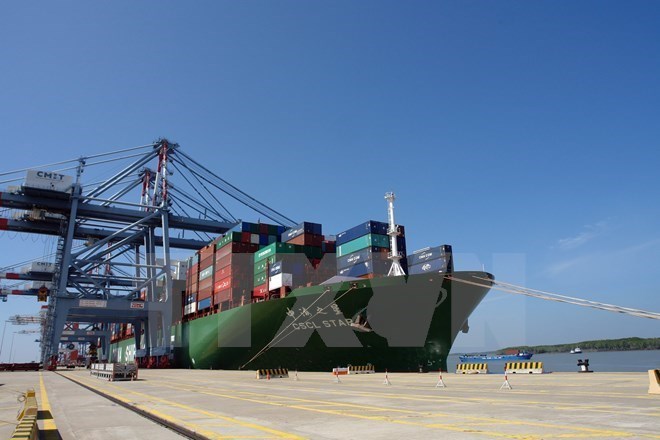 The equitisation plans of eight State-owned enterprises (SOE) were approved in the first half of 2018, with a total value of 29.37 trillion VND (1.29 billion USD), including more than 15.16 trillion VND (667.04 million USD) of State capital, the Ministry of Finance has reported. The ministry further revealed that per the schedule agreed by Prime Minister Nguyen Xuan Phuc, at least 85 enterprises must complete their equitisation in 2018. In the first six months of this year, SMEs divested 2.5 trillion VND (110 million USD), withdrawing more than 6.45 trillion VND (283.8 million USD). The PM had asked for the divestment of 135 SOEs in 2017 and 181 in 2018. However, only five companies completed the work in the first six months of 2018, bringing the total enterprises to have divested to 16 so far. Deputy Minister of Finance Huynh Quang Hai said the progress of SOE’s equitisation and divestment has remained slow. The ministry said the reason for this was ineffective implementation of the PM’s directions, while problems in finance, land and labourers also hindered the work. At the same time, despite the issuance of solutions for the problems, the implementation of the solutions remained inefficient, especially in land-related issues. The ministry said that to promote the process of equitisation, divestment and restructuring of SOEs, in the rest of the year, agencies should review relevant laws such as the Law on Enterprises, the Law on Management and Use of State Capital Invested in Production and Business at Enterprises, the Law on Public Servants and the Law on Bankruptcy. Meanwhile, ministries and sectors should design mechanisms and policies to submit to the Government and Prime Minister, including a decree on operations of SOEs, a decree on the rights and responsibilities of State capital owner representatives, and another on the production and supply of public products and services. The ministry highlighted the need for owner representatives in enterprises subjected to equitisation and divestment in 2018-2020 to complete the plan on schedule. Enterprises which are unlikely to finish the work on time should report their difficulties to the Government. It also requested SOEs review land under their management to build land use plans in accordance with the Land Law and submit the plans to State management agencies before equitisation. Da Nang tourism makes spectacular leap in past decade 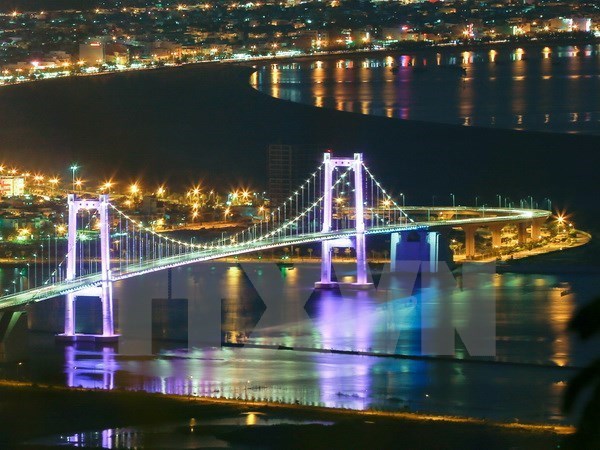 Da Nang city has made a “spectacular” leap forward in tourism development over the past decade, said Chairman of Da Nang Tourism Association Huynh Tan Vinh. Located between two famous destinations of the ancient imperial capital of Hue and the ancient port city of Hoi An, Da Nang used to be merely a transit point without any outstanding attractions. Deciding to make tourism a spearhead sector, the city has invested in infrastructure, adopted policies to attract investors and created its own events, such as the international fireworks festival and international sport tournaments. The efforts have paid off, with a three-fold increase in the number of visitors from 1.2 million in 2008 to 6.6 million in 2017 and a ten-fold rise in tourism revenues, from 2 trillion VND in 2008 to nearly 20 trillion VND last year. Chairman of Da Nang Tourism Association Huynh Tan Vinh noted that in the past decade, hotel rooms in the central city have increased 10 fold to over 28,800, with the arrival of big brands like InterContinental Danang Sun Peninsula Resort, Novotel, Hyatt Regency Danang Resort and Spa, Vinpearl and Pullman. According to deputy director of the municipal Department of Tourism Tran Chi Cuong, the municipal People’s Committee is implementing a tourism development project this year with a total cost of 14.4 billion VND (629,582 USD). The project aims to improve quality of services and develop various forms of tourism such as ecological tourism, village tourism and waterway tourism, he revealed. Statistics from the municipal Department of Tourism showed that the number of visitors to the city grew at an annual average rate of 20.06 percent in 2013-2017. Over the past decade, the central coastal city has also made it into many top-ten lists in the world. Da Nang was named in the top 10 holiday places in Asia of the prestigious online tourism magazine Smart Travel Asia and top 10 fresh destinations of the global online accommodation reservation provider Agoda in 2013. The listing has enabled the city to reach out further to the world, according to Amir Ahmad Mohamad, general manager of Hoang Anh Gia Lai Plaza Hotel Da Nang. Da Nang International Airport was ranked third among the best airports in the world in 2014, according to a survey by Dragon Air. The InterContinental Danang Sun Peninsula Resort won the Asia’s Leading Luxury Resort in 2014 thanks to its perfect combination of traditional beauty and modern, luxurious standards. The US’s Forbes Magazine selected My Khe Beach in Da Nang as one of the six most attractive beaches on the planet in 2013. The cable line that takes visitors to the peak of Ba Na Hills at an altitude of 1,487 metres in just 17 minutes and is able to carry 3,000 passengers per hour won four Guinness Records in 2013. The US’s New York Times listed Da Nang among 52 places to go in 2015. On the list of the world’s top 10 destinations for 2018 compiled by the online marketplace and hospitality service Airbnb, Da Nang was ranked fifth in booking surges of up to 255 percent. This year, the city was ranked the second most popular destination for solo or couple travellers, according to the Republic of Korea’s Ticket Monster Inc. The website said people who plan to travel abroad with family members often chose Da Nang. The RoK is expected to surpass Chinese tourists and become the biggest group of visitors to Da Nang in the near future. According to the Vietnam National Administration of Tourism, Da Nang was said to be the best place to live in Vietnam with many world-recognised records. More opportunities for poultry export to Japan Japanese consumers’ demand for Vietnamese processed chicken will open up more opportunities for Vietnam’s animal husbandry sector, according to experts. This year up to July 12, Koyu & Unitex Ltd Co. shipped 600 tonnes of the meat to Japan. Earlier in late 2017, it installed two additional processing lines to increase capacity and diversify products for export. Also, CP Vietnam Jsc and Leow Casing Vietnam Ltd Co submitted their export plans and asked the Ministry of Agriculture and Rural Development’s Department of Animal Health to negotiate with the Japanese Department of Animal Health on exporting processed chicken and hotdog cases made from lamb and pig guts to Japan. On May 14, the Japanese side sent a letter to the Vietnamese Department of Animal Health approving vet hygiene conditions and quarantine certificates for processed chicken meat and the hotdog cases. From May 27 – June 2, a delegation of Japanese Department of Animal Health took a fact-finding trip to Vietnamese processors whose products are destined for Japan. It also allowed Koyu & Unitek to expand exports of poultry meat and processed products to the country from June 15. It is considering CP Vietnam’s and Leow Casing’s applications. Besides chicken, Deputy head of the Vietnamese Department of Animal Health Dam Xuan Thanh said more support will also be given to pork manufacturing chains to prevent epidemics such as foot-and-mouth disease and hog cholera. The department will also promote trade and work with authorities of China, Hong Kong, the Republic of Korea, Australia, Russia, Mexico and Saudi Arabia to lift bans on importing animals and their products, he said. Workshop discusses HR skills required for industry 4.0 As technology advances relentlessly, senior human resources executives must not only have the skills to do their job but also need to develop the skills of the future, a workshop heard in HCM City last week. Nguyen Thi Quynh Phuong, director of executive search and selection at Talentnet, an HR consulting firm, said the top 10 skills that “talent acquisition” (TA) need to have in the industry 4.0 era include social selling with design thinking, recruiting with agility, situational judgement, commercial awareness, digital literacy-artificial intelligence, managing ethical dilemmas, data focus and storytelling, and market research and strategising. Nguyen Cao Tri, vice president, SMB and retail business at steel firm NS BlueScope, said commercial awareness and data focus and storytelling skills are important skills for TA. TA must tell candidates their company’s advantages compared to other companies to engage and inspire them to join. Talent acquisition is a process that encompasses mapping, scanning, recruiting, acquiring, getting people on board, and retaining skilled human resources and developing them. It is a long process and of course humans play a key role in recruiting and developing talent, but technology also plays a role in each stage of the process, he said. Tran Van Tho, tax partner at Parker Randall, said TA need to have a scientist’s skills to analyse data and understand more about their candidates so that they can appeal to and influence candidates by storytelling about their companies. Another important skill for TA is strategising, he said. TA or HR managers must understand their companies’ operations to identify a talent pool so that they can approach and sign up talented people when the company needs them, he said. LinkedIn other social networks, workshops and forums are sources for TA to search, network and build relationships with potential candidate communities to build a talent pool for their companies, he said. Many companies have invested in tools to map talent in the market, even follow their movements in the job market to approach them when needed, he said. Le Quang Dai, managing director of CLF (Duy Tan Group), said acquiring talent needs talent influencers/advisors’ skills. TA must understand thoroughly about the position they need to recruit for to counsel candidates so that the latter can make the right decision, he said. Delegates agreed that the development of technology has changed the way recruiting is done and TA must utilise new technologies in their job. They also agreed that co-ordination between HR and other divisions in an organisation is key to a company’s success. Phuong from Talentnet also spoke about global recruitment trends by sector, function and geography. The technology sector is expected to experience the strongest growth this year, followed by healthcare/life sciences, industry, financial services and retail, she said. The US and Asia are forecast to see the biggest recruitment growth this year, she said. The Association of Executive Search Consultants, which represents a vetted, exclusive class of executive search and leadership advisory firms world-wide, predicts that CEO/board of directors and IT director, finance director, sales director, and HR director are among functions forecast to experience the most demand growth this year, she said. Organised by Talentnet, the workshop titled “Talent Acquisition: Blend with business” was attended by more than 100 delegates, mostly HR executives. Lottery council wants a lot of tickets The Southern Lottery Council wants all 21 members to print VND100 billion (US$4.37 million) worth of tickets every week. To take advantage of growing demand, the council said its members – all public companies and at the rate of one per province or city – should continue to strive for a higher output. The members said they would try to reach VND90 billion per week by October 1 this year and VND100 billion by January 1. Their printing currently ranges from VND80 billion to VND90 billion worth of tickets. Ho Kinh Kha, director of the Tien Giang Province’s Department of Finance, said large companies should help smaller ones so that all of them sell the same number of tickets. Phan Thanh Son, an official from the Ministry of Finance, said his ministry was working on reforming the lottery market to improve its efficiency and enable growth. In the first half of this year the member companies’ revenues rose by 17.44 per cent. Their pre-tax profit rose by 12.05 per cent. Last year the Southern Lottery Council’s members contributed VND24 trillion in taxes and donated over VND205 billion to charitable causes like healthcare, scholarships and disaster aid and VND81 billion to build and repair houses for poor people. — VNS Digital transformation imperative for industry 4.0 “Digital transformation or losses?” was the thorny question for Minh Phu Seafood Company a few years ago. A leading fisheries exporter, it shipped its products to over 50 markets around the world, earning annual revenues of VND12 trillion (US$526,000). As orders grew rapidly, the company was finding it hard to accept all of them. “This … required us to increase our capacity by five-10 times,” CEO Le Van Quang said. However, increasing its 14,000-strong workforce by five to 10 times was impossible and this forced the company to explore alternative solutions. “For five years I went to many countries to study this issue and found that digital transformation was the best way for the company to survive and grow. It helps cut costs and improve efficiency.” The company decided to invest in digital transformation by acquiring advanced technologies like artificial intelligence (AI) and using them in raising and processing shrimps. Minh Phu is not the only Vietnamese company to embrace digital transformation in production. With the fourth industrial revolution taking root, digital transformation is an inevitable trend that companies around the world and in Viet Nam have to embrace sooner rather than later to remain in the race. It means the use of the internet of things (IoT), big data, cloud, and AI to enhance production efficiency. Prof Ho Tu Bao of the Viet Nam – Japan International Institute for Science of Technology said: “Digital transformation is not just a change related to using technology. It is a change related to the business culture. “Digital transformation is imperative. A company might fall in line sooner or later but they cannot avoid it.” Tran Van Huan, APAC digital advisor at Microsoft Vietnam, said: “It is time to achieve your next digital business transformation.” He quoted a report by IDC as saying that 70 per cent of manufacturers would embrace digital transformation by 2020. “In the digital era, the fast fish eats the slow fish,” he said, pointing to the success stories of Uber and Grab. Digital transformation would help companies increase their revenues by 30 per cent while cutting costs by 30 per cent, he said. A recent report by Microsoft showed that the GDP of the Asia Pacific including Viet Nam would grow by an additional 1 per cent every year if the region’s manufacturing sector embraces digital transformation. Digital transformation is obviously the way to go but not all companies in Viet Nam, over 90 per cent of them small and medium-sized enterprises (SMEs), are ready for it. There are many factors that prevent them from digitising, with cost, data security and human resources being the three main ones. Vu Kim Hanh, chairwoman of the High-quality Vietnamese Goods Business Association, said she has worked with many companies to study whether they are ready for digital transformation. “I found that companies worry about money. They are afraid they do not have the money to buy technologies, machinery and software. “They then worry about security and losing information and business secrets when using new technologies based on cloud or IoT.” Human resources is also a concern as companies need to train and retain people for long, she said. Lucky Gani, marketing and operation lead of Microsoft Vietnam, said three factors prevented companies from digitising: lack of skills and resources, cyber security and growing threats and a siloed and resistant culture. For Bao, the biggest hurdle to digital transformation for Vietnamese companies is that they do not understand digital infrastructure as well as other infrastructure. Furthermore, the country lacks a legal framework for a digital economy, he said. Lack of human resources is another problem, he added. Quang of Minh Phu Seafood, as an entrepreneur, saw a different problem. The biggest obstacle, he said, is the fact whether a company can recognise its problem. If it can, it will surely embrace digital transformation. However, there have been pioneers who went down the path of digital transformation and achieved fruitful results. Minh Phu is a clear example. Quang said in the early days he was worried about the cost of AI. He need not have, as it turned out. The investment in technology and AI has been completely worth it, he said. He cited one example. In the past the company needed several machines to assess the water quality in shrimp ponds by measuring PH, NH3, salt, and other, with each machine costing billions of dong. But thanks to AI, one machine now measures all parameters and precisely, and it cost just US$5,000. AI would also help cut the company’s workforce by 50-70 per cent in the next five or seven years, he said. “With digital transformation, with AI, all problems can be solved.” Quang said companies should embrace the trend of digital transformation and pioneers like him are ready to offer assistance and share their experience. Phuong Nam Yarntex Joint Stock Company is another success story in digital transformation. Speaking to Viet Nam News, the company’s director, Luong Vu Ngoc Duy, said he studied in a foreign country and returned to manage his family business a few years ago. When he came back the company’s data had been in a mess since his family had not cared to digitise it, he said. It took him six months to persuade his parents to invest $200,000 in technology. Technology and machines have helped the company link up and control information, he said. They provide the most efficient information on how to manage inputs and identify the right customers, Duy shared. "In the past the company had been run based on people’s experience and relationships. Now, with new technologies, the company takes advantage of both humans and machines to achieve better business results. "After it embraced digital transformation, the company’s revenues jumped by 80 per cent," he said. While there are many causes for this jump, digital transformation has been a major one, and his company would invest more in technology including AI, he said. HCM City push to semi-process produce The HCM City Department of Industry and Trade is pushing for semi-processing agricultural products in Lam Dong Province before transferring them to wholesale markets in an aim to reduce vegetable waste and save costs. Lam Dong was chosen as the first province for the project to encourage more washing, filtering and packaging of products. The three main wholesale markets, Binh Dien, Thu Duc and Hoc Mon, in HCM City receive about 9,200 tonnes of agricultural goods and discharge around 240 tonnes of waste. Ninety per cent of the waste comes from processing products. The three markets spend around VND2 billion (US$87,000) per month treating waste. Bui The, deputy director of the Department of Industry and Commerce in Lam Dong, said the province was instructing producers and traders to supply semi-processed products to HCM City as it could help save costs on waste treatment and frequent sterilisation of the wholesale market. The HCM City Department of Industry and Trade said that semi-processing of harvested goods would preserve them longer, meaning fewer crops would spoil via transport from the provinces to HCM City. Dr. Vo Mai, deputy chairwoman of the Viet Nam Horticulturists’ Association, said waste from agro-products and food after semi-processing could be used to produce organic fertilisers. Lam Dong Province and HCM City are working together on standardising semi-processing procedures that every farming household must follow. Bui The said that many businesses lacked the resources to process and package a large amount of harvested goods quickly. Currently, radishes and white radishes in Lam Dong are semi-processed before being transported to HCM City. More types of vegetables will go through a similar process in the future. Nguyen Huynh Trang, deputy director of HCM City Department of Industry and Trade, said that harvested vegetables should be processed and packaged to the same standards as vegetables sold in supermarkets. “Farmers and co-operatives need to be educated on this so that in the future, all agricultural produce is properly processed and packaged, with clear labels. HCM City wholesale markets should also only buy semi-processed goods,” she said. This policy is part of the city’s plan to develop agricultural brands, provide more high quality products with clear origins, and promote trade between HCM City and other provinces. Teleconference discusses national, ASEAN one-stop shop mechanism The Finance Ministry held a teleconference in Hanoi on July 24 to discuss developing national and ASEAN one-stop shop mechanisms and trade facilitation. Prime Minister Nguyen Xuan Phuc; Deputy Prime Minister Vuong Dinh Hue; as well as leaders of ministries, agencies, the Vietnam Chamber of Commerce and Industry (VCCI), and World Bank (WB) attended the event. Speaking at the event, Finance Minister Dinh Tien Dung said as of July 15, 11 ministries and agencies connected and conducted 53 administrative procedures with over 1.34 million files by 11,812 businesses via the national one-stop shop mechanism. All customs procedures have now connected with the mechanism, with 99.65 percent of firms joining. By the end of 2018, an additional 143 procedures will be launched on the mechanism, raising the total to 196, or 78 percent of the total 251 procedures which will be launched between now and 2020. Regarding the ASEAN one-stop shop mechanism, Dung said as of January 1, 2018, Vietnam officially exchanged form D certificates of origin (C/O) with Singapore, Malaysia, Indonesia, and Thailand. As of July 15, Vietnam received 32,949 certificates from the above countries while sending 14,214 ones to them. Vietnam is working with Brunei, Cambodia and the Philippines to establish a system to pilot the exchange of form D C/O, and is partnering with Thailand, Indonesia and Malaysia to launch a pilot system to exchange ASEAN customs declarations. Apart from the ASEAN, Vietnam is also negotiating to complete protocols and build a system to share information with the Eurasian Economic Union about customs declarations and C/O. VCCI Vice President Doan Duy Khuong said the business community wishes that the Government would further expand the scope of the national one-stop shop mechanism and make sweeping reforms on specialised inspection. Representatives of international organisations and development partners such as the WB, the European Union, the US, Japan, and the Republic of Korea spoke highly of the Vietnamese government’s reform in the field, hoping that with the help of technical support projects, Vietnam will soon join the global supply chain. A WB representative reported that the customs clearance for Vietnam’s exports at border gates was brought down from 58 hours to 55 hours last year, and from 62 hours to 56 hours for imports into Vietnam. The cost of customs clearance for a batch of goods at border gates was reduced by 19 USD. With over 11 customs declarations last year, businesses saved upwards of 200 million USD and over 16 million hours of storage for exports and more than 34 million hours for imports. According to the WB’s “Do Business” report for 2016-2017, Vietnam continued to be one of the four countries with the highest trans-border goods exchange in ASEAN. Deputy Minister of Industry and Trade Nguyen Quoc Khanh suggested improving the technological capacity and agreeing on the principles for specialised inspection among ministries and agencies. Director of the Central Institute for Economic Management Nguyen Dinh Cung called for reducing more goods subject to specialised inspection, saying that 4,000 kinds of goods exempt from specialised inspection in the next four years is a modest figure. According to him, half of the goods are currently subject to overlapping inspections by two or three ministries, or two or three agencies under a ministry, which, he said, should be changed soon. He requested that 350 legal documents should be revised soon, including circulars regarding unreasonable business costs. There should be a further step toward standardising and digitalising procedures in order to complete the e-government portal by 2020, he said, adding that it will be a strong breakthrough for the economy. First Son La longan week underway in Hanoi The northwestern mountainous province of Son La has been searching for a stable market for its fresh agricultural products during an event underway at Big C Thang Long supercenter in Hanoi until July 27, hoping to make longan its key farm produce. The first “Son La Longan and Safe Farm Produce Week” was opened by the provincial People’s Committee on July 21. The festival will display 20 kiosks featuring longan, as well as other fruits, vegetables, and processed food products of Son La. These include many VietGAP and GlobalGAP-certified products, namely the longan, mango, avocado, banana, luffa, red dragon fruit, cabbage, tomato, garlic, and green pea. Organisers also set up a special stall to introduce some off-season vegetables from the province’s Van Ho district, including cabbage, wild bean, chayote, tomato, and gourd. These products were grown under a programme “Support Farmers in Van Ho district, Son La province”, funded by the Australian Centre for International Agricultural Research and the Central Group Vietnam which looks to foster the development of off-season vegetable farming and improve the livelihood for smallholders in the northwestern mountainous region. Son La has maintained 15 safe longan farming areas, producing about 5,000 tonnes of longan certified by VietGAP annually. Of which, 1,500 tonnes are granted exportation codes to the United States, Australia, Japan, the Republic of Korea, and other ASEAN countries, said Vu Duc Thuan, Deputy Director of the provincial Department of Planning and Investment. Last year, the province had nine products granted Trademark Registration Certificates, including Song Ma longan, Son La coffee, Phu Yen orange, Yen Chau mango, Moc Chau Snow Shan tea, Moc Chau safe vegetables, Moc Chau oolong tea, Ta Xua tea, and Son La honey. In 2018, it plans to build trademarks for 12 more specialties like Mai Son sugar apple, Moc Chau avocado, Son Tra assam apple, Thuan Chau taro, Son La passion fruit, Son La plum, and Son La sturgeon. “Son La hopes that, through the Big C outlets, the certified farm produce of the province in general and its brand products in particular will be widely known in the country and abroad. The increases in production and consumption will help improve incomes and livelihoods for ethnic minority people in the locality,” Thuan noted. VNN |
↧
↧
Article 2
Social News 26/7 VFF President extends sympathy over Laos’ dam collapse 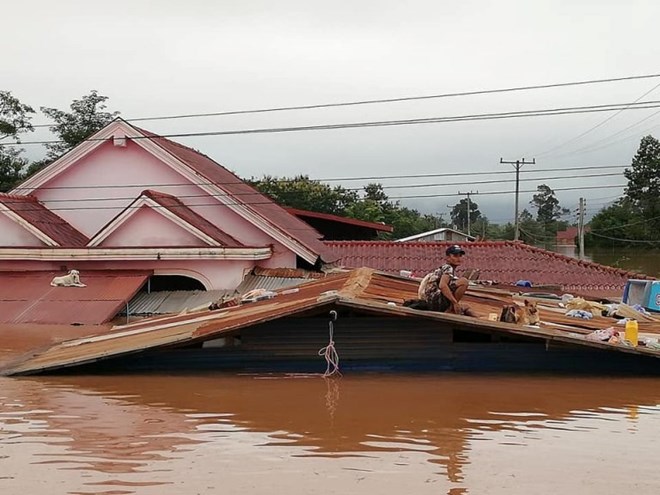 The collapse of the Xepian-Xe Nam Noy hydropower dam caused flash flooding in 10 villages in lower areas and completely isolated Sanamxay district. (Source: Attapeu Today) Tran Thanh Man, President of the Vietnam Fatherland Front (VFF) Central Committee, on July 25 sent a message of sympathy to President of the Lao Front for National Construction Central Committee Xaysomphone Phomvihane over the collapse of the Xepian-Xe Nam Noy hydropower dam in the Lao province of Attapeu on July 23. The Xepian-Xe Nam Noy hydropower dam burst at 20:00 on July 23, releasing 5 billion cu.m of water which caused flash flooding in 10 villages in lower areas and completely isolated Sanamxay district. Five out of Sanamxay district’s villages, namely May, Hinlath, NhaytheSanong Tay, Thasengchan and Thahin, were entirely submerged. The disaster has left at least 18 dead and about 200 people missing, and made over 1,300 families with 6,600 people homeless. The Xepian-Xe Nam Noy hydropower plant is being constructed by the XePian-XeNamnoy Power Company (PNPC). The PNPC is a joint venture between Republic of Korea’s SK E&C and Korea Western Power, Thailand’s Ratchaburi Electricity Generating Holding and Lao Holding Sate Enterprise. The project, estimated to cost 1.02 billion USD, is the first Build-Operate-Transfer (BOT) one to be undertaken by Korean companies in Laos. On July 24, Ratchaburi Electricity Generating Holding issued a press release announcing that unexpected heavy rains caused the dam to collapse. High volumes of rainwater fractured the dam and caused a deluge in the downstream area of Xe-Pian River, it said. HCM City association presents scholarships to disadvantaged students The Ho Chi Minh City Sponsoring Association for Poor Patients (SAPP) and benefactors on July 25 presented 1,382 scholarships worth over 1.5 billion VND (65,000 USD) to disadvantaged and disabled students with excellent academic performance in the country. Dr Tran Thanh Long, SAPP President, said this year’s scholarships are allocated for 13 localities nationwide, including Ho Chi Minh City, Gia Lai, Kon Tum, Dak Lak, Dak Nong, Tra Vinh, Long An, Ben Tre, Ninh Thuan, Khanh Hoa, Thua Thien-Hue, Ca Mau and Nghe An. The progamme benefits poor, orphan, disabled and ethnic students with good academic performance, helping them have more chances to pursue their study, he said. After 18 years, the programme granted more than 22,380 scholarships worth over 22 billion VND (956,500 USD) in total. As of October 2017, the association had raised over 1 trillion VND (46.46 million USD) from various social sources to help the poor. It sponsored more than 7,730 heart operations, 530,000 eye surgeries, 38,000 cleft lip/palate operations, 120 scoliosis operations as well as cancer screenings for more than 48,700 women. SAPP also provided 18,300 hearing aids for deaf children, 20,600 scholarships for poor students, 14,000 meal portions for hospitals, and nearly 146,000 health insurance cards to poor households. It built more than 700 charity houses and 100 bridges in rural areas. HCM City: Six-month budget revenue up 11.4 percent Ho Chi Minh City collected 130.55 trillion VND (5.62 billion USD) for the budget in the first half of 2018, up 11.37 percent from a year earlier, according to the municipal Department of Taxation. The six-month revenue, equivalent to 48.57 percent of this year’s plan, included 11.62 trillion VND (500 million USD) from crude oil, up 34.9 percent, and nearly 118.93 trillion VND (5.12 billion USD) from other domestic sources, up 9.5 percent. At a meeting on July 23, Chairman of the HCM City People’s Committee Nguyen Thanh Phong appreciated tax contribution by businesses, especially amid the fluid overall economic situation. He said the city has issued many solutions supporting production and business activities. More policies facilitating enterprises, particularly small- and medium-sized ones, will be devised in the time ahead. Additionally, municipal authorities will hold regular dialogues with business associations to remove bottlenecks and create the best possible conditions for their operations. General Director of the General Department of Taxation Bui Van Nam said despite an array of difficulties, businesses have expanded activities and contributed more and more tax to the State budget. They have also stood side by side with taxation agencies in carrying out tax policies and proposed many amendments to relevant policies. In 2017, HCM City Department of Taxation fulfilled the budget revenue plan with nearly 238.89 trillion VND (10.28 billion USD) collected, up 16.8 percent year on year, the department reported. Hau Giang works to develop postal service, information technology 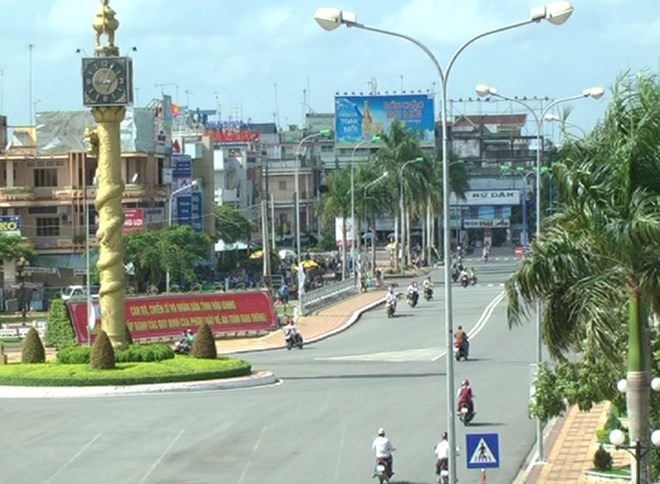 A street in Hau Giang province's Vi Thanh city (Source: vithanh.haugiang.gov.vn) The Mekong Delta province of Hau Giang plans to invest over 862.65 billion VND (37.3 million USD) in projects on postal service, telecommunications, and information technology development during the 2018-2020 period, according to a local official. Director of the provincial Department of Information and Communications Pham Van Tuu revealed the information during a conference to review and adjust the plan to improve the sector by 2020, with a vision towards 2030. Of the capital, more than 57 billion VND (2.47 million USD) will come from the province’s coffer, with the remaining sourced from social sources. The projects include those to develop human resources, service networks, advanced technology application, as well as to upgrade current service points and acquire new equipment. Meanwhile, other projects seek to enhance telecommunication infrastructure. By 2020, the province will have 140 postal service points in 100 localities, which will be able to serve more than 5,600 customers each. Hau Giang is also striving to improve the quality of its 3G/4G services, pushing to have about 80 percent of its residents with mobile phones and access to the Internet. By the end of 2017, the province was home to 118 postal service points, earning more than 20 billion VND. To date, the province’s portals and websites of agencies have provided around 2,000 online public services. Da Nang seeks development directions for hi-tech park 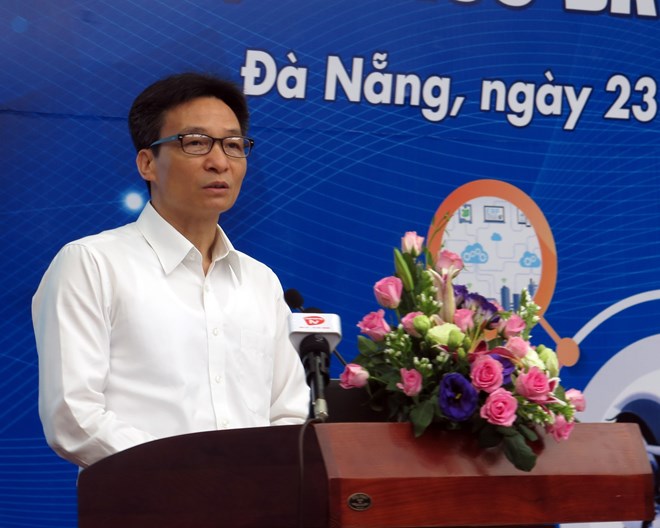 Deputy Prime Minister Vu Duc Dam speaks at the workshop in Da Nang on July 23 Experiences in building high-tech parks in Vietnam and other countries were shared at a workshop on July 23 with a view to seeking development orientation for the Da Nang Hi-tech Park in the central city of Da Nang. At the event, participants presented their experiences and ideas in building up the capacity for innovation and startup promotion in high-tech parks, the role of research and development in economic growth, and the role of innovation in reforming economic growth models. They also suggested plans to improve innovation and startups more specifically at the Da Nang Hi-tech Park. Deputy Prime Minister Vu Duc Dam said that in an era with rapidly developing science and technology, more reforms must be made to benefit from this global trend. Challenges and opportunities always come hand-in-hand, he added. It is necessary to capitalise on opportunities by developing IT and other IT-based sectors, along with high quality human resources. The Government hopes that the city will work closely with relevant ministries and agencies to soon propose concrete models and recommendations for the Da Nang Hi-tech Park so that more specific directions for the park’s development can be issued, he added. In the late 20th century, Da Nang built the Hoa Khanh Industrial Park to attract investment and boost economic development. Despite certain positive outcomes, this park is yet to have met the city’s expectations. To channel a stronger wave of technological innovation, the city decided to build its own high-tech park – the third of its kind in Vietnam, after those in Hanoi and Ho Chi Minh City. Chairman of the municipal People’s Committee Huynh Duc Tho said Da Nang considers investing in the high-tech park as a core factor and part of the momentum for its economy. New models and policies to improve the park’s innovation and startup support are being discussed, which will be reported to the Prime Minister in the third quarter of 2018. Established in 2010, the Da Nang Hi-tech Park covers nearly 1,130ha in Hoa Lien and Hoa Ninh communes of Hoa Vang district. It aims to create an optimal environment in terms of technical infrastructure and policies for domestic and foreign organisations, individuals, and businesses to research, develop, and apply high technologies; train high-tech human resources; and produce and supply high-tech services. Vietnam’s master plan on ASEAN Socio-Cultural Community 2025 updated 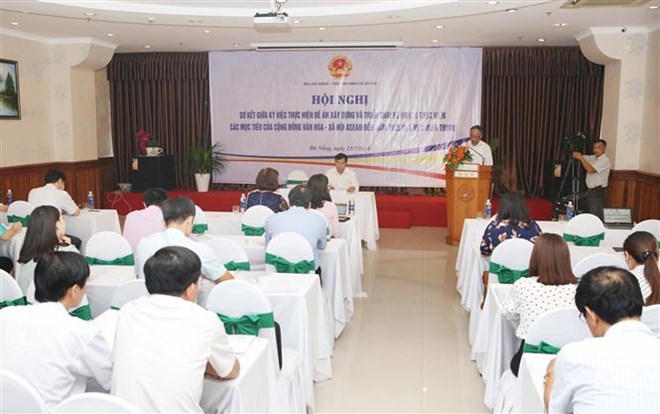 A mid-term review conference on Project 161 – which looks to implement and achieve the goals laid out by the ASEAN Socio-Cultural Community until 2025 – in the central region took place in Da Nang city on July 23 A mid-term review conference on Project 161 – which looks to implement and achieve the goals laid out by the ASEAN Socio-Cultural Community until 2025 – in the central region took place in Da Nang city on July 23. Speaking at the event, Deputy Minister of Labour, Invalids and Social Affairs Doan Mau Diep said the ASEAN Community was officially established on December 31, 2015 on the pillars of political-security, economic, and socio-cultural communities, marking an important milestone to lift ASEAN collaboration to a greater height and requiring member states to build a community of over 630 million people in an environment of peace, friendship, and mutual support and development. Towards achieving the ASEAN Vision 2025, the bloc has devised three master plans of the pillars, serving as a guide for their specialised agencies’ operations by 2025. Diep said the conference aimed to update the progress of carrying out the master plan on ASEAN Socio-Cultural Community 2025 at the regional level and Project 161 in Vietnam; ASEAN’s communications activities and a communications plan towards Vietnam’s ASEAN Chairmanship by 2020. It also discussed a mechanism to enhance cooperation among ministries, agencies, and localities in the implementation of Project 161. The outcomes of the review and recommendations to accelerate the progress of Project 161 will be submitted to the Prime Minister later this year. Ha Thi Minh Duc, deputy head of the Ministry of Labour, Invalids, and Social Affairs’ Department of International Cooperation, said nine out of 11 Vietnamese ministries and agencies, as part of the ASEAN Socio-Cultural Community, have outlined plans to realise the project. Up to 54 out of 63 cities and provinces nationwide have issued 2016-2020 action plans to conduct the project, and 39 out of 63 cities and provinces have submitted reports on the progress of the project thus far. She added that the national master plan on ASEAN Socio-Cultural Community aims to bring benefits to people in tandem with improving institutional capacity, reforming administrative procedures, and raising public awareness of ASEAN and the benefits it brings about. This will work towards extending policies on social welfare, labour, employment, health care, and support for the elderly, disabled, and other vulnerable groups. This year, the ASEAN Socio-Cultural Community gives priority to youth-based initiatives, including restoring the Singapore-ASEAN Youth Fund; introducing the ASEAN youth scholarship programme; strengthening commitment to coping with climate change; core values in understanding digitalisation; mitigating negative impacts of fake news; “Network of ASEAN smart cities” to improve living environment and livelihoods of people living in regional urban areas; and increasing opportunities for regional enterprises in a market of 630 million people. Deputy Director of the Da Nang Department of Labour, Invalids, and Social Affairs Nguyen Van An said the city has held periodic job fairs, offered free vocational training and consultancy, as well as assisted firms and households in site clearance. Last year, the municipal authorities visited and presented gifts to families of invalids and martyrs at a cost of over 100 billion VND (4.4 million USD), ensured regular allowances worth roughly 400 billion VND for nearly 22,000 policy beneficiaries, and repaired and upgraded martyrs’ tombs. The municipal Ho Chi Minh Communist Youth Union launched voluntary movements, youth and and music exchanges with ASEAN member states to popularise the image of Vietnam and Da Nang in particular. HCM City: youth camp promotes pride in national seas, islands 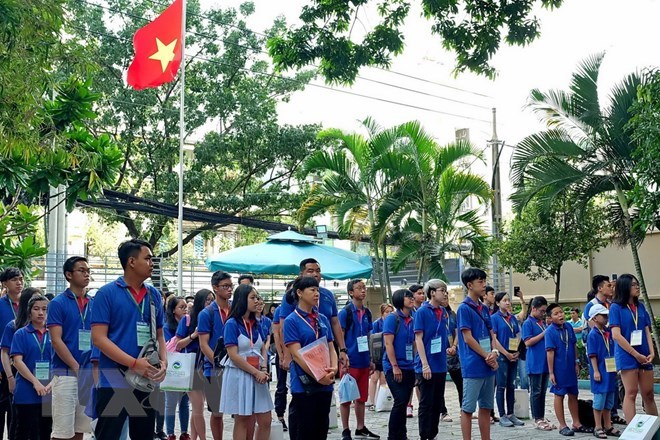 Sixty overseas Vietnamese from 10 foreign countries joined local youths in an annual youth camp themed “Proud of National Seas and Islands” in Ho Chi Minh City. Sixty overseas Vietnamese from 10 foreign countries joined local youths in an annual youth camp themed “Proud of National Seas and Islands” in Ho Chi Minh City on July 23. The event, co-organised by the municipal Committee for Overseas Vietnamese and the city’s Ho Chi Minh Communist Youth Union, will last until July 26. The programme features a visit to a children’s care centre in Go Vap district, a cooking class of Vietnamese food at the Saigontourist Hospitality College, and an exchange with personnel at the Submarine Brigade 189 under the Vietnam People's Navy. The youths are also scheduled to have a tour of the Nha Trang Oceanography Institute in the central province of Khanh Hoa. Overseas participants come from Cambodia, Laos, the US, Russia, Thailand, Malaysia, Germany, Ukraine, Canada, and Poland. Speaking at the opening ceremony, Phung Cong Dung, head of the municipal Committee for Overseas Vietnamese, expressed his delight over the growing number of Vietnamese who have lived and studied in other countries now returning back to their home country. He noted the camp offers an opportunity to connect Vietnamese expatriate communities from different corners of the world. Lueng Ylang, a Vietnamese Cambodian, said this is the third time she has taken part in the youth camp programme. She said she and her friends have visited famous destinations in Vietnam and participated in various social activities, and expect to gain some new friends who also share her Vietnamese diaspora identity after the camp this year. She noted the programme has helped to foster feelings of national pride that overseas youths have for their home country. Overseas Vietnamese in Macau commemorate day of martyrs, invalids 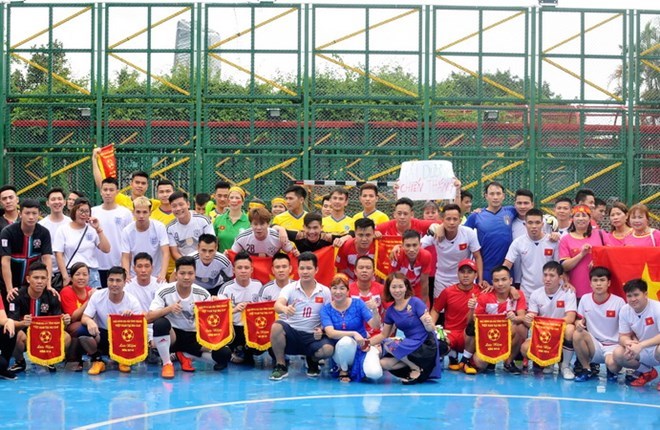 Participants of the football tournament pose for a photo together A football tournament for Vietnamese youths was held in Macau Special Administrative Region of China on July 22 to commemorate the Day of Martyrs and Invalids (July 27). The one-day event was organised by the Vietnamese Fellow Countrymen Friendship Association in Macau, with the support of the Vietnamese Consulate General in Hong Kong and Macau. Seven teams were divided into two groups, playing in a round-robin format. It was attended by representatives from agencies of Vietnam as well as Vietnamese people in Macau. Speaking at the event, President of the Vietnamese Fellow Countrymen Friendship Association in Macau Tran Thi Gon said the tournament aimed to encourage physical activities of young people and consolidate the unity of overseas Vietnamese people in Macau. A fundraising programme was held on the occasion to support families of war invalids and martyrs, of people who made contributions to the country and disadvantaged households. Established in 2013, the Vietnamese Fellow Countrymen Friendship Association in Macau now has about 2,000 members. Macau is home to more than 20,000 Vietnamese people. There are also several Vietnamese-run firms operating in tourism and services. Gold Star Order conferred to Alliance of Arts and Literature Associations 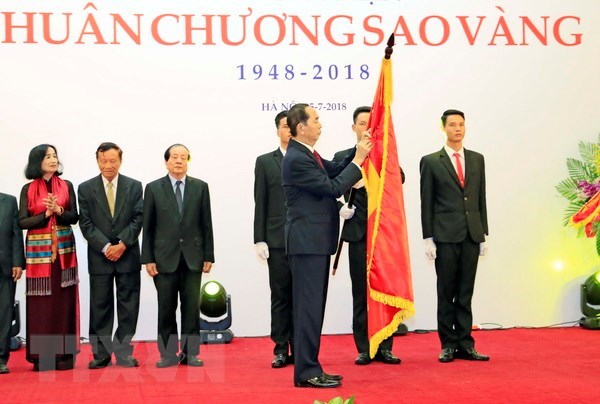 President Tran Dai Quang presents the Gold Star Order to the Alliance of Arts and Literature Associations of Vietnam The Gold Star Order, the highest decoration of Vietnam, was bestowed upon the Alliance of Arts and Literature Associations of Vietnam at a ceremony marking the alliance’s 70th anniversary in Hanoi on July 25. On behalf of the Party and State leaders, President Tran Dai Quang presented the order to the alliance in recognition of the enormous contributions to national development and security by writers and artists nationwide. In his speech, General Secretary of the Communist Party of Vietnam Nguyen Phu Trong said the Party and State have always encouraged and respected artistic creations by building specific mechanisms and policies to support literature, arts, and artists’ activities. They hope that writers and artists across the country will create many pieces of work which have high ideological and artistic value and that honestly, profoundly, and comprehensively reflect the state of the reform, integration, and development of the country. He noted that many new issues have emerged in this reform and integration period, which requests artists to reform themselves, remain steadfast, and approach new methods in their creation. They should follow daily life; embrace different aspects like agriculture, industry, business, and security and defence; and visit remote, ethnic minorities as well as some border and island areas to discover and reflect interesting issues and new problems while taking a responsible part in social tasks, especially the fight against corruption and negative phenomena. The Party leader also asked the Party committees and authorities at all levels to improve the awareness of the importance of literature and arts in national development and protection. They also need to provide the best possible conditions for literary and artistic activities by issuing favourable mechanisms and policies, providing financial support, opening creation camps and offering training to talents. The national arts and literature conference in Doc Phat village of Yen Ky commune, Ha Hoa district (Phu Tho province) on July 25-27, 1948, is considered the first congress of the revolutionary arts and literature organisation of Vietnam. It gathered artists from all strata and ethnic groups to call on them to join hands in performing revolutionary tasks. The organisation has changed its name three times and officially took the name the “Alliance of Arts and Literature Associations of Vietnam” in 1995. PM urges VGCL to accelerate trade union institution building 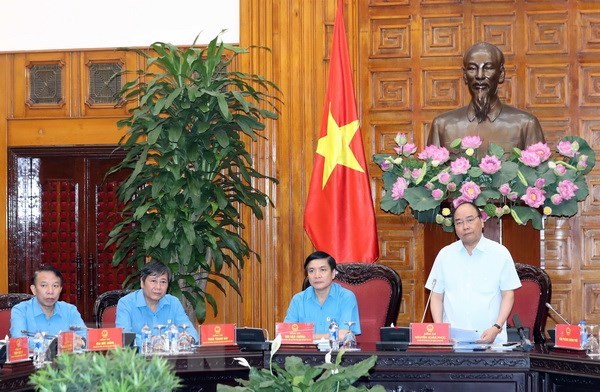 PM Nguyen Xuan Phuc speaks at the working session Prime Minister Nguyen Xuan Phuc has asked the Vietnam General Confederation of Labour (VGCL) to push forward the building of trade union institutions, especially those regarding housing for workers. The PM made the request at a working session between the Government and the VGCL in Hanoi on July 25 which reviewed the recent coordination between the two sides and set out orientations for future collaboration. He said all-level trade unions should continue to constructively participate in finalising institutions, step up administrative reform, and improve the efficiency of State management in employment and social affairs. PM Phuc emphasised the need to promote the development of the labour market, prevent workplace accidents, and care for the material and spiritual lives of its employees. All-level authorities and trade unions were also asked to improve their efficiency in settling pressing issues that relate directly to labourers. Reviewing the country’s socio-economic development in the first few months of 2018, PM Phuc attributed such achievements to great efforts made by the Party, army, and people – in particular, labourers and trade union officials across the country. Thanks to activities launched by the VGCL and its chapters, employees have supported the Party and Government’s changes in economic management and corruption prevention, he said. The PM, however, pointed out shortcomings regarding employees’ income, social insurance payment, housing, unemployment, late salary payment, and in particular workplace accidents, citing the nearly 9,000 cases with about 9,000 victims, including 928 deaths, in 2017. VGCL President Bui Van Cuong reported that in the past time, the agency has constructively participated in building institutions and gathering social feeback towards policies on labourers and trade unions, contributing to building a transparent, trusted Government that spurs growth and serves people and businesses. The Government, ministries, and agencies have paid due attention to the operation of trade unions, he said, recalling the dialogue between PM Phuc and nearly 2,000 workers in the central key economic zone, and another dialogue of the Government leader with close to 1,000 employees in industrial parks in the Red River Delta region in 2017 and the first six months of 2018. Following the dialogues, the PM dispatched a working group to the southern province of Dong Nai to inspect the implementation of policies towards labourers in the locality, he said. VNN |
↧
Article 1
New look for HN 10 years after expansion HÀ NỘI - Hà Nội has reportedly undergone considerable changes in its economic growth, appearance and infrastructure a decade on from administrative boundary expansions.
After merging with the whole neighbouring Hà Tây Province, Mê Linh district of Vĩnh Phúc Province and four communes of Lương Sơn district, Hoà Bình province in 2008, Ha Noi stretches over 3,328 sq.km, tripling the former acreage. - VNS Photo Đoàn Tùng The economic growth rate reaches 7.41 per cent each year on average during 2008-18. The gross regional domestic product (GRDP) per capita in 2017 was 2.3 times higher than 2008. The gross domestic product (GDP) per capita in 2017 reached US$3,910, twice as high compared to 2008. It was revealed by deputy director of the city’s Planning and Investment Department Vũ Duy Tuấn at a press conference on Tuesday to prepare for the 10th anniversary of Hà Nội’s administrative-boundary expansion. Additionally, the growth rate of the industrial sector usually stays stable at an average of 8.61 per cent each year. The sector’s revenue in 2017 reached $6.5 billion, 2.5 times higher than in 2008. The city welcomed 4.95 million overnight visitors in 2017, about 2.8 times higher than in 2008. Hà Nội was also listed among the world’s top 10 fastest growing tourism cities in 2017 by Mastercard Global Services. According to Tuấn, Hà Nội’s area only accounts 1 per cent of the total area of the country but the city contributes more than 19 per cent to the State budget. Aiming to build a modern capital city, Hà Nội has also focused efforts on creating new-style rural areas and gaining remarkable achievements, one of which is reducing the gap in living conditions between urban and rural areas. During the past decade, per capita income in rural areas increased threefold between 2008 and 2017, reaching VNĐ38 million a year in 2017. New appearance, improved infrastructure The capital now has a new and dynamic look as every metropolis in the world after ten years of growth. A number of new and modern urban areas have been constructed to serve a growing demand of city dwellers, including Mỹ Đình, Linh Đàm, Văn Quán, Việt Hưng, An Khánh, Ciputra, Times City, and Royal City. A series of modern and large-scale infrastructure projects have been completed during the period, including the elevated Belt Road No 3, the Nhật Tân – Nội Bài Highway, the extended National Road No 5, several new bridges across the Hồng (Red) River and seven flyovers in the city, contributing greatly to easing traffic congestion. The city plans to boost development to the north with the Kim Quy (Golden Turtle) Amusement Park, covering more than 100ha in Đông Anh District. The park is expected to reach global levels with an investment of thousands of billion of đồng; and the National Exhibition Centre in Đông Anh District, which is expected to become the Asia’s largest, and the world’s fifth largest, exhibition and fair complex when it opens. Challenges ahead Despite these major achievements, Hà Nội still faces several challenges such as reducing overload for inner-city hospitals, depopulation of inner districts and creating more jobs for unemployed people. Speaking at the press conference, Ngô Văn Quý, deputy chairman of the People’s Committee of Hà Nội, said improving the quality of hospitals in the suburbs was a way to reduce pressure at inner-city hospitals. In the meantime, dealing with issues like tap water and waste treatment in suburban districts were also the first steps to implement the plan to depopulate inner districts, he said. The city is scheduled to open three tap-water supply factories to ensure all suburban people have tap water by 2020. Connecting infrastructure from the city’s downtown to suburban districts would help boosting the depopulation plan, he added. To do that, the city would construct more radial roads linking the inner districts to the suburbs, he said. At present, the city hopes to create jobs for 152,000 people, reducing the unemployed rate to below 4 per cent in 2018. Quý said the city has focused on raising both quality and quantity of jobs. The expansion of administrative boundary carried out under the 12th National Assembly’s Resolution 15/2008/QH12 in 2008, was a historic event with long-term and comprehensive impacts and influence on the capital city’s political, economic and social situation. After merging with the whole neighbouring Hà Tây Province, Mê Linh district of Vĩnh Phúc Province and four communes of Lương Sơn District, Hoà Bình Province, the current Hà Nội stretching over 3,328 sq.km, tripling the former acreage. The city has 577 communes, districts and townships of 29 districts and towns. VNS |
↧
Article 0
HCM City bans trucks during rush hour in urban areas HCM CITY - The HCM City People’s Committee has issued regulations to ban trucks during rush hours in urban areas of the city in an effort to ease traffic congestion.
HCM City has banned trucks from roads during rush hours in many parts of the city. - VNA/VNS Photo Mạnh Linh From August 1, light trucks will not be allowed to enter the city’s urban area during peak hours from 6am to 9am and from 4pm to 10pm. Heavy trucks and container trucks will not be permitted to enter urban areas from 6am to 10pm The urban area is bounded by the following routes: National Highway No 1A, Hà Nội Highway, Đồng Văn Cống Street, Mai Chí Thọ Street and Nguyễn Văn Linh Street. The city’s People Committee, however, is considering granting licenses to allow certain vehicles to operate during these hours. These include rescue trucks, dump trucks, some vehicles such as trucks that need to do repair work on electrical equipment, and heavy trucks for key construction projects. In addition, light trucks and heavy trucks will be allowed to operate on ring roads without a time limit. The People’s Committee has authorised the city’s Department of Transport to issue the licenses. Under the regulation, individuals and organisations will be licensed within two days after the city’s Department of Transport receives their documents. Ads auction The city’s Department of Transport has approved an auction to seek bids for advertisements to be placed on city buses in a bid to raise revenue. As many as 1,590 buses on 79 bus routes are calling for bids for advertising. This is the third time the city has officially opened bidding for advertising on public buses. The auction will be divided into eight packages with expected advertising revenue of more than VNĐ177 billion ($7.6 million) a year. Bidders will cast bids directly at the auction, with a reserve price of 10 per cent of the starting price. The department’s Centre for Public Transport Management and Operations is in charge of organising the auction. Public buses in HCM City carry about 306 million passengers a year. Each year, the city traffic sector needs around VNĐ1 trillion ($43 million) in funds for bus subsidies. Due to a lack of revenue, transport firms have decreased their number of daily trips on many bus routes. VNS |
↧
Article 2
New approvals raise total FDI to US$23b Vietnam looks set to attract an estimated US$2.61 billion in foreign direct investment (FDI) this month, taking the total in the year to date to US$22.94 billion, up 4.6% year-on-year, according to the Foreign Investment Agency (FIA) under the Ministry of Planning and Investment. 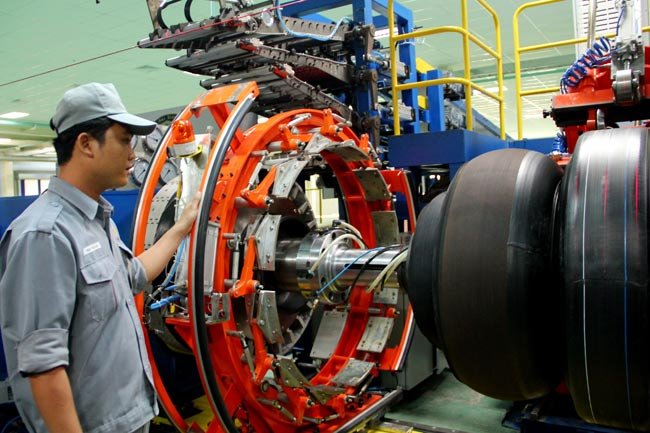 As of July 20, some 1,656 FDI projects had received investment certificates, with total registered capital reaching US$13.2 billion, up 2.2% over the year-ago period. This July witnesses a rebound of FDI capital year-on-year, while those of the January-June period were all lower than last year’s figures. During the same period, over 3,330 merger and acquisition deals were conducted by FDI investors to acquire local firms’ shares, worth nearly US$4.79 billion, rising 53.3% year-on-year. According to FIA, foreign investors had injected money into 17 sectors in the first seven months. Of these, the processing and manufacturing sector secured the top position in attracting overseas investment, worth US$9.63 billion, accounting for 41.95% of the country’s total. Meanwhile, the real estate sector ranked second, with the total investment capital hitting US$5.6 billion, making up 24.4% of the total, and the wholesale and retail sector came third, with the total registered capital reaching US$1.69 billion, accounting for 7.4%. Besides this, FDI firms simultaneously boasted robust growth in operations, particularly in terms of trade. In the January-July period, FDI firms earned US$95.13 billion from the export of various products including crude oil, up 14.6% year-on-year and accounting for nearly 71.2% of the nation's export revenue. Imports of the foreign investment sector reached US$76.46 billion, up 8.5% year-on-year and accounting for 58.5% of the nation’s total. In general, this sector achieved a trade surplus of US$18.67 billion when including crude oil and US$16.9 billion when excluding crude oil. As estimated by FIA, in the year to July 20, FDI projects had disbursed US$9.85 billion, rising 8.8% versus the year-ago period. From January to July, 96 countries and territories funded projects in Vietnam, of which Japan took the leading position with total registered capital of US$6.88 billion, accounting for around 30% of the country’s total. South Korea came second, with a total of US$2.73 billion, accounting for 11.9%. SGT |
↧
↧
Article 1
Illegal parking spaces should be temporarily permitted: experts More and more illegal parking spots for cars and motorbikes are springing up in central Hanoi, causing headaches for urban managers.
The illegal car parking spaces have not brought any money to the State budget but caused unsafe traffic and social security, according to Kinh Te & Do Thi (Economy & City) newspaper. With limited infrastructure facilities, some urban management experts suggested authorities consider granting temporary permits to the illegal car parking lots to bring more funding to the State budget and improve management, the paper reported. According to Ha Noi Police, the city has about 5 million motorbikes and more than 500,000 cars, not including 1.2 million vehicles travelling in and out the city regularly. Meanwhile, the land for static traffic works in the city has met only about 8-10 per cent of demand. Current legal car and motorbike parks can only accommodate 10 per cent of demand, according to the Ha Noi Department of Transport. This was one of the reasons for illegal parking spaces. Most illegal car parking spaces are located on empty land of empty construction sites, deserted agricultural land and on sidewalks, streets and residential areas. The huge income was not paid to the State budget or used for investing in infrastructure. These parking spots are also at risk of fires and theft, with vehicle owners often left with no recourse if a fire strikes or their property is stolen. Temporary measures Nguyen Thang Long, head of Dinh Cong Ward of Hoang Mai District said to wipe out the illegal car parking spots, the city had to build more underground and car parking buildings. “However, this could not be done overnight,” he told the paper. As a temporary measure, Long suggested the municipal authority consider granting permits. Some urban transport inspectors agreed with Long. The authority should grant 3- or 6-month permits to use empty land of awaiting construction areas and deserted agricultural land areas to set up car parking spots, they said. By doing so, the parking spots’ owners would be more responsible for traffic regulations and fire safety, they said. VNS |
↧
Article 0
Seafood exports likely to fall short of 10-billion USD targetHanoi – Vietnamese seafood companies need to work harder to realise the export target of 10 billion USD set by the Ministry of Agriculture and Rural Development (MARD) when oversea shipments in during January-July were estimated at only 4.66 billion USD.  Seafood exports likely to fall short of 10-billion USD target (Photo: VNA) The yearly growth rate of seafood export in the period this year, at 6.4 percent, was much lower than the same time last year, with 19.3 percent. According to Truong Dinh Hoe, General Secretary of the Vietnam Association of Seafood Exporters and Producers (VASEP), instability in the world market and oversupply of shrimp worldwide are the main causes of the dwindling growth. “Exports of seafood products are likely to fetch 9 billion USD, but 10 billion USD is a far cry. However, we are trying our best,” Hoe said. He noted that revenue from seafood exports in July was less than 700 million USD, adding that however, the season for export are in the last months of the year, and if export value can maintain an increase of 100 million USD each month, Vietnam will pocket 9 billion USD from seafood exports by the end of this year. As shrimp, tra fish, and tuna are the largest contributors to the nation’s export revenue, a fall in shipment of one of the three products will affect results of the whole sector. Statistics from VASEP showed that shrimp exports in the second quarter of the year fell 4.9 percent to 893 million USD due to fluctuations in both domestic and foreign shrimp prices. However, thanks to a robust growth of 20 percent in the first quarter, total export for the first half of the year still showed a slight increase of 5.1 percent to 1.6 billion USD. With shrimp demand expected to rise in the second half, Vietnamese shrimp exports are forecast to reach some 4 billion USD. In contrast to the rough seas faced by shrimps, tra fish export revenue grew nearly 20 percent from the same time last year to over 1 billion USD in the first six months. Strongest growth was seen in the Chinese market (46.7 percent with more than 251 million USD), followed by the EU (16.2 percent, 117 million USD), and the US (11.6 percent, 197 million USD). Tuna exports during January-June also picked up 12 percent to nearly 303 million USD. Shipments to Israel are expected to increase while those to the EU will have favourable conditions as both sides are concluding the negotiations of free trade agreement. However, exports to the US will face challenges due to fierce competition, and falling demands. VNA |
↧
Article 2
↧
More Pages to Explore .....
